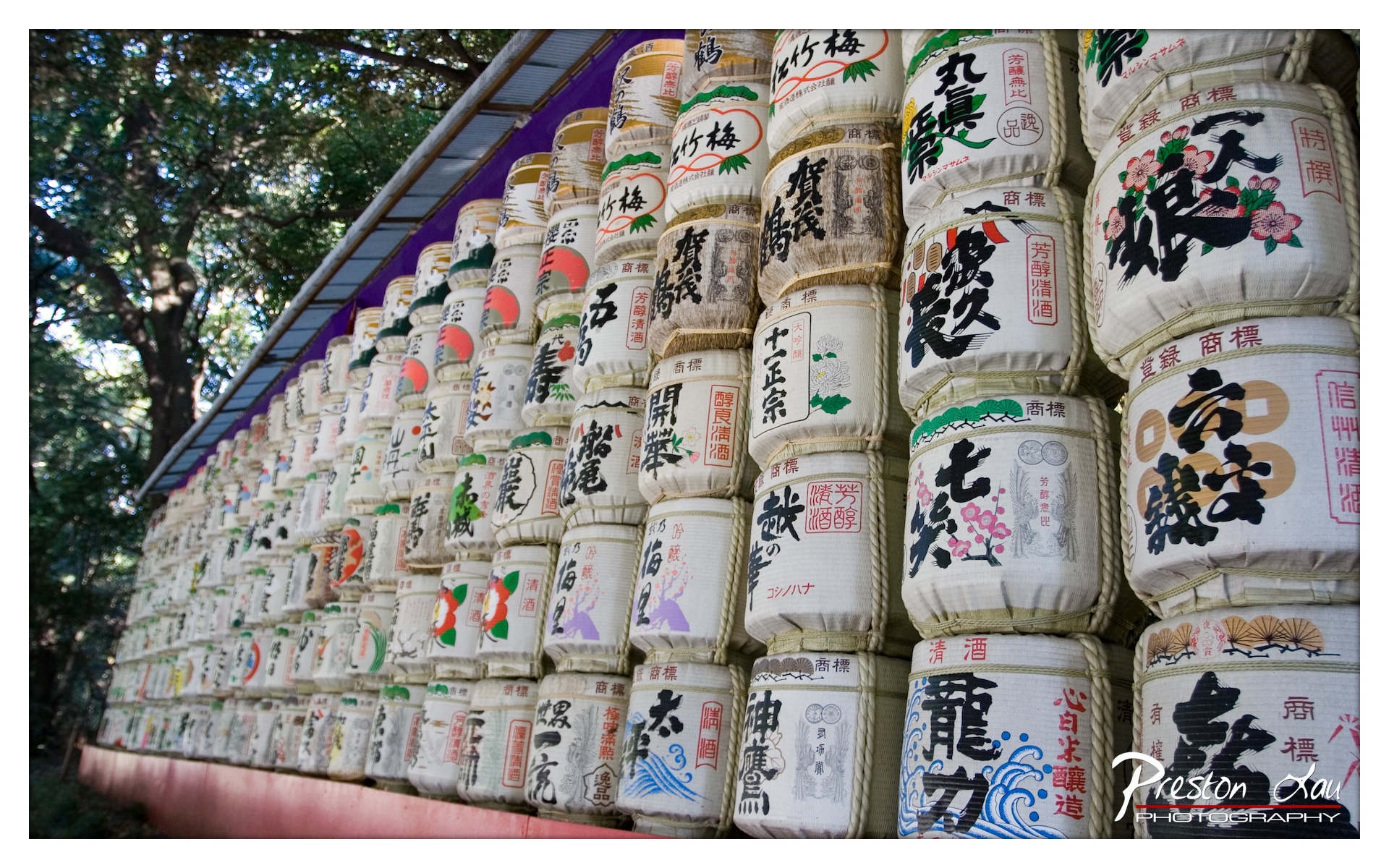

1. Overall Rating (0–10) — 7.5
This photograph captures the quiet reverence and cultural richness of a Japanese shrine, where rows of sake barrels stand as silent witnesses to tradition and devotion. The diagonal composition draws the eye through a sea of calligraphy and symbolic motifs, creating a sense of depth and rhythm. While the image is rich in detail and cultural texture, it occasionally feels slightly overexposed in the highlights, softening the impact of the intricate designs.
2. Composition (0–10) — 8.0
The diagonal alignment of the barrels creates a strong leading line, guiding the viewer’s gaze through the frame with dynamic energy. The framing effectively emphasizes repetition and pattern, while the inclusion of trees and a roofline adds context and depth. The slight tilt enhances the sense of movement without disrupting balance.
3. Lighting (0–10) — 7.0
Natural daylight illuminates the scene with a soft, diffused quality, allowing the details on the barrels to remain visible. However, the bright sky and tree canopy create high contrast, resulting in blown-out highlights in some areas. The light enhances the textures of the rice paper and rope but slightly diminishes tonal subtlety.
4. Color & Tone (0–10) — 7.5
The palette is dominated by whites and off-whites, punctuated by bold reds, blacks, and occasional splashes of green and blue, creating a traditional and harmonious Japanese aesthetic. The contrast between the vibrant calligraphy and the neutral background draws attention to the text and symbols. A slightly cooler tone in the shadows lends a calm, contemplative mood.
5. Creativity (0–10) — 8.0
The image successfully transforms a familiar cultural scene into a visually compelling narrative through its emphasis on pattern, rhythm, and cultural symbolism. The photographer’s choice to capture the sheer volume of barrels conveys both the scale and the spiritual significance of the practice. The inclusion of the photographer’s watermark in the corner subtly asserts authorship without disrupting the composition.
6. Technical Quality (0–10) — 8.0
Sharp focus across the frame allows for clear visibility of the intricate calligraphy and textures on the barrels. The image is well-exposed overall, though some highlights are slightly overexposed. The resolution and detail are high, showcasing the fine lines of the rope and printed characters.
7. Emotional Impact (0–10) — 7.0
The photograph evokes a sense of quiet devotion and cultural continuity, inviting the viewer to reflect on tradition and ritual. The sheer number of barrels suggests collective hope and prayer, creating a contemplative atmosphere. While the emotional resonance is strong, the lack of a human presence keeps the viewer at a slight remove, emphasizing the scene’s ritualistic nature over personal connection.
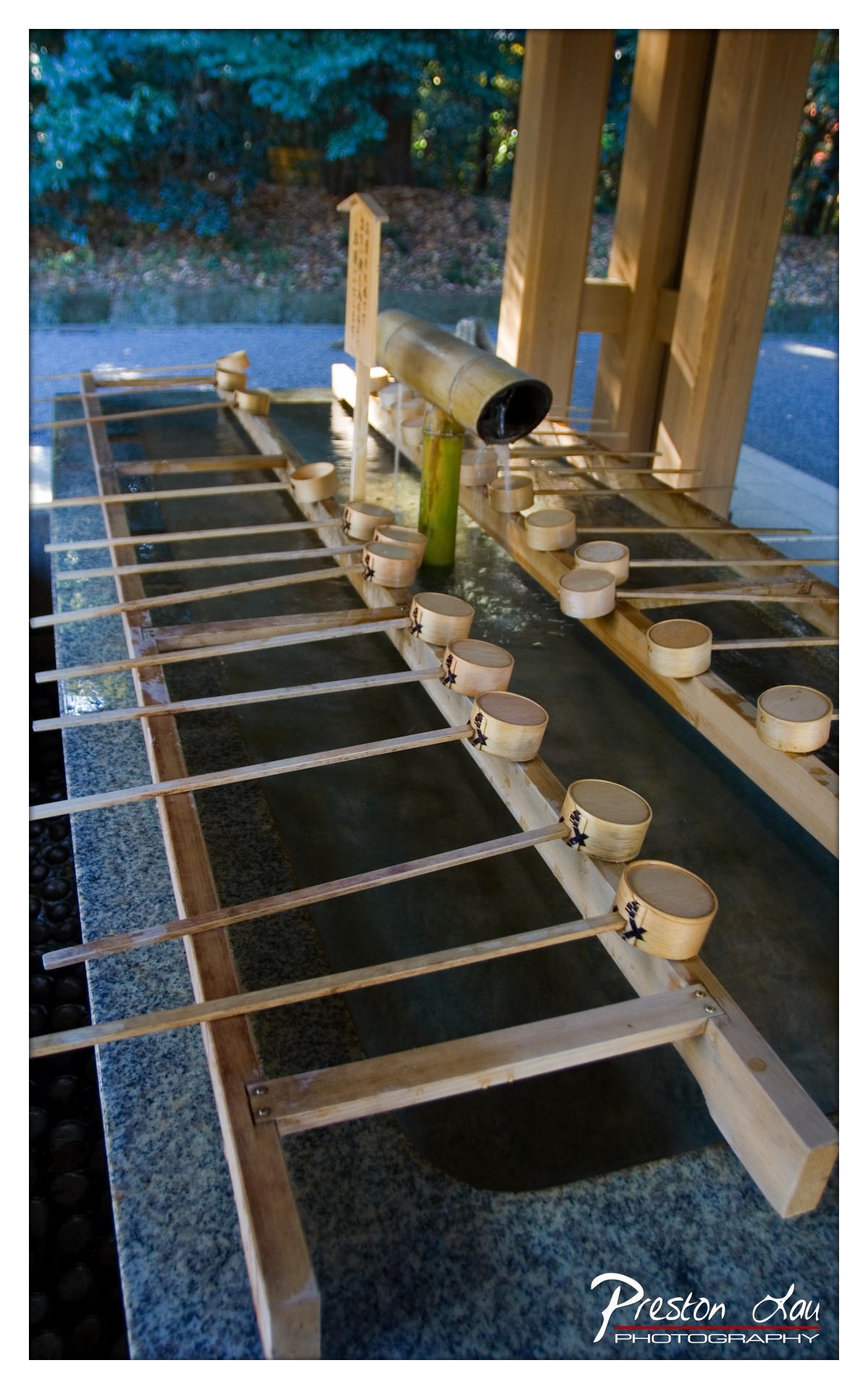

1. Overall Rating (0–10) — 7.5
This photograph captures the serene ritual of a Japanese *temizuya*, where the act of purification is rendered with quiet dignity. The interplay of natural wood, flowing water, and soft sunlight creates a meditative atmosphere, emphasizing simplicity and intentionality. While the composition is strong and the subject inherently meaningful, a more deliberate use of depth of field and framing could elevate the image from a pleasant snapshot to a compelling visual statement.
2. Composition (0–10) — 7.0
The diagonal arrangement of the *hishaku* ladles leads the eye through the frame, creating a sense of movement and rhythm. The slightly off-center placement of the bamboo spout adds visual interest, though the background clutter and uneven spacing slightly disrupt the balance.
3. Lighting (0–10) — 8.0
Soft, directional sunlight filters through the wooden structure, casting gentle highlights on the bamboo and creating a warm, tranquil mood. The contrast between light and shadow enhances the texture of the wood and water, adding depth without overpowering the scene.
4. Color & Tone (0–10) — 7.5
The palette is harmonious, with earthy wood tones complemented by the cool blue-gray of the stone basin and the deep green of the foliage. The slightly cool overall tone enhances the feeling of calm, though a touch more warmth in the highlights could further accentuate the organic materials.
5. Creativity (0–10) — 7.0
The image successfully captures a culturally rich moment with a clear sense of place. The focus on the ritualistic elements—water, wood, and light—conveys a quiet narrative, but the approach remains largely observational rather than interpretive.
6. Technical Quality (0–10) — 8.0
Sharp focus on the central elements, clean detail in the wood grain and water droplets, and a well-managed depth of field contribute to a technically sound image. The exposure is balanced, with no significant over- or underexposed areas.
7. Emotional Impact (0–10) — 8.0
The photograph evokes a sense of peace and reverence, inviting the viewer to pause and reflect. The combination of sound (implied), texture, and ritual creates a powerful emotional resonance, making the moment feel both personal and universal.
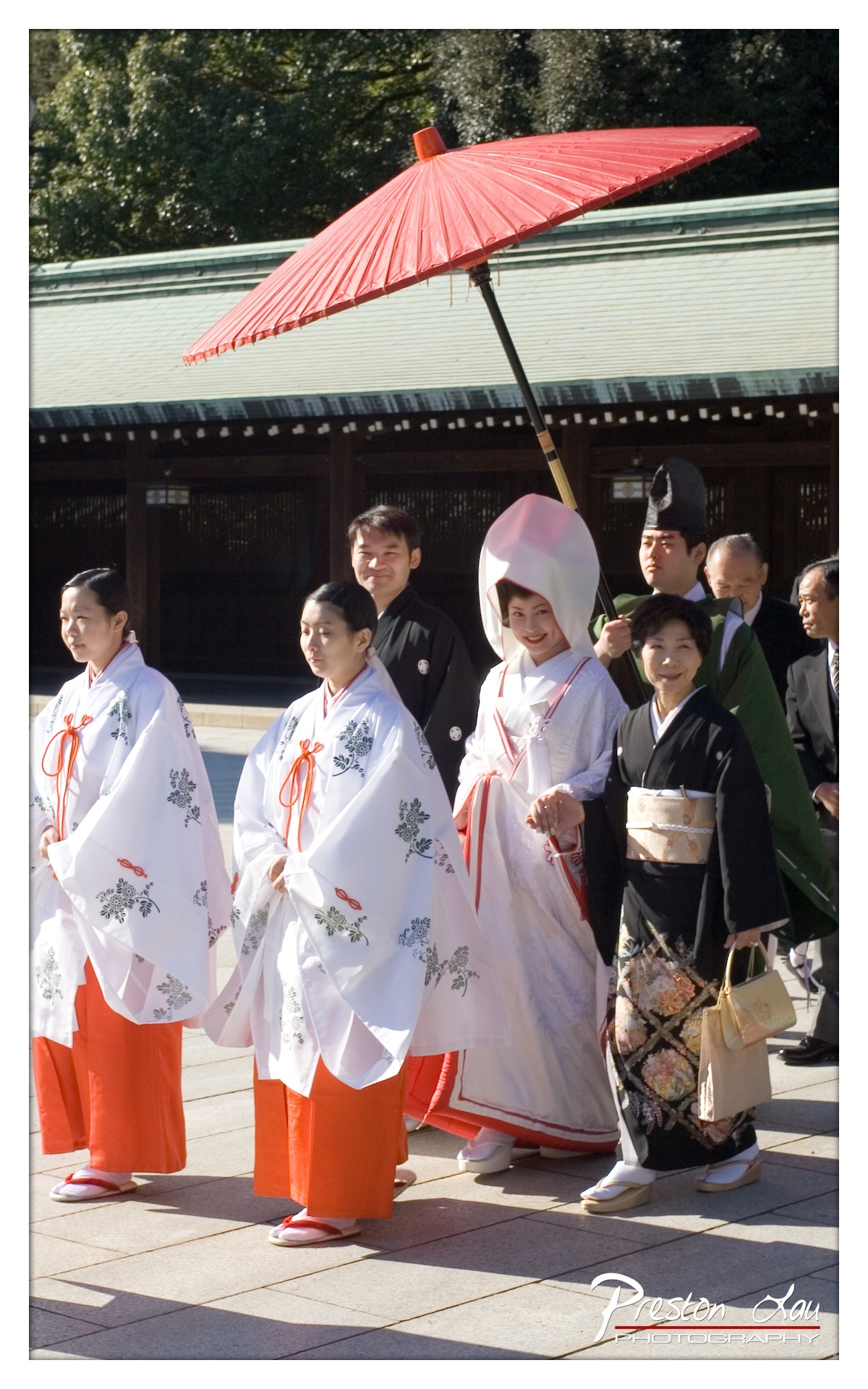

1. Overall Rating (0–10) — 7.5
This photograph captures a vibrant and culturally rich moment from a traditional Japanese wedding procession, exuding both elegance and ceremonial grace. The bright red parasol and the bride’s ornate white kimono serve as powerful visual anchors, drawing the eye through the composition. While the image is rich in cultural detail and emotional warmth, the slightly cluttered arrangement of figures and the heavy watermark slightly detract from its overall aesthetic cohesion.
2. Composition (0–10) — 7.0
The subjects are arranged in a diagonal line that guides the viewer’s gaze across the frame, creating a sense of movement and narrative progression. The red parasol provides a strong focal point at the top, while the temple-like structure in the background offers depth and context. However, the inclusion of too many figures in the midground creates a slight visual imbalance, and the tight framing limits negative space.
3. Lighting (0–10) — 8.0
Bright, natural sunlight illuminates the scene with clarity and warmth, casting crisp shadows that enhance the three-dimensionality of the subjects. The light accentuates the textures of the kimonos and the vibrant red of the parasol, creating a joyful and celebratory mood. The sun’s position creates a slight contrast between the brightly lit figures and the shaded background, adding depth without overwhelming the scene.
4. Color & Tone (0–10) — 8.5
The color palette is rich and harmonious, with the bold red of the parasol and the vibrant orange of the bridesmaids’ hakama creating a striking contrast against the white kimonos and the muted green of the temple roof. The tonal range is well-balanced, with the warm tones complementing the cultural significance of the event. The overall effect is visually dynamic and emotionally uplifting.
5. Creativity (0–10) — 8.0
The image successfully captures a moment of cultural tradition with authenticity and respect. The use of the red parasol as a compositional and symbolic element adds a layer of narrative richness. While the subject matter is conventional, the photographer’s ability to convey the joy and solemnity of the occasion demonstrates thoughtful storytelling and a keen eye for cultural detail.
6. Technical Quality (0–10) — 8.0
The photograph is sharp and well-focused, with clear details visible in the fabric textures and facial expressions. The exposure is well-managed, preserving highlights and shadows without clipping. The depth of field is appropriate, keeping the central figures in focus while softly blurring the background to maintain emphasis on the procession.
7. Emotional Impact (0–10) — 8.0
The image evokes a strong sense of celebration, tradition, and familial connection. The smiles and poised expressions of the participants, particularly the bride, convey genuine happiness and pride. The cultural richness of the scene resonates emotionally, inviting the viewer to appreciate the beauty of a time-honored ceremony.
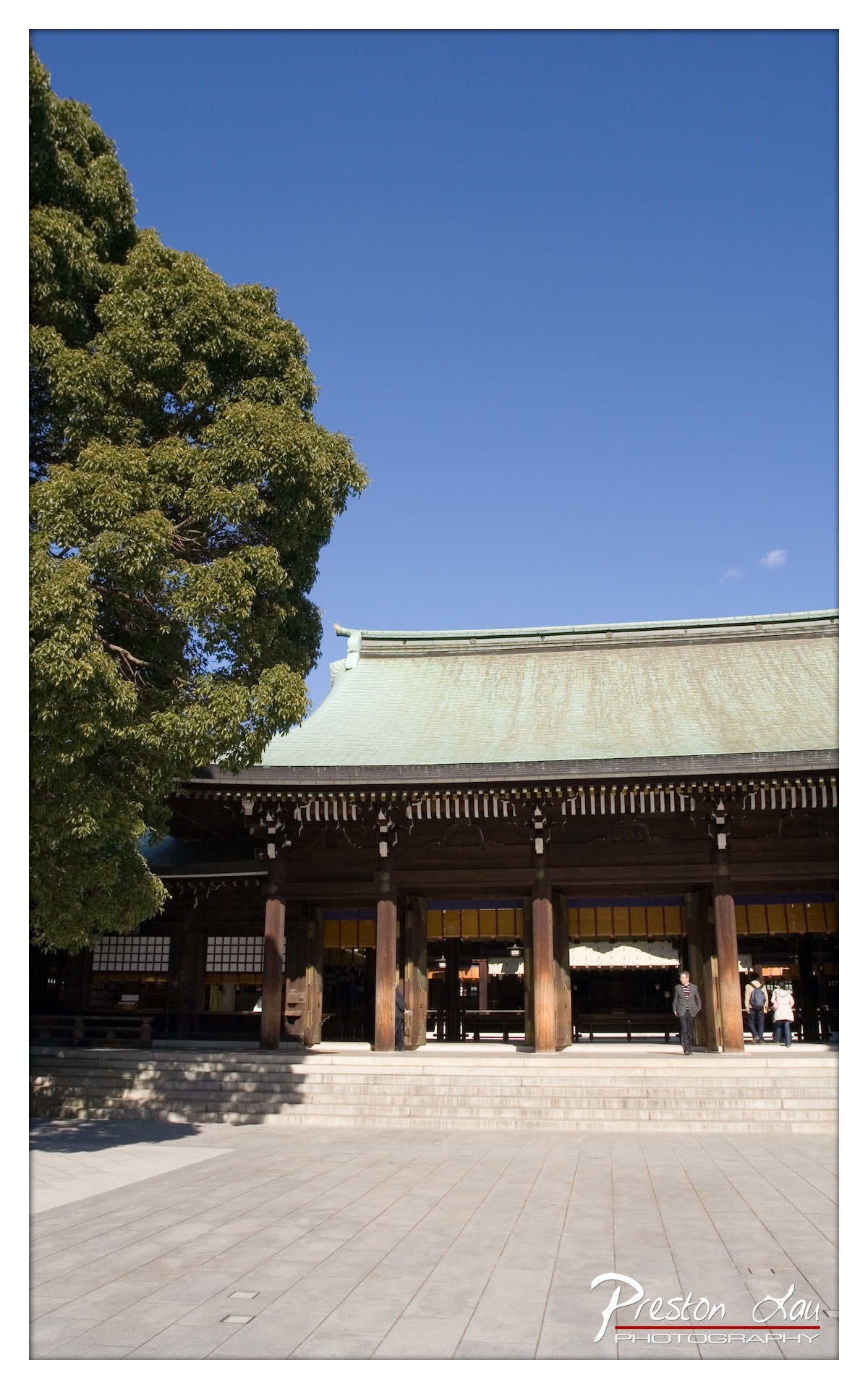

1. Overall Rating (0–10) — 7.5
This photograph captures the serene grandeur of a traditional Japanese shrine under a vast, cloudless sky, where architectural symmetry and natural elements converge in quiet harmony. The bold contrast between the verdant tree and the expansive blue expanse creates a striking visual rhythm, while the presence of visitors grounds the scene in human scale. The image succeeds in conveying both the timelessness of the structure and the peacefulness of the moment, though a slightly more dynamic composition could elevate its emotional resonance.
2. Composition (0–10) — 7.0
The strong diagonal of the tree on the left balances the horizontal lines of the shrine and steps, creating a dynamic yet stable frame. The use of negative space above the building emphasizes scale and openness, though the off-center subject placement slightly disrupts symmetry.
3. Lighting (0–10) — 8.0
Bright, direct sunlight enhances the textures of the wooden pillars and the patina of the roof, while casting crisp shadows that define depth and form. The clear blue sky acts as a natural backdrop, creating a luminous and clean aesthetic.
4. Color & Tone (0–10) — 8.0
The deep green of the tree contrasts beautifully with the cool blue of the sky and the warm brown of the wood, resulting in a balanced and harmonious palette. The tonal range is rich and well-distributed, with subtle variations in the roof’s weathered surface adding visual interest.
5. Creativity (0–10) — 7.5
The image demonstrates a thoughtful approach to capturing cultural architecture in a natural setting, emphasizing both form and atmosphere. The inclusion of subtle human presence adds narrative depth without disrupting the scene’s tranquility.
6. Technical Quality (0–10) — 8.5
Sharp focus across the frame, precise exposure, and excellent clarity highlight the architectural details and textures. The image is free of noticeable flaws and shows strong technical execution.
7. Emotional Impact (0–10) — 7.0
The photograph evokes a sense of calm and reverence, inviting the viewer to reflect on tradition and space. The quiet presence of people adds a layer of relatability, enhancing the emotional connection to the sacred site.
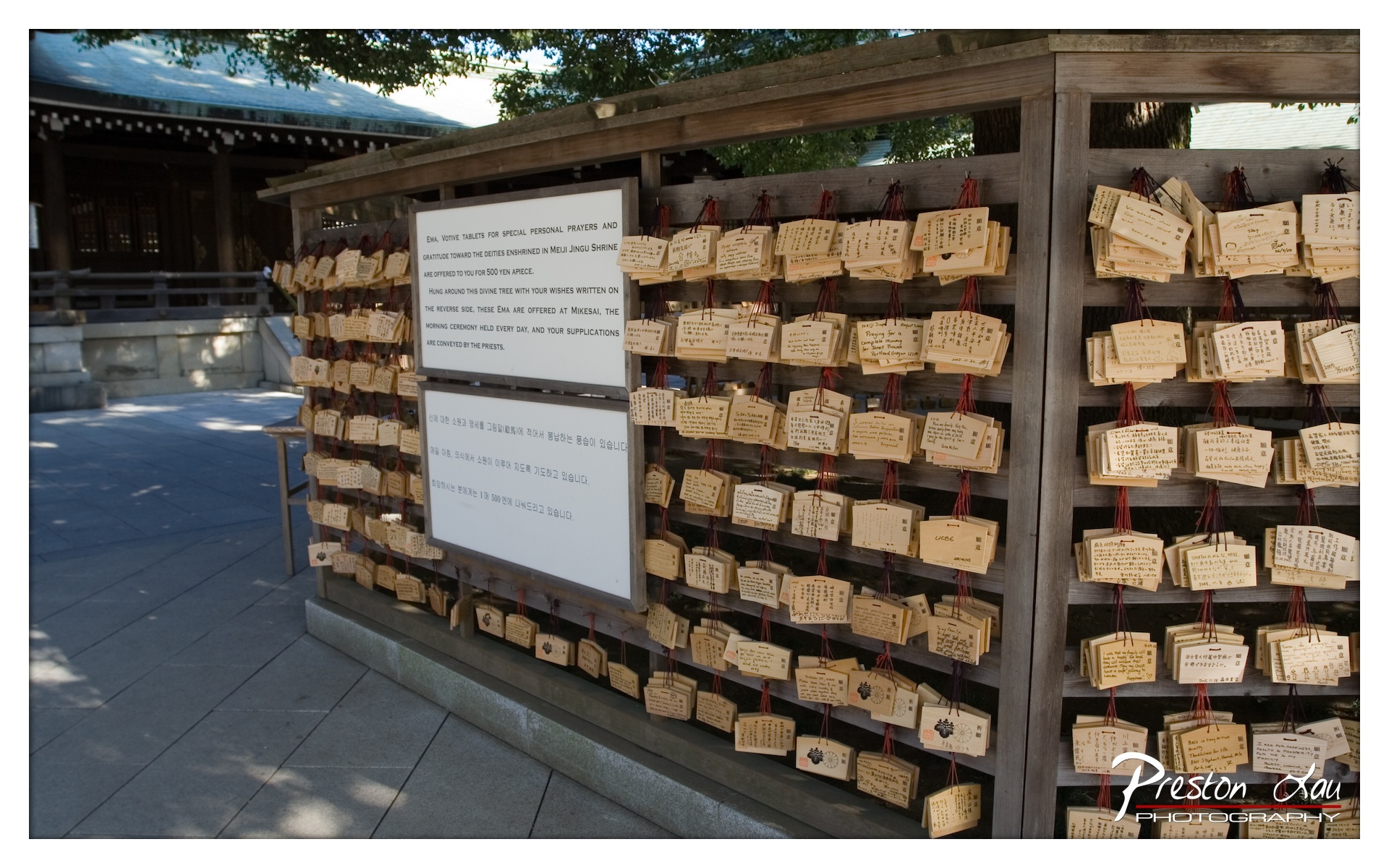

1. Overall Rating (0–10) — 7.0
This photograph captures the quiet reverence of a sacred space, where personal prayers and wishes are suspended in a delicate web of tradition and faith. The wooden ema plaques, inscribed with handwritten messages, create a textured tapestry of human hopes, while the natural light filtering through the trees softens the scene with a contemplative glow. Though the image is rich in cultural detail, the inclusion of the informational sign and watermark slightly disrupts the spiritual atmosphere, keeping the viewer anchored in the act of observation rather than immersion.
2. Composition (0–10) — 7.5
The framing centers the ema plaques, creating a strong visual anchor, while the diagonal lines of the wooden structure guide the eye through the depth of the scene. The placement of the sign on the left balances the visual weight of the densely packed plaques on the right, though the slight tilt of the sign introduces a subtle asymmetry.
3. Lighting (0–10) — 7.0
Natural daylight bathes the scene in a soft, even glow, highlighting the texture of the wooden plaques and casting gentle shadows that add dimension. The dappled light from the trees above enhances the serene mood, while the absence of harsh shadows preserves the quiet intimacy of the moment.
4. Color & Tone (0–10) — 6.5
The palette is dominated by warm, earthy tones—beige, brown, and muted red—evoking a sense of age and tradition. The contrast between the aged wood and the crisp white of the sign adds visual interest, though the overall tonal range is somewhat restrained, limiting the emotional vibrancy.
5. Creativity (0–10) — 7.0
The image successfully captures the ritualistic beauty of a Japanese shrine practice, transforming a simple display of prayer plaques into a narrative of shared human hopes. The inclusion of multilingual text adds a layer of cultural accessibility, broadening the story beyond the immediate context.
6. Technical Quality (0–10) — 8.0
The photograph is sharp and well-focused, with fine detail visible in the handwriting on the ema and the grain of the wood. The exposure is balanced, preserving detail in both the shadows and highlights, and the watermark is discreetly placed in the corner.
7. Emotional Impact (0–10) — 7.5
There is a palpable sense of quiet devotion and connection to something larger than oneself. The sheer number of wishes hanging in the breeze invites reflection on the universal nature of hope, making the image resonate on a deeply personal level.
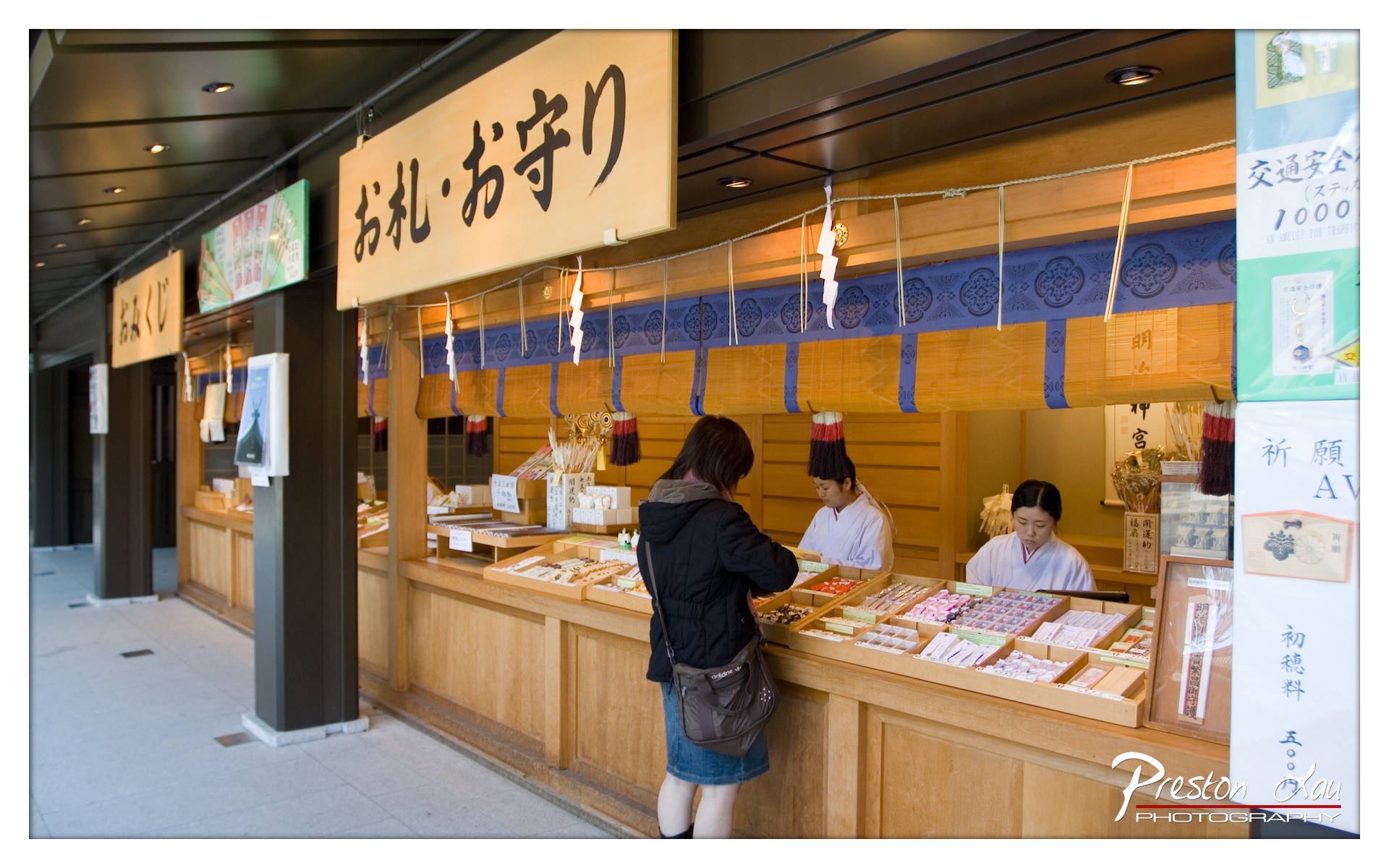

1. Overall Rating (0–10) — 7.5
This photograph captures the serene authenticity of a traditional Japanese shrine shop, where cultural ritual meets everyday commerce. The warm wood tones and ceremonial details evoke a sense of reverence and continuity, while the interaction between the customer and vendors adds a human dimension. Though the image is well-composed and rich in cultural context, the slightly flat lighting and lack of dramatic contrast prevent it from achieving a more compelling visual resonance.
2. Composition (0–10) — 7.0
The frame balances the wooden counter, signage, and figures effectively, creating a natural flow from left to right. The diagonal line of the sign and the depth of the stall draw the eye into the scene, though the slightly off-center placement of the main subject slightly disrupts symmetry.
3. Lighting (0–10) — 6.0
Even, diffused overhead lighting illuminates the scene without harsh shadows, preserving detail across the wooden surfaces and merchandise. However, the lack of directional light or contrast diminishes the sense of depth and atmosphere, giving the image a more documentary feel than a cinematic one.
4. Color & Tone (0–10) — 7.0
The warm, natural wood tones dominate the palette, complemented by the rich blue of the sacred shide streamers. The restrained color scheme feels authentic and culturally appropriate, though the overall tone leans slightly cool and muted, reducing the visual warmth.
5. Creativity (0–10) — 7.5
The image successfully blends cultural storytelling with everyday life, capturing a moment that feels both ordinary and sacred. The inclusion of Japanese calligraphy and ritual objects adds layers of meaning, transforming a simple transaction into a visual narrative of tradition.
6. Technical Quality (0–10) — 8.0
Sharp focus is maintained across the scene, with clear details in the wood grain, text, and merchandise. The exposure is well-balanced, and the depth of field is appropriate for the environment, keeping both foreground and background elements readable.
7. Emotional Impact (0–10) — 7.0
The photograph conveys a quiet reverence and cultural authenticity, inviting the viewer to pause and reflect on the intersection of faith and daily life. While the emotional resonance is subtle, it is sincere and grounded in the authenticity of the moment.
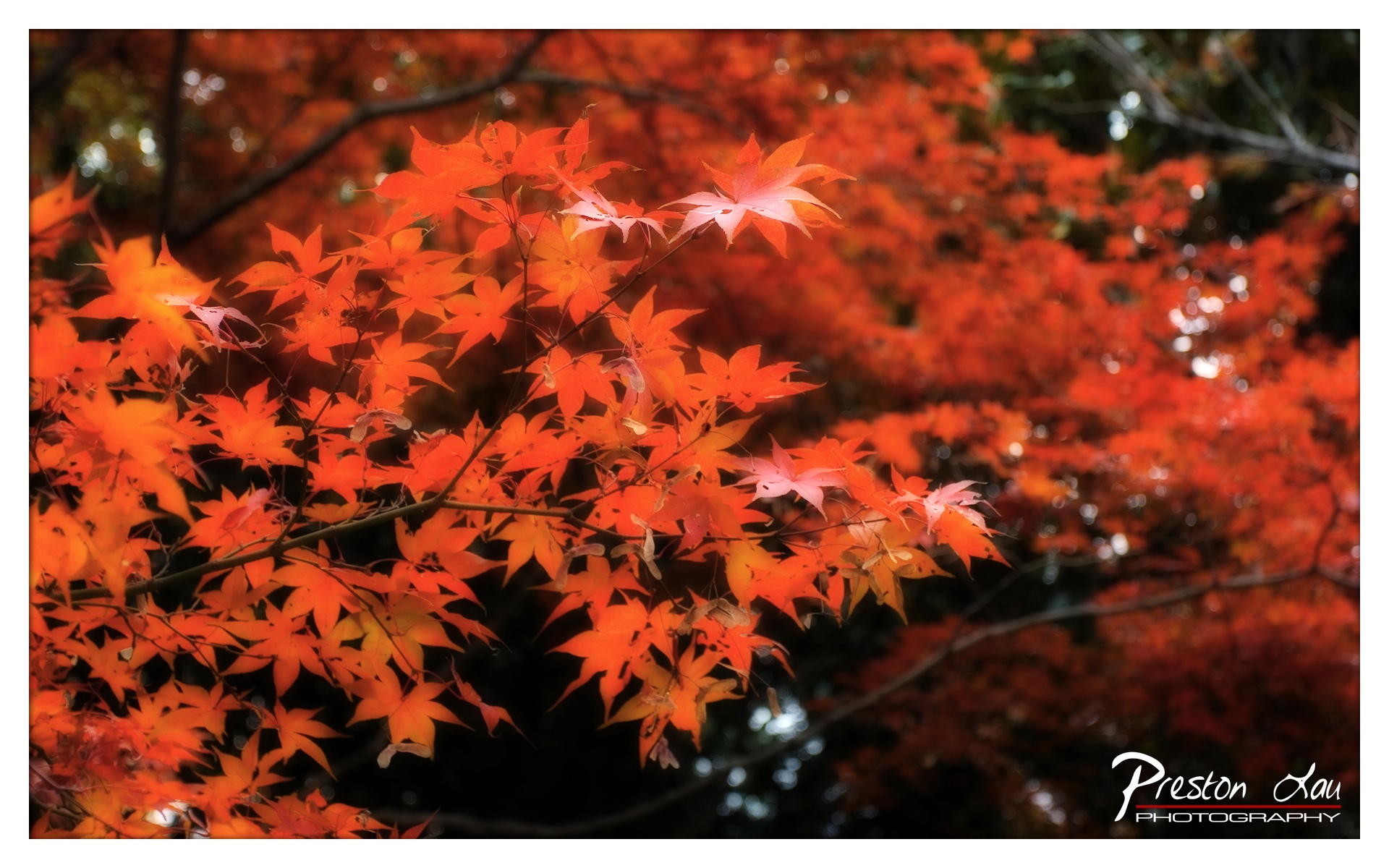

1. Overall Rating (0–10) — 8.5
This photograph captures the fiery brilliance of autumn with a painterly quality, where vibrant red and orange maple leaves glow against a softly blurred backdrop. The interplay of light and color evokes a sense of warmth and transience, celebrating the peak of fall foliage. While the image is visually striking, a slightly more deliberate focus on depth and texture could elevate its emotional resonance further.
2. Composition (0–10) — 8.0
The diagonal arrangement of the branch guides the eye naturally through the frame, with the foreground leaves drawing immediate attention. The shallow depth of field effectively isolates the subject, creating a balanced and harmonious composition.
3. Lighting (0–10) — 9.0
Soft, diffused light enhances the saturation of the leaves, creating gentle highlights and a luminous glow. The backlighting emphasizes the translucency of the leaves, adding a delicate, almost ethereal quality.
4. Color & Tone (0–10) — 9.5
The rich, warm palette of fiery reds and oranges is perfectly balanced with subtle hints of yellow and deep shadow. The contrast between the vibrant leaves and the dark background heightens the visual impact, creating a striking and cohesive tonal harmony.
5. Creativity (0–10) — 8.5
The photographer captures the essence of autumn with a strong sense of atmosphere and mood. The use of selective focus and color grading transforms a simple natural scene into a contemplative, almost dreamlike image.
6. Technical Quality (0–10) — 9.0
The image is sharp where it matters, with fine detail visible in the leaves' edges and veins. The focus is precise, and the exposure is well-managed, preserving detail in both highlights and shadows.
7. Emotional Impact (0–10) — 9.0
The photograph evokes a deep sense of seasonal beauty and quiet contemplation, inviting the viewer to pause and reflect on the fleeting nature of autumn. The warmth and vibrancy of the colors stir feelings of nostalgia and appreciation for nature’s artistry.
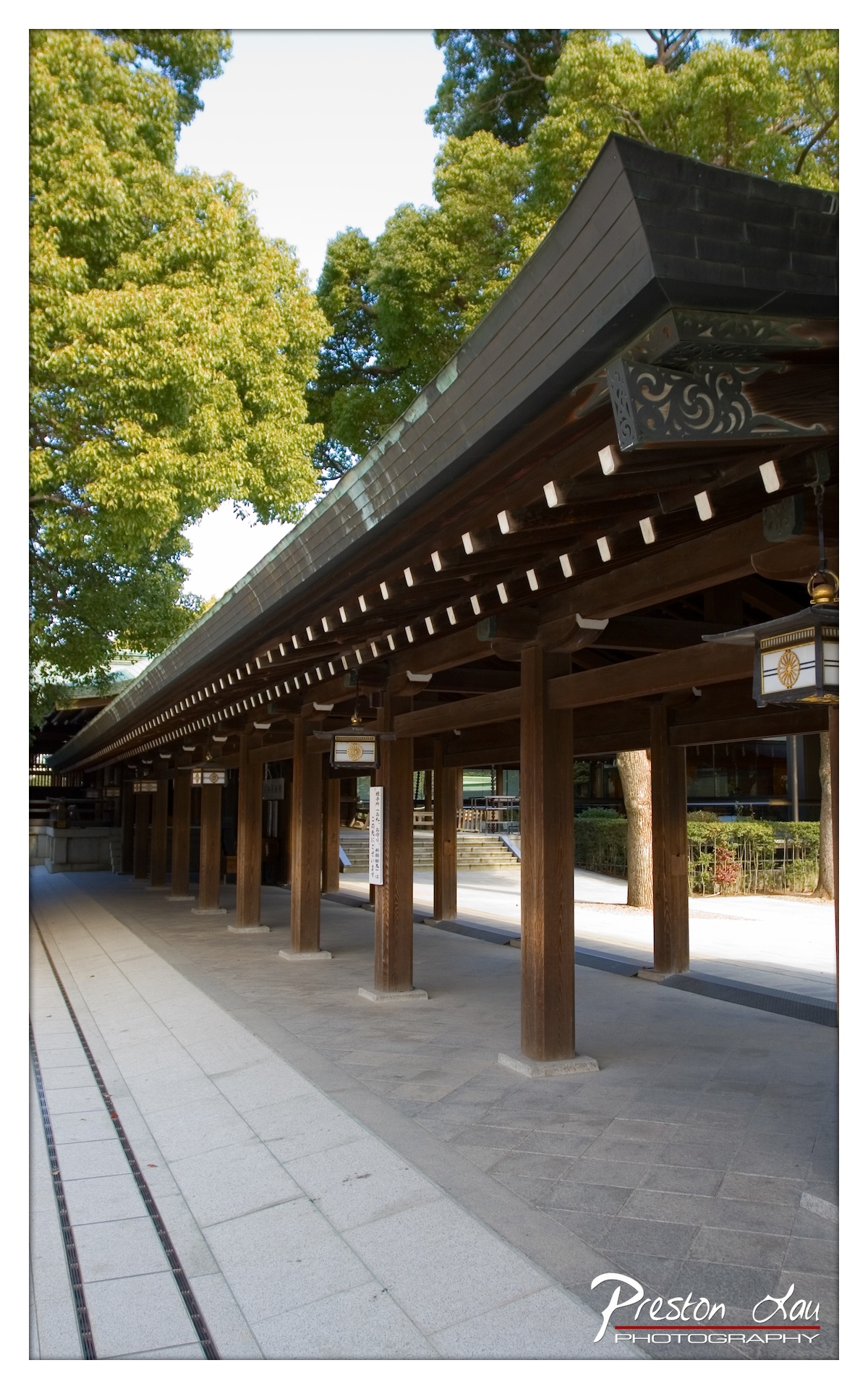

1. Overall Rating (0–10) — 7.5
This photograph captures the serene dignity of a traditional Japanese shrine, where architecture and nature coexist in quiet harmony. The low-angle perspective emphasizes the grandeur of the wooden structure, while the lush green canopy above adds a sense of timelessness. Though the image is well-composed and rich in cultural texture, a slightly more dynamic lighting setup could enhance its visual depth and emotional resonance.
2. Composition (0–10) — 8.0
The strong diagonal line of the roof and pillars guides the eye through the frame, creating a sense of movement and depth. The placement of the walkway on the left balances the visual weight of the roofline, while the framing by trees adds natural symmetry.
3. Lighting (0–10) — 7.0
Natural daylight illuminates the scene evenly, highlighting the textures of wood and stone. The soft shadows under the eaves add dimension, though the bright sky slightly overexposes the top of the frame, reducing contrast in the foliage.
4. Color & Tone (0–10) — 7.5
The palette is rich with earthy browns and vibrant greens, creating a natural harmony. The cool tones of the stone walkway contrast gently with the warm wood, enhancing visual interest. The slight color saturation gives the image a polished, almost painterly quality.
5. Creativity (0–10) — 7.0
The photographer captures a familiar subject—traditional Japanese architecture—but elevates it through thoughtful composition and perspective. The inclusion of cultural details like the lanterns and carved brackets adds narrative depth without feeling staged.
6. Technical Quality (0–10) — 8.0
Sharp focus across the frame, precise exposure control, and clean detail in both wood grain and stone texture demonstrate strong technical execution. The watermark is discreet and unobtrusive.
7. Emotional Impact (0–10) — 8.0
The image evokes a sense of peace and reverence, inviting the viewer into a quiet, sacred space. The stillness of the scene and the subtle interplay of light and shadow foster a contemplative mood, suggesting a moment suspended in time.
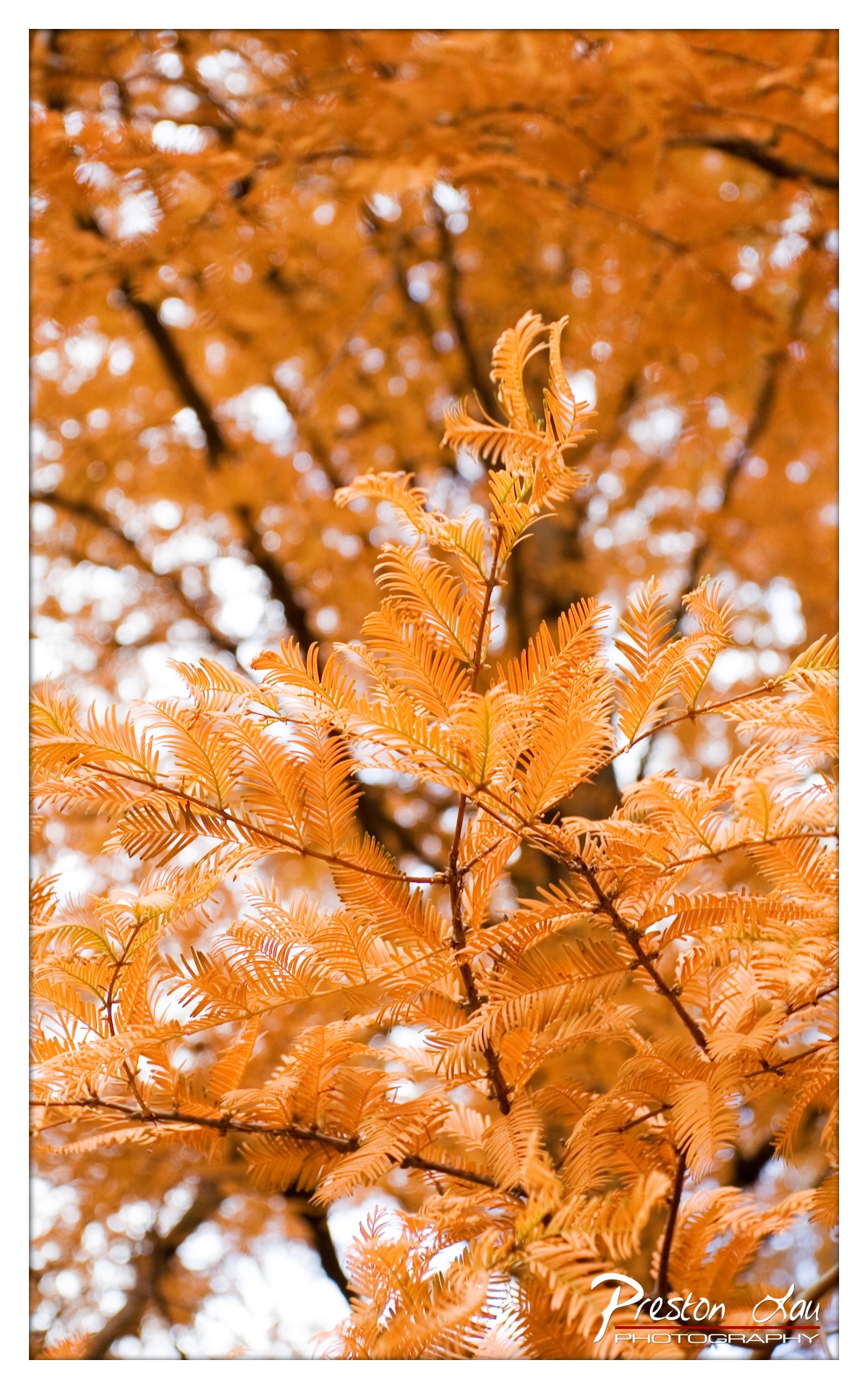

1. Overall Rating (0–10) — 8.0
This photograph captures the warm, luminous essence of autumn with a dreamlike quality, where the golden-orange foliage seems to glow against a soft, blurred backdrop. The shallow depth of field creates an intimate, almost ethereal atmosphere, drawing the viewer into the delicate textures of the tree’s needles. While the image is visually rich and emotionally resonant, its simplicity borders on generic, lacking a strong narrative hook to elevate it beyond a beautiful but conventional seasonal portrait.
2. Composition (0–10) — 7.5
The subject is well-centered with a clear focal point in the foreground branches, and the use of negative space in the background enhances the sense of depth. However, the composition feels slightly top-heavy, with the upper portion of the frame dominated by out-of-focus foliage, which could be balanced more effectively.
3. Lighting (0–10) — 8.5
Soft, diffused light filters through the canopy, enhancing the warm tones and creating a gentle glow on the leaves. The highlights are delicate and natural, avoiding harsh shadows and contributing to the image’s serene, golden-hour feel.
4. Color & Tone (0–10) — 9.0
The warm, monochromatic palette of orange and amber is beautifully harmonized, with subtle variations in tone adding depth and richness. The contrast between the vibrant foliage and the soft white bokeh creates a visually cohesive and emotionally evocative look.
5. Creativity (0–10) — 7.5
The photographer captures a familiar autumnal theme with a strong aesthetic sensibility, using a shallow depth of field to transform the scene into something more abstract and painterly. While the concept is not groundbreaking, the execution is thoughtful and expressive.
6. Technical Quality (0–10) — 8.0
The focus is sharp on the foreground branches, with smooth bokeh in the background, indicating a wide aperture and precise control. The image is clean, with minimal noise and good detail retention.
7. Emotional Impact (0–10) — 8.5
The warm tones and soft focus evoke a sense of nostalgia and tranquility, inviting quiet contemplation. The image feels peaceful and meditative, resonating with the quiet beauty of fall.


1. Overall Rating (0–10) — 7.0
This photograph captures a contemplative moment of an artist immersed in their craft, framed by the skeletal branches of a winter tree. The muted earth tones and natural setting evoke a sense of quiet solitude, while the artist’s focused posture adds a layer of human intimacy. Though the image is grounded in realism, it lacks the visual dynamism to feel truly striking, holding back from full emotional resonance despite its thoughtful composition.
2. Composition (0–10) — 7.5
The diagonal branches in the foreground create a natural frame, drawing the eye toward the painter while adding depth. The subject is placed off-center, creating a balanced asymmetry, though the low angle slightly flattens the sense of space.
3. Lighting (0–10) — 6.5
Soft, diffused light suggests an overcast day, which minimizes harsh shadows and evenly illuminates the scene. While this enhances the calm mood, it also reduces contrast and depth, lending a slightly flat quality to the image.
4. Color & Tone (0–10) — 6.0
The palette is dominated by muted browns and grays, punctuated by the red and black of the artist’s jacket. While the colors are harmonious, they lack vibrancy, contributing to a subdued, almost melancholic atmosphere that aligns with the season but limits visual impact.
5. Creativity (0–10) — 7.0
The framing through bare branches adds a poetic layer, suggesting nature as both observer and muse. The scene captures a quiet narrative of artistic dedication, blending documentary realism with a subtle sense of introspection.
6. Technical Quality (0–10) — 7.5
The focus is sharp on the painter and easel, with sufficient clarity throughout. The image is well-exposed, and the details of the canvas and surrounding objects are clearly rendered, indicating strong technical execution.
7. Emotional Impact (0–10) — 6.5
The image conveys a quiet, introspective mood, inviting viewers to reflect on the act of creation. While the emotional pull is gentle and sincere, it remains restrained, leaving the viewer as a distant observer rather than a participant in the moment.
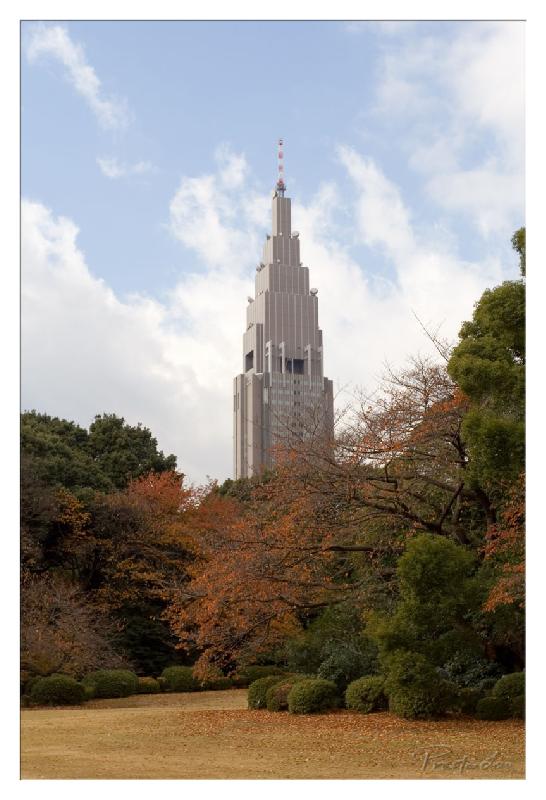

1. Overall Rating (0–10) — 7.0
This photograph captures a striking juxtaposition between the organic beauty of autumn foliage and the imposing geometry of a modernist skyscraper, creating a visually compelling narrative of nature and urbanism in harmony. The composition balances the soft, warm tones of the trees with the cool, structured lines of the building, evoking a sense of quiet contemplation. While the image successfully conveys a mood of serene coexistence, the slightly muted color saturation and lack of dynamic lighting prevent it from feeling fully immersive.
2. Composition (0–10) — 7.5
The low-angle perspective emphasizes the height and grandeur of the tower, while the foreground foliage frames the structure naturally. The placement of the building slightly off-center creates visual interest, and the layered arrangement of trees, shrubs, and sky adds depth and dimension.
3. Lighting (0–10) — 6.5
The soft, diffused daylight enhances the scene’s tranquil atmosphere, with gentle shadows that suggest a late morning or early afternoon. However, the lighting lacks strong directional contrast, resulting in a somewhat flat appearance that diminishes the architectural details.
4. Color & Tone (0–10) — 6.0
The palette blends warm autumnal oranges and browns with the cool grays of the building and the pale blue sky. While harmonious, the colors are slightly desaturated, giving the image a subdued, almost nostalgic quality that limits its visual impact.
5. Creativity (0–10) — 7.0
The image thoughtfully contrasts nature and architecture, offering a fresh perspective on a familiar urban landscape. The choice to frame the skyscraper through the trees adds a poetic layer, suggesting a dialogue between the natural and the man-made.
6. Technical Quality (0–10) — 7.5
The photograph is sharp and well-focused, with clean detail throughout the foliage and building. The exposure is balanced, and there are no obvious technical flaws, though the image could benefit from enhanced contrast and color vibrancy.
7. Emotional Impact (0–10) — 6.5
The scene evokes a sense of calm and reflection, inviting the viewer to pause and consider the relationship between the natural world and human creation. While emotionally resonant, the muted tone keeps the experience from feeling deeply stirring.
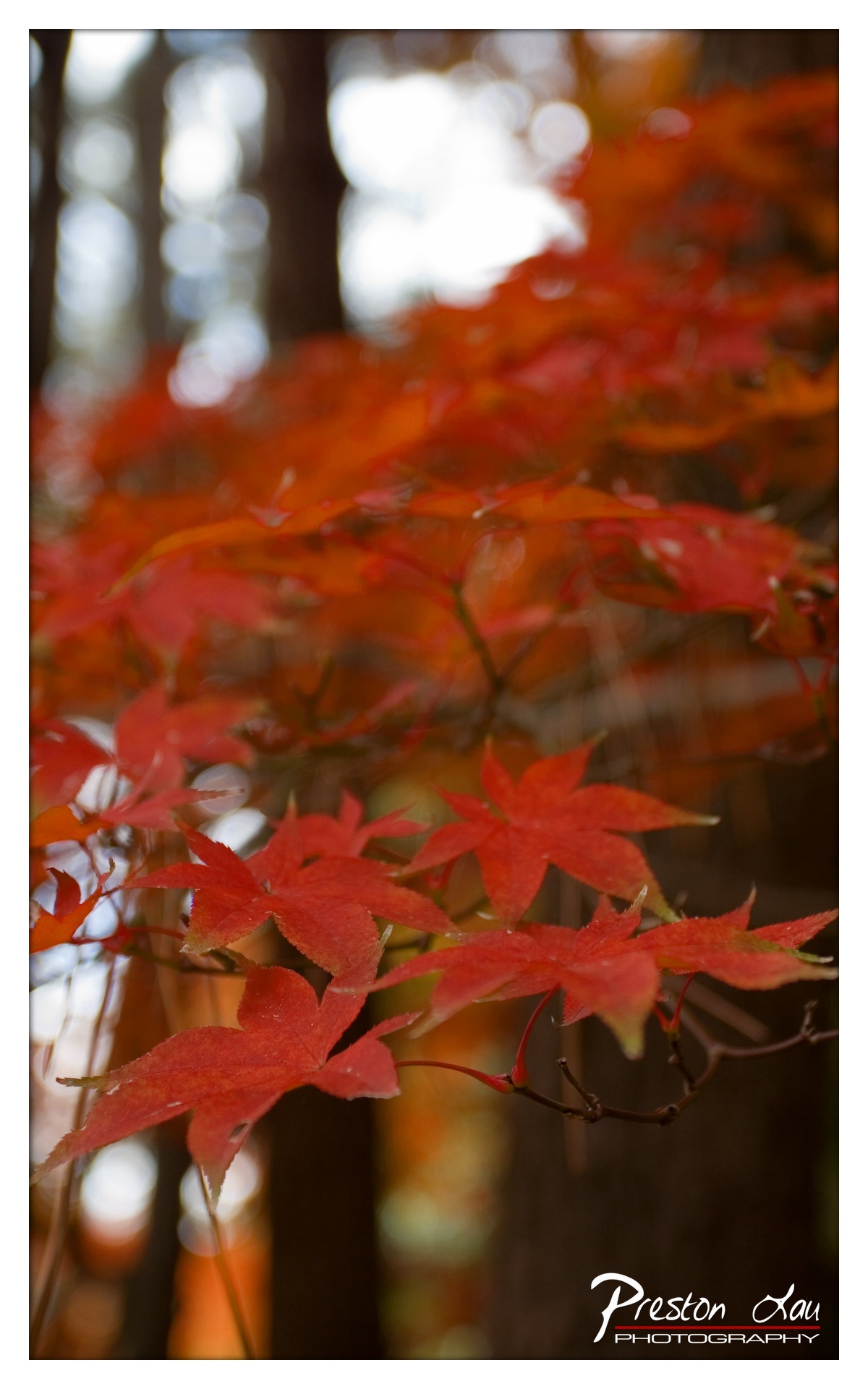

1. Overall Rating (0–10) — 8.0
This photograph captures the quiet beauty of autumn with a painterly quality, where vibrant red maple leaves emerge from a dreamy, softly blurred forest background. The shallow depth of field creates an intimate, almost meditative mood, drawing the viewer into the delicate textures of the leaves. While the image is visually striking and emotionally resonant, its success is rooted in atmosphere rather than technical precision, making it more evocative than technically groundbreaking.
2. Composition (0–10) — 7.5
The subject is well-placed in the lower third, allowing the background bokeh to provide a soft, organic frame. The diagonal lines of the branches guide the eye naturally through the image, though a tighter crop could enhance focus on the most detailed leaves.
3. Lighting (0–10) — 8.0
Soft, diffused light filters through the trees, creating gentle highlights on the leaves and a warm glow in the background. The light enhances the autumnal palette and contributes to the serene, contemplative mood.
4. Color & Tone (0–10) — 8.5
The rich, saturated reds of the maple leaves contrast beautifully with the warm oranges and muted browns of the background. The tonal range is balanced, with a natural warmth that enhances the seasonal feeling.
5. Creativity (0–10) — 8.0
The use of shallow depth of field and selective focus transforms a simple natural scene into a lyrical, almost abstract composition. The photographer’s intent to evoke emotion through color and light is clearly realized.
6. Technical Quality (0–10) — 7.5
The focus is sharp on the foreground leaves, with a smooth transition into the background. While the image is well-executed, some minor softness in the highlights suggests slight overuse of post-processing or lens characteristics.
7. Emotional Impact (0–10) — 8.5
The photograph evokes a deep sense of tranquility and nostalgia, capturing the fleeting beauty of fall in a way that feels personal and reflective. The viewer is invited to pause and appreciate the quiet elegance of nature’s seasonal transformation.
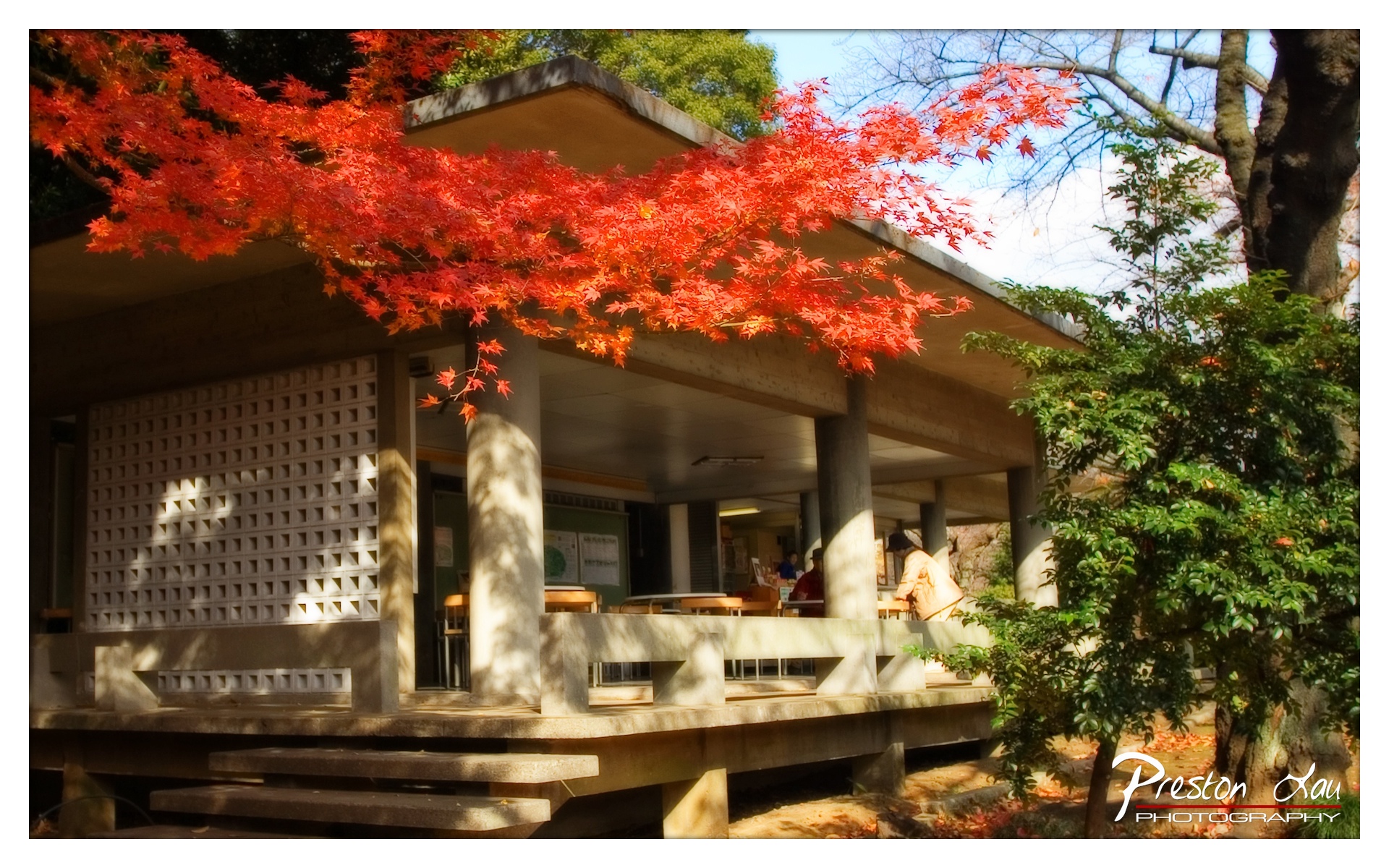

1. Overall Rating (0–10) — 8.0
This photograph captures a serene autumnal moment where nature and architecture coexist in quiet harmony. The vibrant red maple leaves dramatically frame the concrete pavilion, creating a striking contrast between organic warmth and modern minimalism. While the composition is rich in color and mood, the slightly overexposed sky and soft focus in the background prevent it from achieving full visual cohesion.
2. Composition (0–10) — 7.5
The diagonal sweep of the red leaves creates a dynamic leading line, drawing the eye toward the pavilion’s open space. The placement of the structure balances the frame, though the inclusion of the photographer’s watermark slightly disrupts the visual flow on the lower right.
3. Lighting (0–10) — 8.0
Natural sunlight filters through the canopy, casting dappled shadows across the concrete and enhancing the textures of both the building and foliage. The warm light accentuates the autumnal tones, adding depth and dimension to the scene.
4. Color & Tone (0–10) — 8.5
The vivid reds of the maple leaves pop against the neutral tones of the concrete and the soft greens of surrounding foliage. The color palette is harmonious and evocative, with a slightly enhanced saturation that heightens the seasonal atmosphere.
5. Creativity (0–10) — 8.0
The juxtaposition of traditional Japanese autumn aesthetics with modern architectural elements offers a fresh visual narrative. The framing emphasizes seasonal change as both a natural and cultural phenomenon, elevating the image beyond a simple landscape.
6. Technical Quality (0–10) — 7.5
The image is sharp in the foreground, particularly in the leaves and architectural details. However, the sky appears slightly overexposed, and the watermark, while not damaging the image, is a minor distraction in terms of aesthetic refinement.
7. Emotional Impact (0–10) — 8.0
The photograph evokes a sense of tranquility and contemplative beauty, capturing the fleeting essence of fall. The presence of a figure in the background adds a human element, grounding the scene in quiet daily life and inviting the viewer to imagine themselves within the moment.
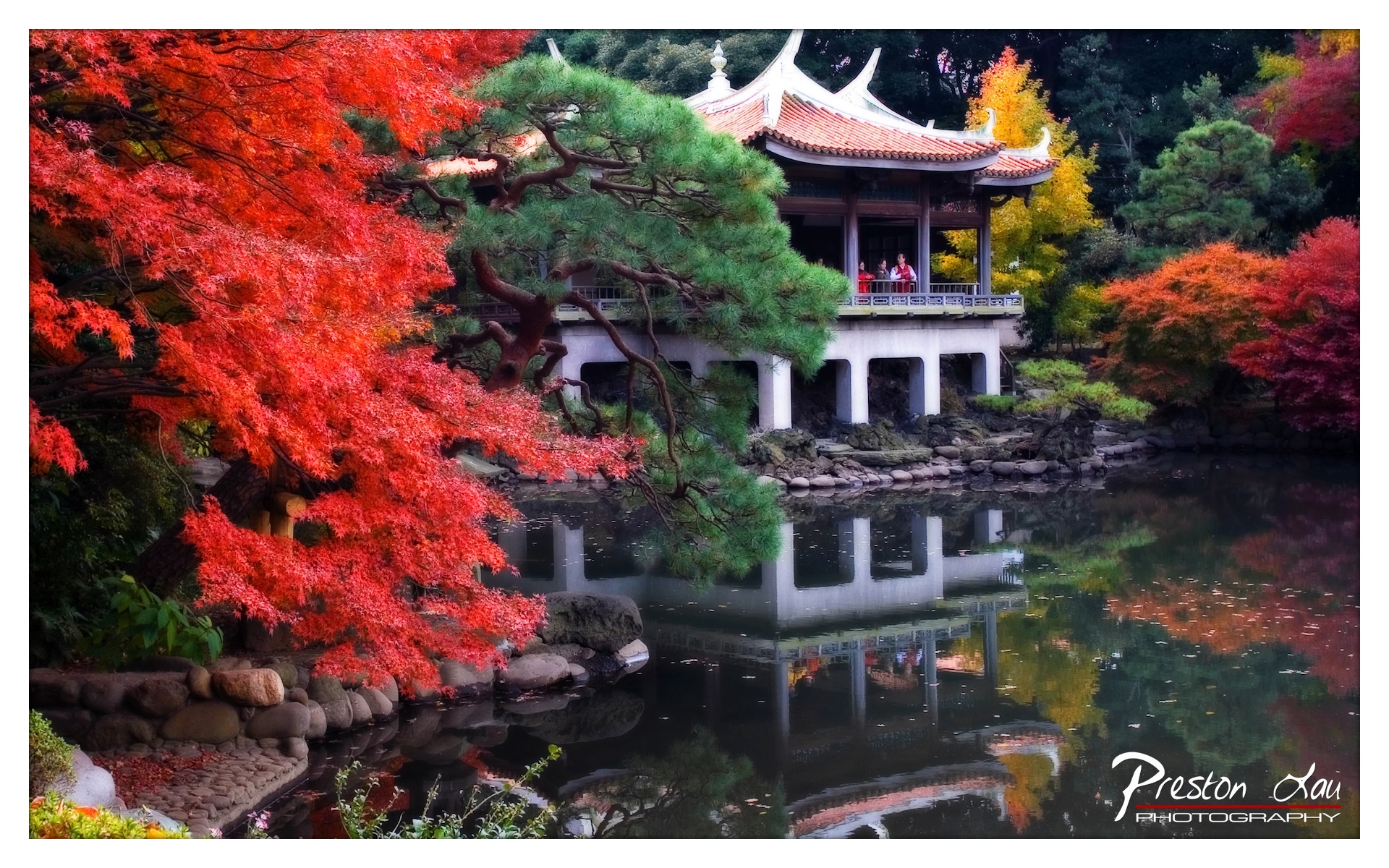

1. Overall Rating (0–10) — 8.5
This image captures the serene beauty of a traditional East Asian garden in peak autumn, where vibrant foliage and reflective water converge in a harmonious composition. The bold reds of the maple trees create a dramatic contrast with the cool greens and the calm, mirrored surface of the pond, evoking a sense of timeless tranquility. While the saturation leans heavily toward the dramatic, the scene’s cultural richness and visual balance elevate it beyond mere spectacle into a poetic celebration of nature and architecture.
2. Composition (0–10) — 8.0
The framing uses the overhanging red maple as a natural frame on the left, drawing the eye toward the pavilion and its reflection. The pavilion is placed slightly off-center, creating visual interest and allowing the surrounding foliage to balance the composition. The reflection in the water adds symmetry and depth, enhancing the image’s tranquil mood.
3. Lighting (0–10) — 7.5
The light appears soft and diffused, likely from an overcast sky, which prevents harsh shadows and allows the colors to appear rich and even. The light enhances the saturation of the autumn leaves without washing them out, creating a luminous quality that complements the scene’s calm atmosphere.
4. Color & Tone (0–10) — 9.0
The color palette is exceptionally vivid, with intense reds and oranges in the maple trees set against the deep green of the pine and the cool tones of the water and sky. The contrast between warm and cool colors creates a dynamic yet harmonious visual experience. The reflections add depth and reinforce the tonal balance.
5. Creativity (0–10) — 8.5
The photographer has skillfully captured the interplay between natural beauty and architectural elegance, using the vibrant fall colors to frame the traditional pavilion. The choice to include the reflection adds a layer of artistic depth, transforming a scenic view into a contemplative composition that feels both grand and intimate.
6. Technical Quality (0–10) — 9.0
The image is sharp and detailed, with excellent clarity in both the foreground and background elements. The focus is well-managed, capturing the texture of the leaves, the wood of the pavilion, and the ripples in the water. The exposure is balanced, preserving detail in both highlights and shadows.
7. Emotional Impact (0–10) — 8.0
The image evokes a sense of peace, wonder, and reverence for nature’s seasonal cycle. The combination of cultural elements and natural beauty invites the viewer to pause and reflect, creating a meditative experience that resonates with both visual splendor and emotional depth.
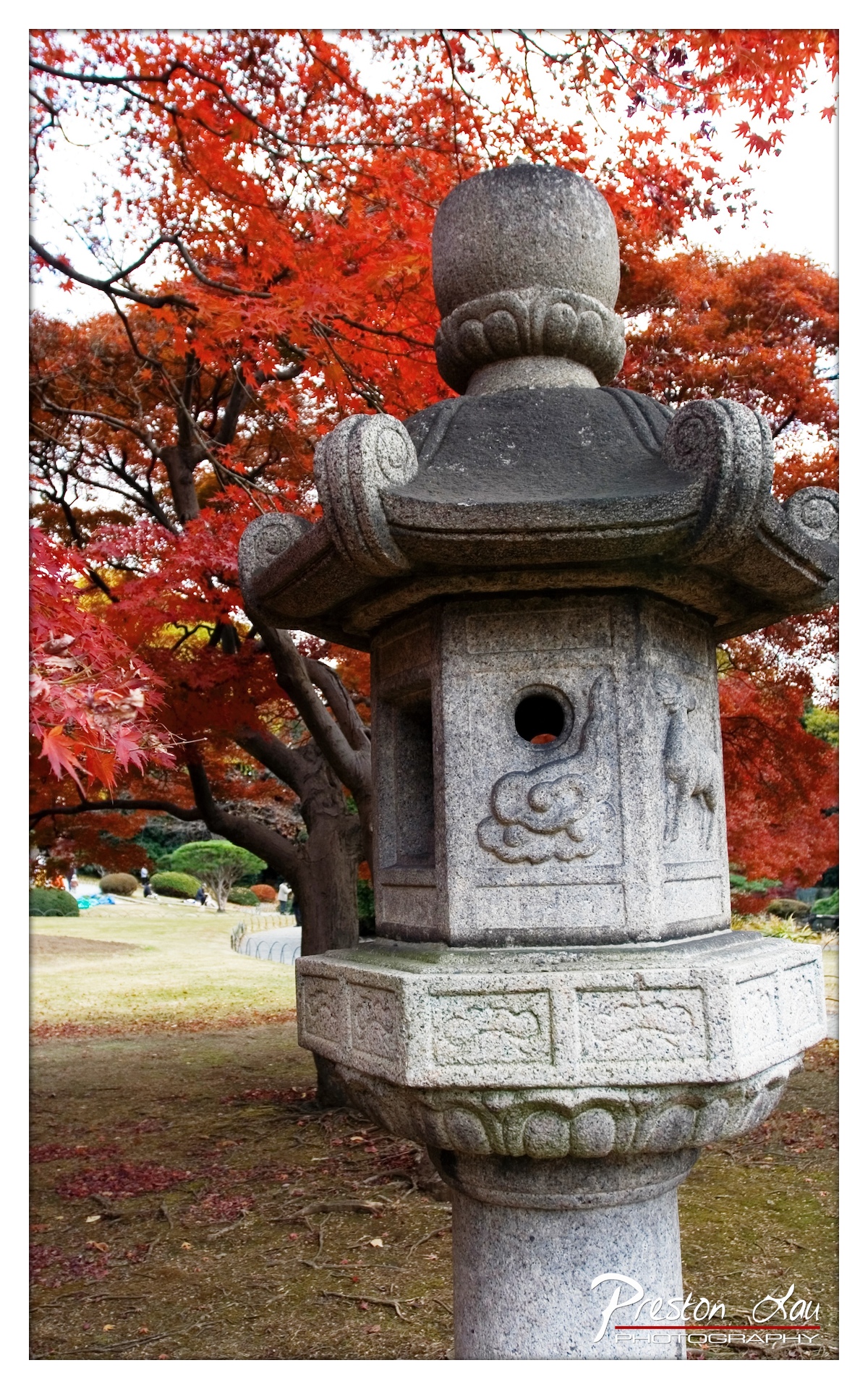

1. Overall Rating (0–10) — 8.0
This photograph captures the serene harmony of autumn in a Japanese garden, where the bold reds of maple leaves create a striking contrast against the weathered stone lantern. The composition draws the eye to the lantern as a symbol of tradition, while the soft, diffused light enhances the natural beauty of the season. While the image is rich in atmosphere and cultural resonance, a more deliberate use of depth of field could further isolate the subject and elevate the visual impact.
2. Composition (0–10) — 8.0
The lantern is well-placed off-center, creating a balanced and dynamic frame, while the surrounding red foliage adds depth and visual interest. The slight tilt of the lantern introduces a subtle asymmetry that enhances the organic feel of the scene.
3. Lighting (0–10) — 7.5
Soft, overcast light evenly illuminates the scene, preserving detail in both the lantern and the vibrant leaves without harsh shadows. The diffuse quality enhances the mood, lending a contemplative stillness to the image.
4. Color & Tone (0–10) — 9.0
The rich, saturated reds of the autumn foliage create a powerful contrast against the neutral gray of the stone, resulting in a visually arresting palette. The tonal balance is excellent, with the colors appearing natural yet vivid.
5. Creativity (0–10) — 8.0
The juxtaposition of ancient stone and seasonal color evokes a sense of timelessness and cultural continuity. The photographer’s choice to focus on a traditional element within a natural setting adds narrative depth and artistic intent.
6. Technical Quality (0–10) — 8.5
The image is sharp, with fine detail visible in the lantern’s carvings and the texture of the stone. The focus is precise, and the exposure is well-managed across the frame.
7. Emotional Impact (0–10) — 8.5
The image conveys a deep sense of peace and reverence for nature and tradition, inviting the viewer to pause and reflect. The autumnal colors and quiet setting evoke nostalgia and tranquility, creating a strong emotional resonance.
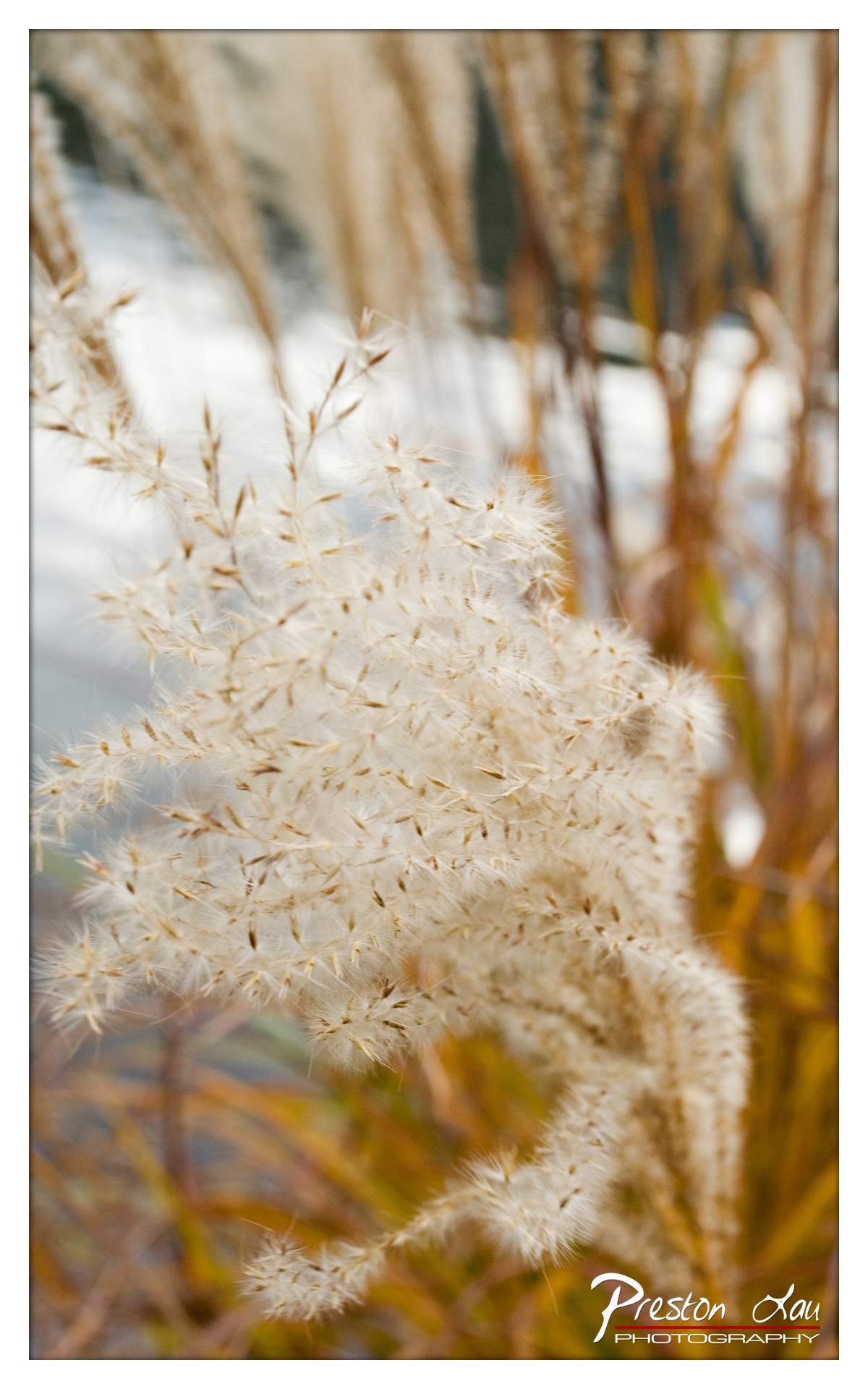

1. Overall Rating (0–10) — 7.5
This photograph captures the delicate, feathery texture of pampas grass with a soft, dreamlike quality that evokes the quiet stillness of late autumn. The shallow depth of field beautifully isolates the subject, drawing the viewer into the intricate details of the seed heads. While the composition is intimate and evocative, the muted color palette and slightly soft focus limit its visual impact, keeping it from feeling fully immersive.
2. Composition (0–10) — 7.0
The subject is well-placed, with the pampas grass filling the frame and drawing the eye naturally. The use of a shallow depth of field creates a pleasing bokeh that separates the foreground from the background, though the composition feels slightly unbalanced due to the off-center placement of the main cluster.
3. Lighting (0–10) — 7.5
Soft, diffused light enhances the natural texture of the grass, creating a gentle glow that emphasizes the delicate fibers. The lighting is even and flattering, with no harsh shadows, contributing to the image’s serene and contemplative mood.
4. Color & Tone (0–10) — 7.0
The palette is warm and harmonious, dominated by soft whites, creams, and golden browns that evoke a natural autumnal atmosphere. While the tones are cohesive, the overall image leans slightly toward a muted, desaturated look that could benefit from increased contrast and richness.
5. Creativity (0–10) — 8.0
The photographer has chosen an intimate, close-up perspective that highlights the quiet beauty of a common natural element. The focus on texture and light transforms a simple plant into a poetic subject, demonstrating a thoughtful and artistic approach to nature photography.
6. Technical Quality (0–10) — 8.0
The image is sharp where it matters—on the foreground pampas grass—while the background dissolves into a soft blur. The focus is precise, and the camera settings appear well-suited to the subject, resulting in a clean and well-executed technical outcome.
7. Emotional Impact (0–10) — 7.5
The photograph conveys a sense of calm and introspection, inviting the viewer to pause and appreciate the subtle beauty of nature. The softness and quietude of the scene evoke nostalgia and tranquility, making it emotionally resonant despite its simplicity.
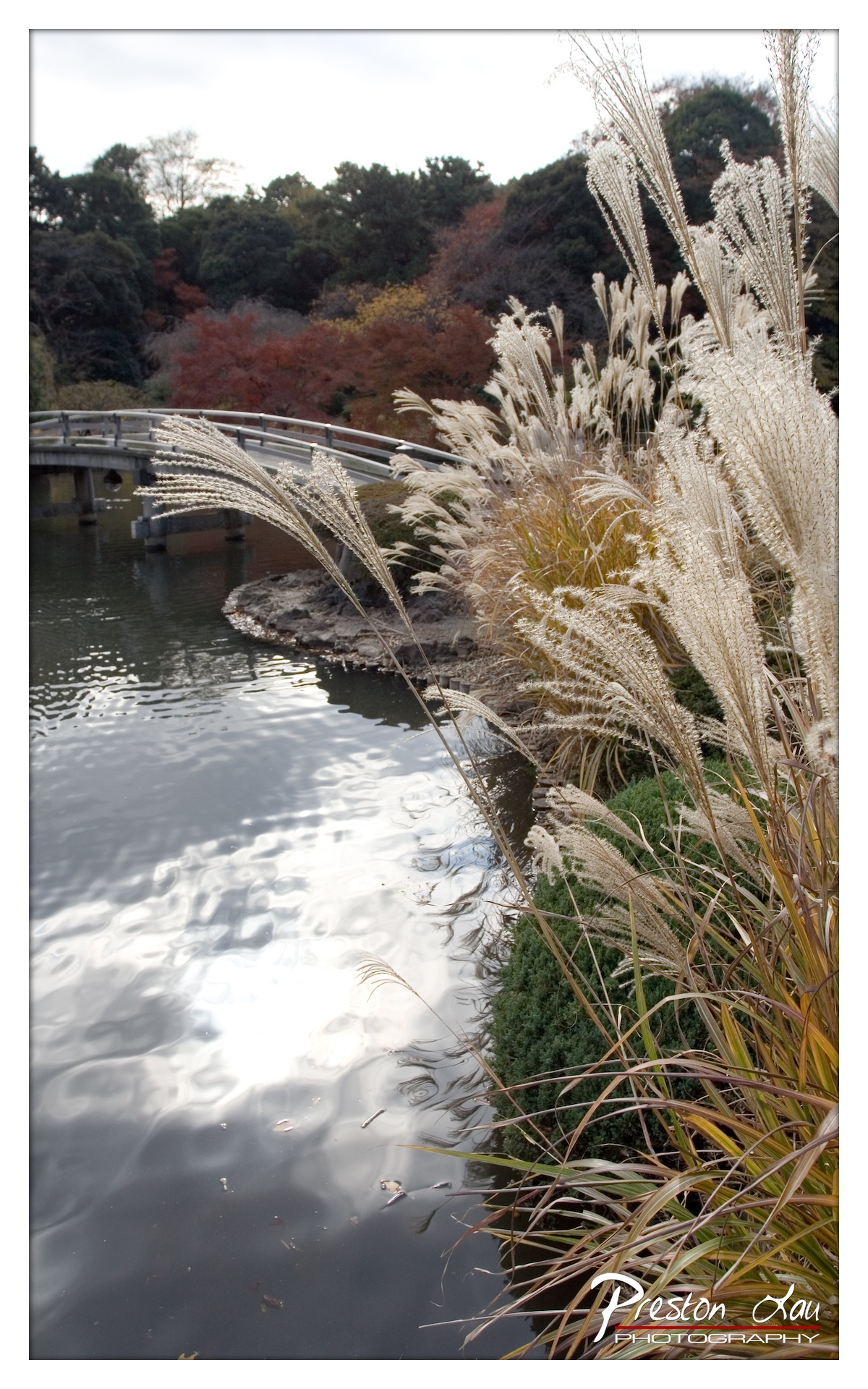

1. Overall Rating (0–10) — 7.5
This photograph captures the serene beauty of a Japanese garden in autumn, where delicate pampas grass frames a tranquil pond and a curved bridge recedes into a softly colored forest. The interplay of light on the water and the gentle movement of the grasses lend a meditative quality to the scene. While the image is compositionally strong and emotionally evocative, the slightly overcast lighting tempers its overall visual punch, preventing it from reaching full luminous potential.
2. Composition (0–10) — 8.0
The diagonal sweep of the pampas grass leads the eye from the foreground into the midground, guiding attention toward the bridge and the colorful trees beyond. The framing creates depth and balance, with the natural elements in the foreground grounding the composition while the background provides context and atmosphere.
3. Lighting (0–10) — 6.5
Soft, diffused light from an overcast sky creates even illumination across the scene, minimizing harsh shadows and enhancing the calm mood. However, the lack of direct sunlight results in muted highlights and a somewhat flat quality, especially in the water, where reflections are subtle rather than vibrant.
4. Color & Tone (0–10) — 7.0
The palette is harmonious, with the creamy whites and golds of the grasses complementing the deep reds and oranges of the autumn foliage. The cool tones of the water and sky provide a gentle contrast, creating a balanced and seasonally appropriate atmosphere.
5. Creativity (0–10) — 7.5
The photographer uses natural elements—grass, water, and the bridge—to compose a layered, narrative scene that feels both timeless and personal. The choice to emphasize the foreground textures while allowing the background to unfold gradually demonstrates a thoughtful approach to storytelling through landscape.
6. Technical Quality (0–10) — 8.0
The image is sharp and well-focused, with fine detail visible in the grasses and water ripples. The exposure is well-managed, preserving detail in both highlights and shadows, and the watermark is unobtrusive and professionally placed.
7. Emotional Impact (0–10) — 8.0
The photograph evokes a sense of peace and quiet contemplation, inviting the viewer to pause and reflect. The combination of natural textures, soft light, and autumnal colors creates a deeply calming and introspective mood, resonating with the quiet beauty of the season.
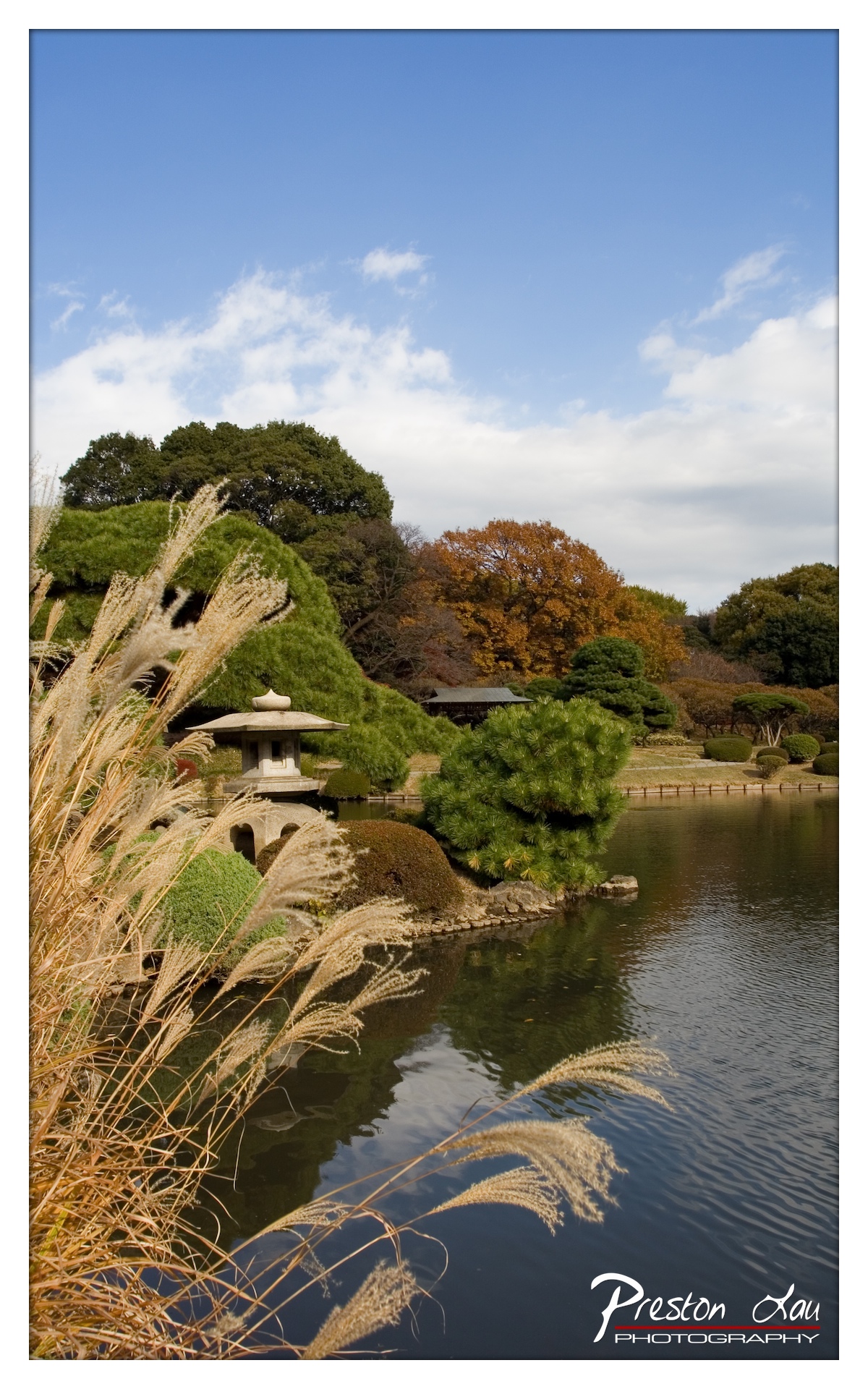

1. Overall Rating (0–10) — 8.0
This photograph captures the serene harmony of a traditional Japanese garden, where nature and design coexist in quiet balance. The golden grasses in the foreground frame the scene beautifully, leading the eye toward the stone lantern and the calm pond, while the autumnal trees and expansive sky add depth and seasonal warmth. The image succeeds in evoking tranquility and contemplation, though the slightly overexposed sky tempers its overall refinement.
2. Composition (0–10) — 8.5
The diagonal placement of the ornamental grasses creates a strong leading line, guiding the viewer’s gaze into the scene. The stone lantern and pond are well-positioned to create visual balance, with the layered elements—foreground, midground, and background—offering a sense of depth and perspective.
3. Lighting (0–10) — 7.5
Natural daylight enhances the scene’s clarity, with soft, directional light highlighting the textures of the grasses and foliage. The bright sky, however, shows slight overexposure, losing subtle cloud detail and slightly flattening the upper third of the frame.
4. Color & Tone (0–10) — 8.0
The palette blends earthy golds, deep greens, and the crisp blue of the sky, creating a harmonious and seasonally appropriate contrast. The warm autumn tones in the trees complement the cool blues and greens, producing a balanced and inviting color story.
5. Creativity (0–10) — 7.5
The photograph draws on classic Japanese garden aesthetics, but the deliberate use of foreground framing and depth of field gives it a thoughtful, narrative quality. It feels less like a snapshot and more like a composed meditation on place and season.
6. Technical Quality (0–10) — 8.5
The image is sharp throughout, with excellent focus on the midground elements. The watermark is unobtrusive, and the overall clarity and resolution are high, demonstrating strong technical execution.
7. Emotional Impact (0–10) — 8.0
The photograph evokes a deep sense of peace and stillness, inviting the viewer to pause and reflect. The quiet beauty of the garden, captured with intention and care, resonates emotionally, suggesting a moment suspended in time.
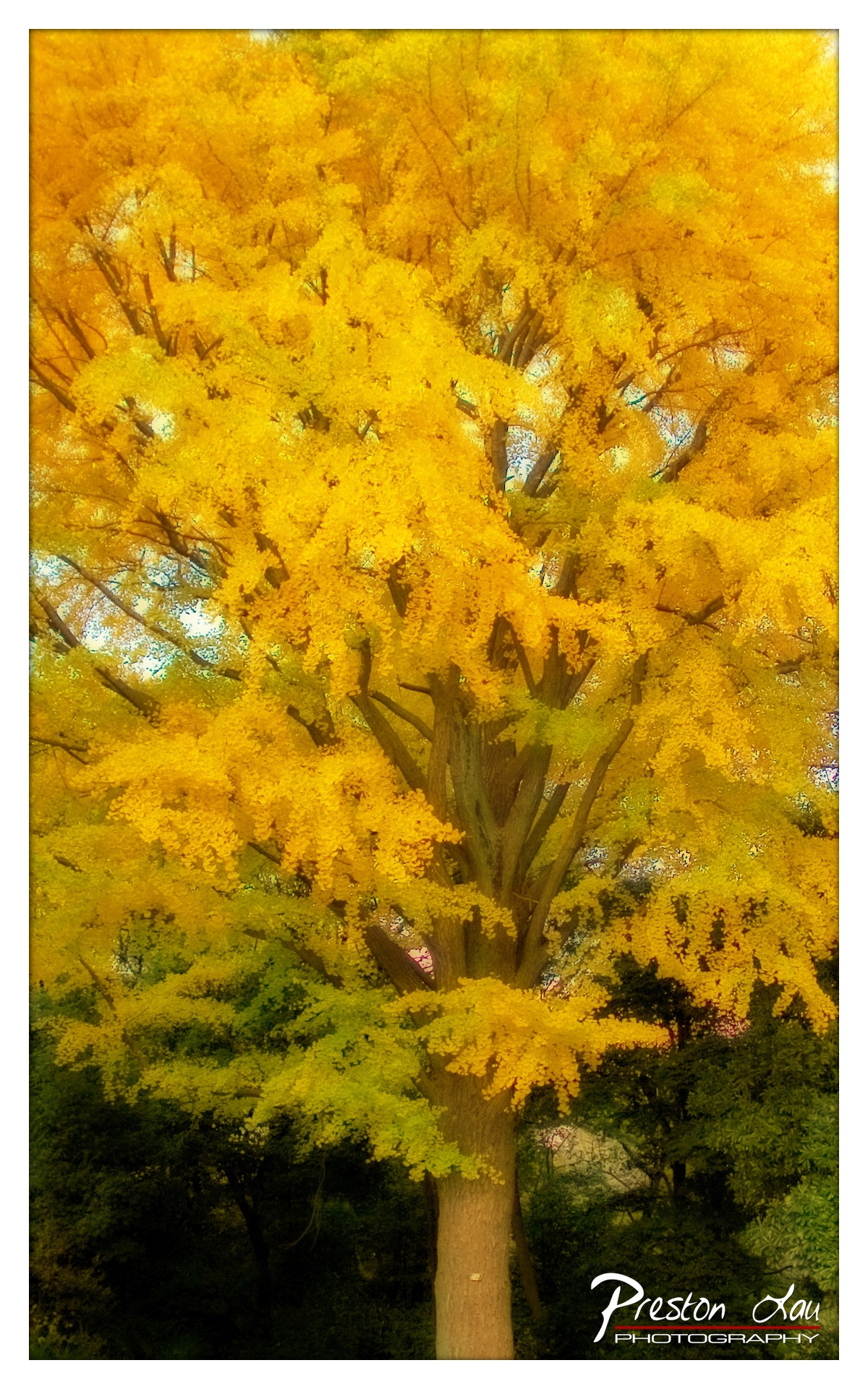

1. Overall Rating (0–10) — 7.5
This photograph captures the radiant splendor of a ginkgo tree in full autumn bloom, its golden canopy glowing with an almost ethereal intensity. The vibrant yellow dominates the frame, creating a powerful visual statement that celebrates the fleeting beauty of seasonal change. While the image is rich in color and mood, the heavy post-processing slightly obscures natural texture, giving it a painterly, almost digital quality that both enhances and detracts from its realism.
2. Composition (0–10) — 7.0
The tree is centered and fills the frame, emphasizing its grandeur and dominance in the scene. The slight tilt and framing from below create a sense of scale and dynamism, drawing the eye upward through the canopy. However, the dense foliage and lack of negative space reduce visual breathing room, making the composition feel crowded.
3. Lighting (0–10) — 8.0
The lighting appears to be soft and diffused, likely from an overcast sky, which evenly illuminates the tree and prevents harsh shadows. This diffuse light enhances the luminosity of the golden leaves, allowing their color to glow with warmth and depth. The subtle highlights peeking through the canopy add dimension and a sense of light filtering through.
4. Color & Tone (0–10) — 9.0
The color palette is striking—rich, saturated yellows dominate, contrasted with deep greens and dark shadows that ground the composition. The tonal range is well-balanced, with warm tones creating a sense of warmth and autumnal nostalgia. The saturation is high but controlled, giving the image a vivid yet cohesive look.
5. Creativity (0–10) — 8.0
The image transcends a simple nature photograph by transforming the tree into a radiant, almost mythical presence. The bold color treatment and emphasis on the canopy’s luminosity reflect a strong artistic vision. The subtle hints of digital enhancement add a dreamlike quality, suggesting a celebration of nature through an expressive lens.
6. Technical Quality (0–10) — 7.5
The photograph is sharp and well-focused, particularly on the tree trunk and lower canopy, with clear detail in the leaves. The post-processing appears intentional, but some loss of fine texture in the brightest areas suggests aggressive color grading. Overall, the technical execution supports the artistic intent.
7. Emotional Impact (0–10) — 8.0
The image evokes a sense of awe and wonder, capturing the beauty and transience of autumn with emotional resonance. The overwhelming golden hue stirs feelings of warmth, nostalgia, and reverence for nature’s seasonal cycles. The viewer is drawn into a moment of quiet contemplation, suspended in the tree’s radiant glow.
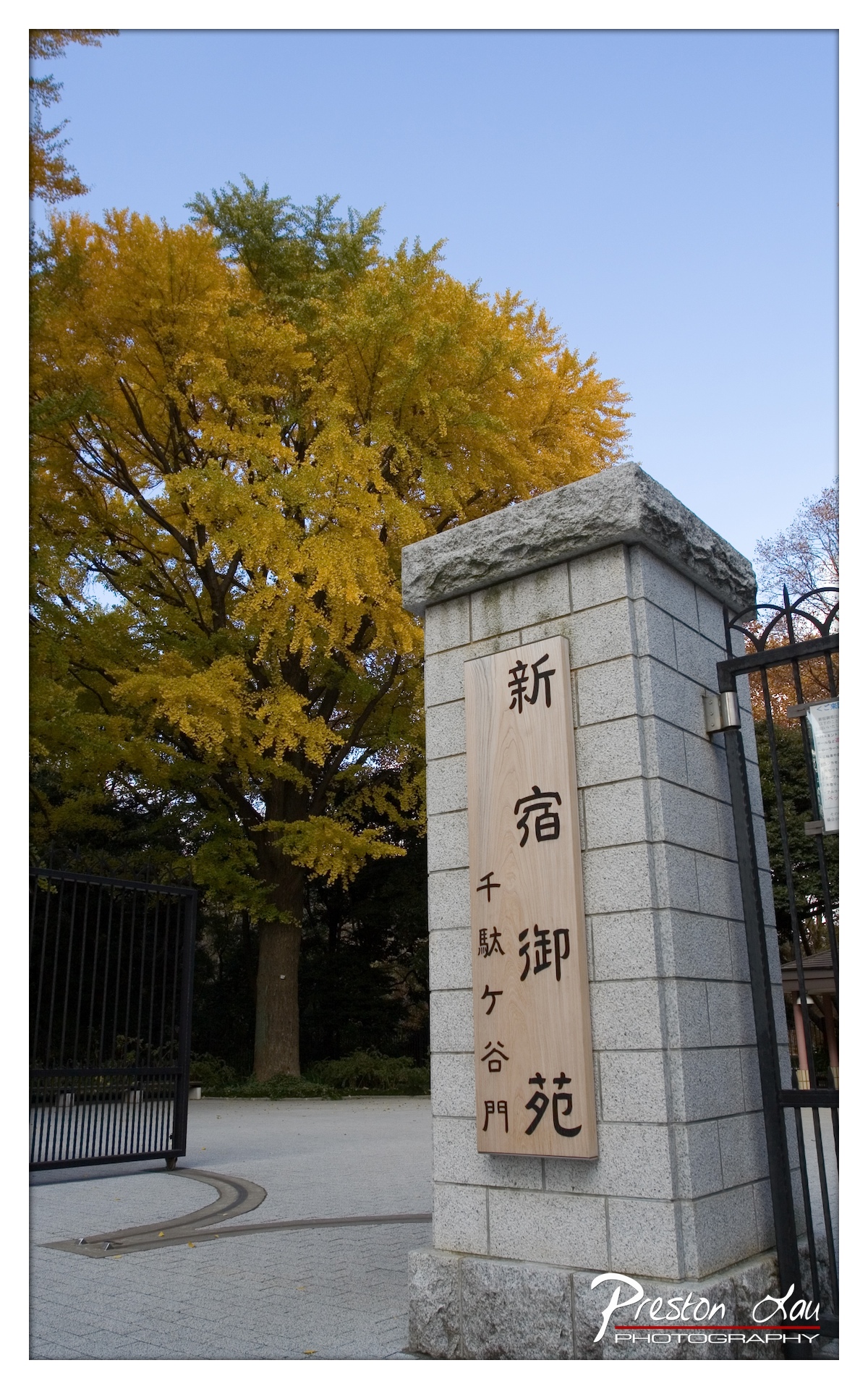

1. Overall Rating (0–10) — 7.5
This photograph captures the serene elegance of a Japanese garden entrance, where the vibrant gold of autumn foliage contrasts beautifully with the crisp blue sky and the understated stone architecture. The composition balances natural splendor with cultural identity, drawing the viewer into a moment of quiet reverence. While the image is strong in mood and color, its slightly low-angle perspective and the presence of the watermark detract from its overall refinement.
2. Composition (0–10) — 7.0
The low-angle view emphasizes the height of the sign and tree, creating a sense of grandeur. The sign is well-placed, drawing the eye, while the curving path and gate lead into the frame, guiding the viewer’s gaze. The tree’s full canopy dominates the left side, creating a natural asymmetry that feels intentional yet slightly unbalanced.
3. Lighting (0–10) — 8.0
Soft, even daylight enhances the rich golden tones of the ginkgo leaves and highlights the texture of the stone pillar. The clear sky provides a clean backdrop, allowing the colors to pop without harsh shadows or overexposure.
4. Color & Tone (0–10) — 8.5
The warm yellow of the foliage contrasts beautifully with the cool blue sky and the neutral gray of the stone, creating a harmonious and visually striking palette. The natural saturation enhances the autumnal mood without appearing oversaturated.
5. Creativity (0–10) — 7.5
The image successfully blends cultural elements with seasonal beauty, using the sign and tree as symbolic anchors. The choice to frame the scene this way emphasizes both place and season, offering a quiet narrative of transition and permanence.
6. Technical Quality (0–10) — 8.0
Sharp focus across the frame, with clear detail on the wooden sign and stone texture. The image is well-exposed, with no visible noise or distortion, though the watermark slightly disrupts the visual integrity.
7. Emotional Impact (0–10) — 7.0
The photograph evokes a sense of calm and contemplation, inviting the viewer to imagine stepping into a tranquil garden at the peak of fall. The combination of natural beauty and cultural signage creates a quiet emotional resonance, though the presence of the watermark slightly lessens the immersive quality.
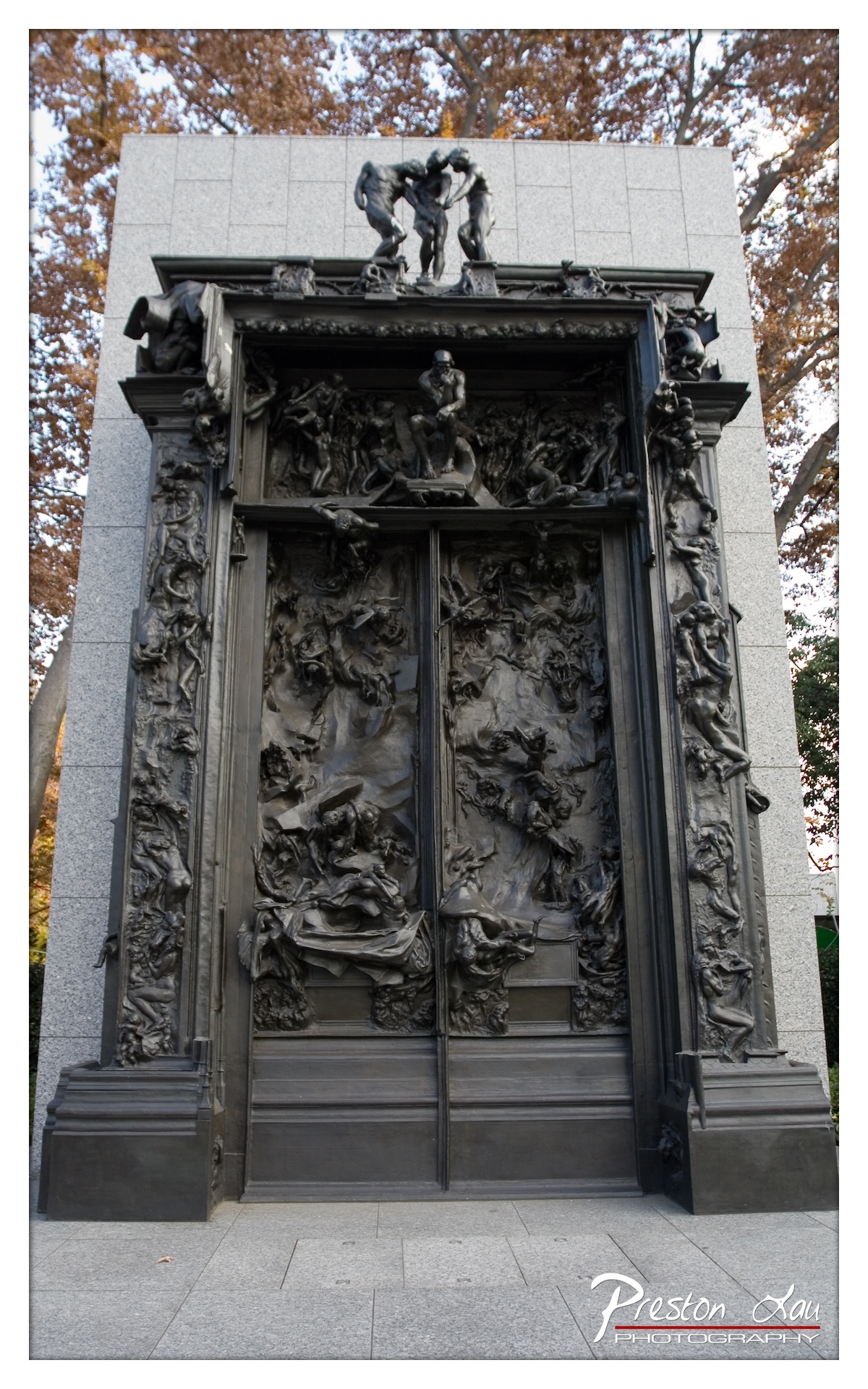

1. Overall Rating (0–10) — 8.0
This photograph captures the haunting grandeur of Rodin’s *The Gates of Hell*, a monumental sculpture rich with emotional and narrative depth. The composition frames the piece with reverence, allowing its intricate details and somber tone to command attention. While the lighting is somewhat flat, the image succeeds in conveying the monument’s imposing presence and the sculptor’s vision of human suffering and existential struggle. A stronger contrast and more dynamic lighting would elevate its emotional resonance.
2. Composition (0–10) — 8.0
The centered framing emphasizes the symmetry and verticality of the sculpture, drawing the eye upward toward the figures on the pediment. The surrounding stone pedestal and trees provide context without distracting, creating a balanced and grounded composition that honors the work’s architectural scale.
3. Lighting (0–10) — 6.0
The light is diffused and even, likely from an overcast sky, which minimizes harsh shadows but also flattens the three-dimensional texture of the bronze. While the details remain visible, the lack of dramatic contrast reduces the sense of depth and emotional intensity that the sculpture inherently evokes.
4. Color & Tone (0–10) — 7.0
The monochromatic palette of dark bronze against the gray stone creates a somber, cohesive tone. The autumnal foliage in the background adds a subtle warmth, providing a gentle contrast that enhances the sculpture’s dramatic mood without overwhelming it.
5. Creativity (0–10) — 7.5
The photographer captures a well-known cultural artifact with respect and clarity, focusing on the narrative richness of the sculpture. While not particularly innovative in approach, the image effectively communicates the monument’s scale and emotional gravity, making it both informative and visually compelling.
6. Technical Quality (0–10) — 8.5
The image is sharp and detailed, with clean focus across the sculpture’s surface. The exposure is well-balanced, and the composition is technically sound, allowing the viewer to appreciate the intricacy of the relief work.
7. Emotional Impact (0–10) — 8.0
The photograph conveys a sense of solemnity and awe, mirroring the emotional weight of Rodin’s work. The viewer is drawn into the scene, not just as an observer but as a participant in the silent narrative of suffering and contemplation that the sculpture embodies.
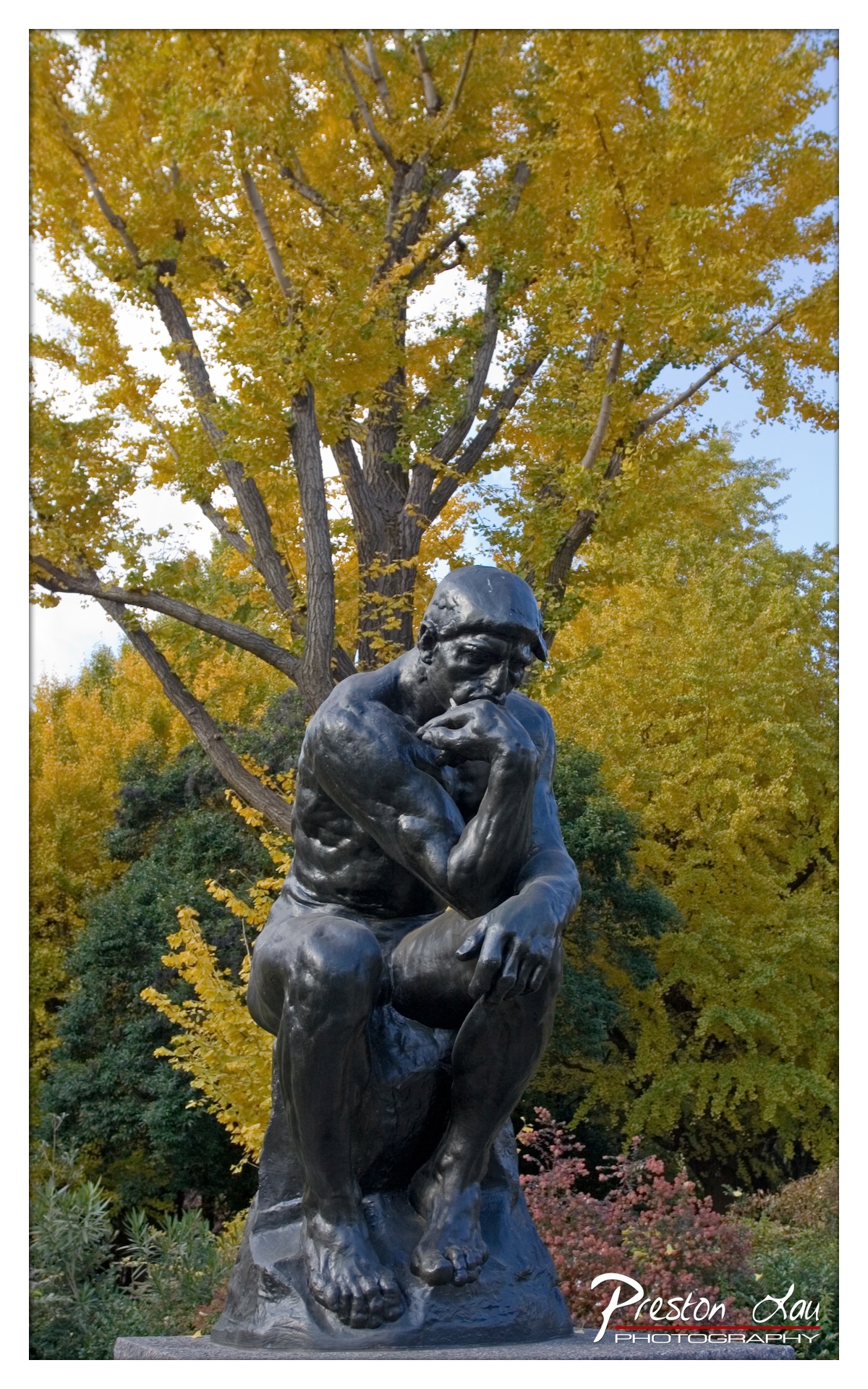

1. Overall Rating (0–10) — 7.5
This photograph captures the timeless contemplation of Rodin’s *The Thinker* against a vibrant autumn backdrop, where nature and art converge in quiet harmony. The rich golden foliage provides a striking contrast to the dark, brooding bronze, enhancing the statue’s introspective mood. While the image is visually compelling and well-composed, the slightly overexposed sky and busy lower foliage detract from the sculpture’s commanding presence.
2. Composition (0–10) — 7.0
The statue is centered and well-framed, drawing immediate attention, though the inclusion of the lower shrubbery and the photographer’s watermark slightly disrupts visual flow. The strong verticality of the tree complements the sculpture’s form, creating a balanced and grounded composition.
3. Lighting (0–10) — 7.5
Natural daylight enhances the texture and form of the bronze, with soft shadows defining the musculature. The bright sky is slightly overexposed, but the overall lighting is even and flattering, highlighting the sculpture’s contours without harsh glare.
4. Color & Tone (0–10) — 8.0
The warm golden yellows of the ginkgo leaves create a rich, autumnal palette that contrasts beautifully with the dark bronze and hints of red in the shrubs. The color harmony is strong, with a balanced contrast between warm and cool tones.
5. Creativity (0–10) — 7.0
The juxtaposition of a classic work of art with seasonal nature offers a fresh perspective, suggesting themes of time, thought, and change. While the concept is familiar, the seasonal context gives it a unique emotional resonance.
6. Technical Quality (0–10) — 8.0
The image is sharp and detailed, particularly in the texture of the sculpture. The focus is precise, and the dynamic range is well-managed, though the overexposed sky slightly reduces technical perfection.
7. Emotional Impact (0–10) — 8.0
The photograph evokes a sense of quiet reflection and melancholic beauty, inviting the viewer to pause and consider the weight of thought. The autumn setting enhances this mood, creating a poignant, contemplative atmosphere.
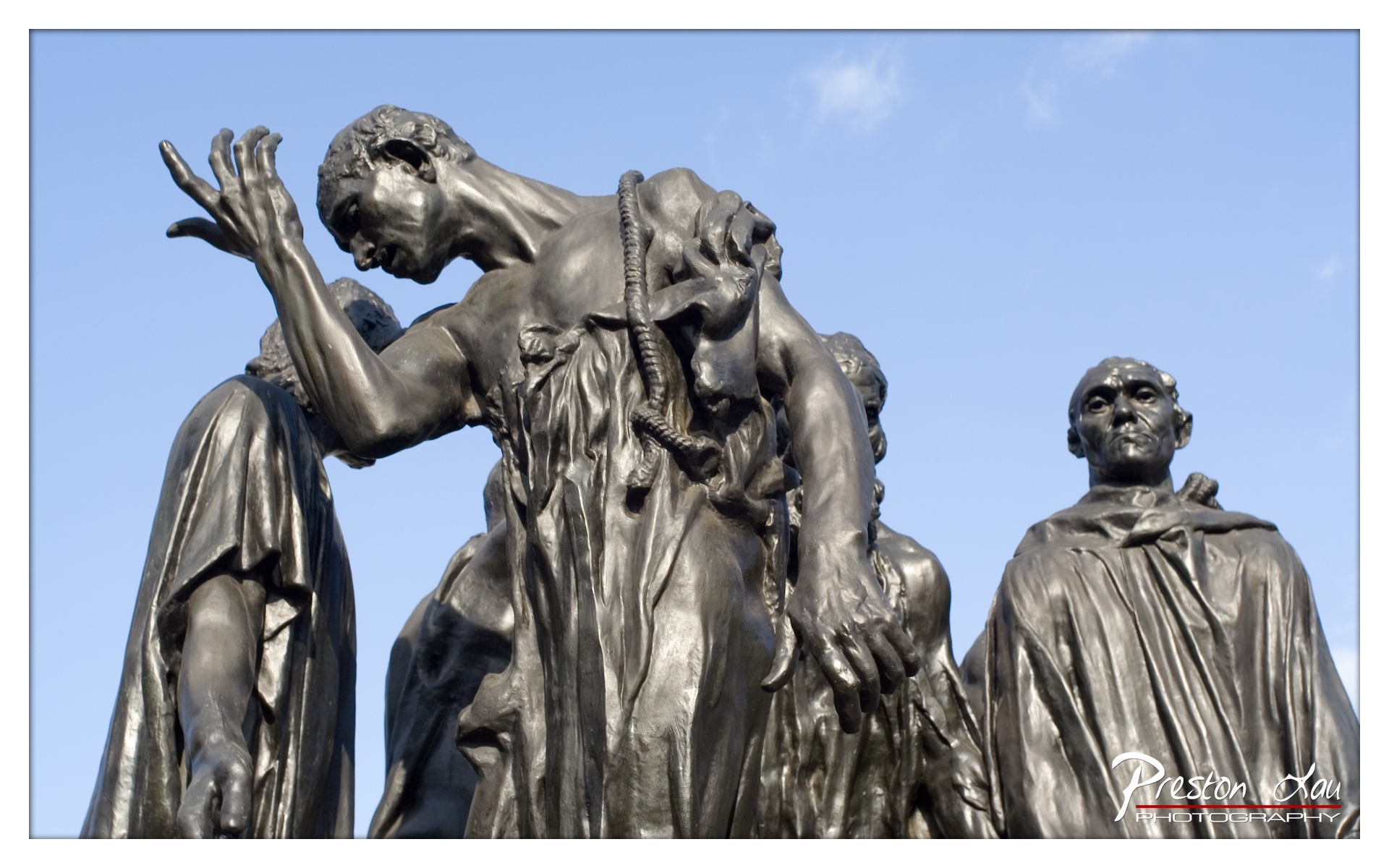

1. Overall Rating (0–10) — 7.8
This photograph captures the raw emotional intensity of a bronze sculpture, where figures appear to struggle under a weight of both physical and spiritual burden. The low-angle perspective amplifies the monumentality of the piece, while the clear blue sky provides a serene contrast to the turmoil depicted in the figures’ forms. While the image successfully conveys the sculpture’s dramatic tension, a more dynamic lighting condition or tighter framing could elevate its narrative power.
2. Composition (0–10) — 7.0
The low-angle shot emphasizes the scale and gravity of the sculpture, with the central figure’s outstretched arm leading the eye diagonally through the frame. The arrangement of figures creates a sense of movement and tension, though the rightmost figure slightly disrupts the visual balance due to its more static pose and placement.
3. Lighting (0–10) — 7.5
The natural daylight enhances the texture and depth of the bronze, casting subtle shadows that accentuate the muscular forms and drapery. The soft, even lighting avoids harsh contrasts, allowing the sculptural details to emerge with clarity and dignity.
4. Color & Tone (0–10) — 8.0
The monochromatic tones of the bronze harmonize beautifully with the pale blue sky, creating a balanced and cohesive palette. The cool tones lend a solemn, contemplative mood, while the slight tonal variation across the sculpture’s surface adds visual richness.
5. Creativity (0–10) — 8.0
The photographer’s choice to frame the sculpture against an open sky transforms a historical monument into a timeless, almost spiritual image. The interplay between the dark, textured figures and the vast, empty sky suggests themes of suffering, hope, and transcendence.
6. Technical Quality (0–10) — 8.5
Sharp focus and high resolution capture the intricate details of the sculpture, from the rope’s texture to the strained expressions. The exposure is well-balanced, preserving highlights and shadows without overexposure or loss of detail.
7. Emotional Impact (0–10) — 8.5
The image evokes a profound sense of struggle and resilience, inviting viewers to reflect on the human condition. The expressive poses and the sculpture’s narrative depth resonate with emotional weight, creating a powerful and contemplative experience.
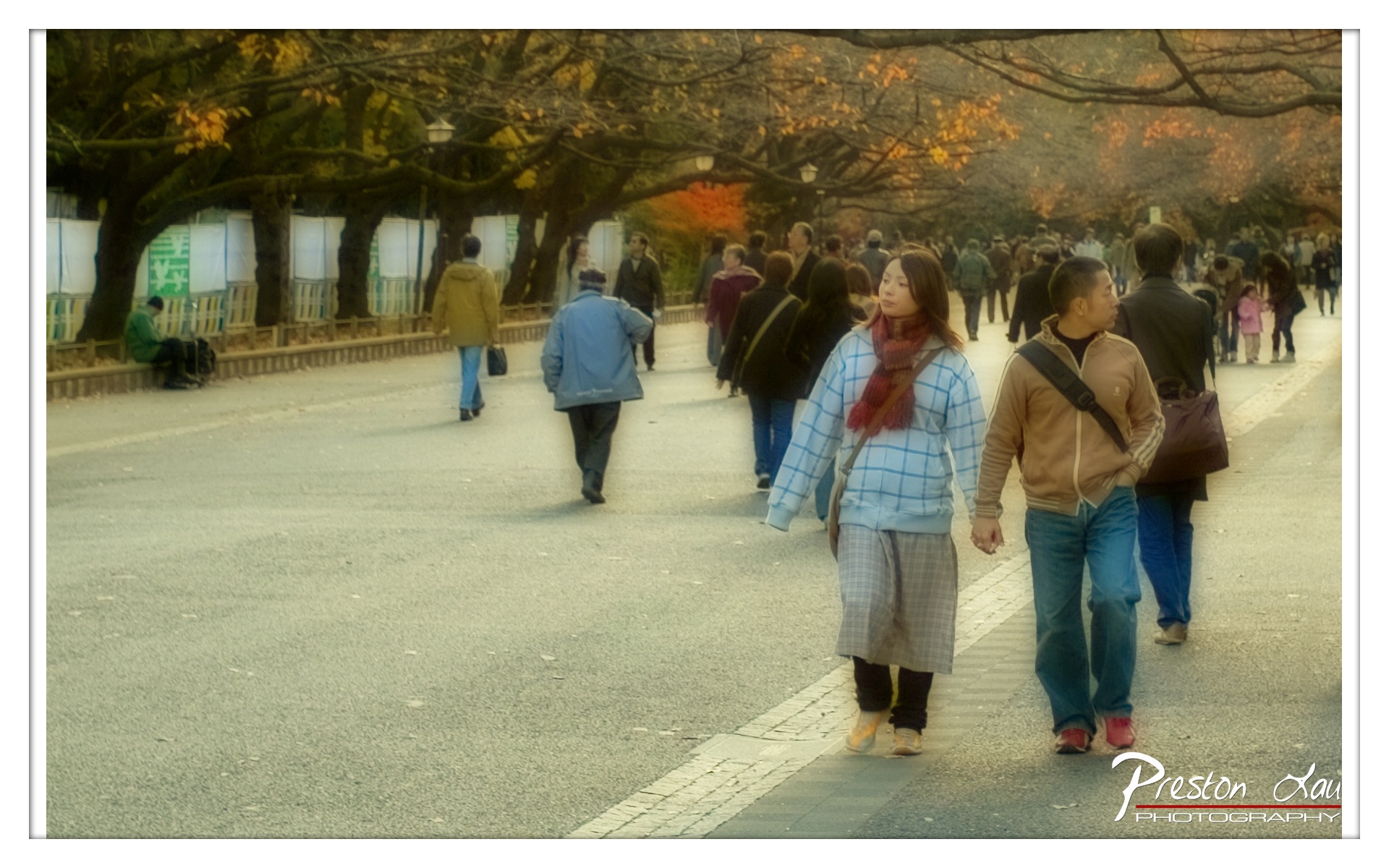

1. Overall Rating (0–10) — 7.0
This photograph captures the gentle rhythm of an autumnal stroll through a bustling park, where the warmth of golden light and the soft blur of movement evoke a sense of quiet passage. The couple in the foreground anchors the image with a subtle narrative of connection, while the surrounding figures and trees blur into a dreamlike tapestry of seasonal life. While the image’s mood is rich and evocative, its technical clarity and color balance hold back its full potential, lending it a slightly overprocessed quality that softens rather than sharpens its emotional resonance.
2. Composition (0–10) — 6.5
The couple is well-placed along the diagonal leading line of the path, guiding the eye through the frame, though the wide perspective dilutes the focus. The depth of field is shallow, but the surrounding figures are too numerous and indistinct, creating visual clutter that competes with the central subjects.
3. Lighting (0–10) — 7.5
The warm, golden-hour light bathes the scene in a soft glow, enhancing the autumnal atmosphere. The light direction is consistent, creating subtle highlights on the trees and figures, though some areas appear slightly overexposed, reducing detail in the highlights.
4. Color & Tone (0–10) — 6.5
The color palette leans heavily into warm yellows and oranges, reinforcing the seasonal mood, but the saturation feels slightly artificial, with a hazy, filtered quality that flattens the tonal range. The cool blue of the woman’s jacket provides a welcome contrast, though it’s muted by the overall warmth.
5. Creativity (0–10) — 7.0
The image successfully captures a fleeting, intimate moment within a public space, transforming a simple walk into a narrative of shared experience. The use of motion blur and selective focus adds a painterly, cinematic quality, elevating it beyond mere documentation.
6. Technical Quality (0–10) — 6.0
While the focus on the couple is reasonably sharp, the overall image appears soft, possibly due to lens choice or post-processing. The background is slightly out of focus, but the noise and lack of crispness in the mid-ground detract from the image’s clarity.
7. Emotional Impact (0–10) — 7.5
The photograph conveys a quiet intimacy and nostalgia, inviting the viewer to reflect on fleeting moments of connection. The warm light and soft focus create a wistful, contemplative mood, making the emotional resonance feel both personal and universal.


1. Overall Rating (0–10) — 7.0
This photograph captures the quiet dignity of a traditional Japanese shrine setting, where history and spirituality are conveyed through subtle details. The interplay of light and shadow enhances the solemnity of the scene, while the carefully composed elements—signboard, lantern, and surrounding architecture—create a narrative of cultural reverence. While the image is rich in atmosphere, its visual impact is slightly tempered by a lack of dynamic contrast and a somewhat subdued color palette.
2. Composition (0–10) — 7.5
The low-angle perspective emphasizes the signboard and lantern, creating a sense of depth and gravitas. The diagonal lines of the roof and the vertical alignment of the signboard guide the eye naturally through the frame, while the stone lantern acts as a strong visual anchor. The inclusion of the gate and background elements adds context without overwhelming the central subject.
3. Lighting (0–10) — 6.5
The late afternoon sun casts long, soft shadows that accentuate texture and form, particularly on the stone lantern and gravel ground. However, the lighting is somewhat uneven, with the signboard catching bright, direct light while the lantern and foreground remain in deeper shadow, reducing overall tonal harmony.
4. Color & Tone (0–10) — 6.0
The palette is muted and natural, dominated by earthy browns, dark wood tones, and the pale beige of the signboard. While the lack of vibrant color suits the contemplative mood, the overall tone feels slightly flat, with limited contrast between the light and dark areas.
5. Creativity (0–10) — 7.0
The photograph successfully blends documentary realism with aesthetic sensitivity, capturing a moment of stillness that invites reflection. The focus on textual and architectural elements suggests a narrative rooted in tradition and place, offering viewers a glimpse into a cultural landscape that feels both familiar and distant.
6. Technical Quality (0–10) — 7.5
The image is sharp and well-focused, with clear detail visible in the wood grain, stone texture, and calligraphy. The exposure is balanced overall, though the brighter areas of the signboard show slight overexposure. The watermark is unobtrusive and professionally placed.
7. Emotional Impact (0–10) — 7.0
The scene evokes a sense of peace and reverence, enhanced by the quiet stillness and historical weight of the setting. The viewer is drawn into a contemplative space, prompted to consider the stories and rituals embedded in the architecture and inscriptions. While not emotionally overwhelming, the image resonates with a quiet, enduring dignity.
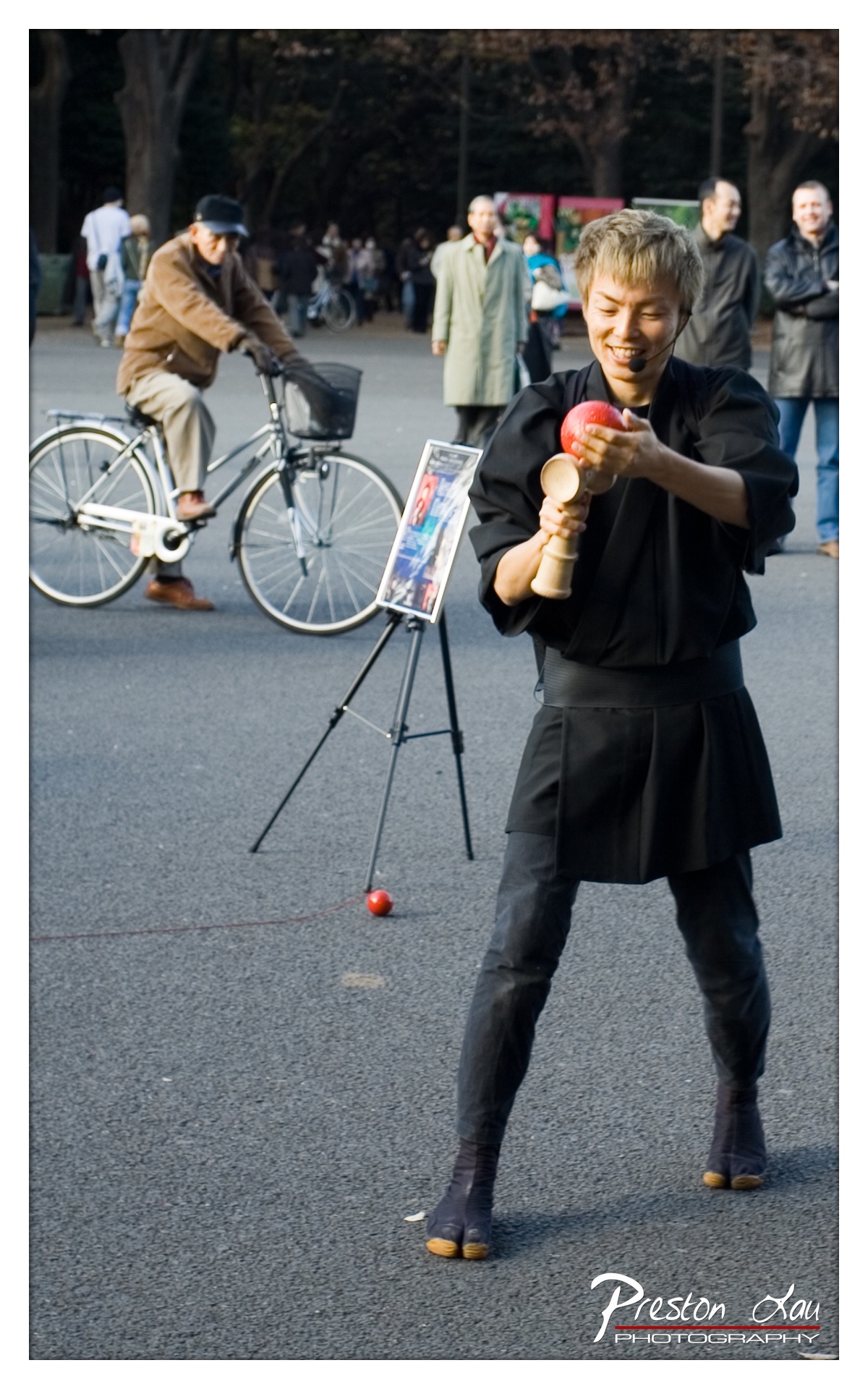

1. Overall Rating (0–10) — 7.0
This photograph captures a vibrant moment of cultural performance, where the joy and focus of a kendama artist are palpable against the backdrop of a bustling park. The subject’s expression and dynamic posture convey genuine engagement, while the shallow depth of field isolates him from the surrounding activity, creating a sense of intimacy. The scene is lively and authentic, though the framing feels slightly rushed, leaving the viewer with a snapshot of a fleeting performance rather than a fully composed portrait.
2. Composition (0–10) — 6.5
The subject is well-placed off-center, creating a sense of movement and spontaneity. However, the inclusion of the cyclist and background figures introduces visual noise, slightly distracting from the main action. A tighter crop would enhance focus on the performer.
3. Lighting (0–10) — 6.0
Natural, diffused light softens the scene and evenly illuminates the subject, though it lacks the warmth or drama that could elevate the mood. The shadows are minimal, contributing to a flat, documentary feel.
4. Color & Tone (0–10) — 6.5
The contrast between the bright red kendama and the dominant black attire creates a striking focal point. The overall palette is subdued, with earthy tones in the background and pavement, but the pop of color adds energy and visual interest.
5. Creativity (0–10) — 7.5
The image successfully captures a unique cultural moment with a sense of authenticity. The candid nature of the shot, combined with the subject’s expressive performance, gives it a narrative quality that feels both personal and universal.
6. Technical Quality (0–10) — 7.0
Sharp focus on the subject is well-executed, with clear detail in the hands and face. The background blur effectively separates the performer, though some noise is visible in the darker areas.
7. Emotional Impact (0–10) — 7.0
The subject’s genuine smile and concentration convey a sense of passion and joy, making the image emotionally resonant. The viewer is drawn into the performer’s world, even if only for a moment.
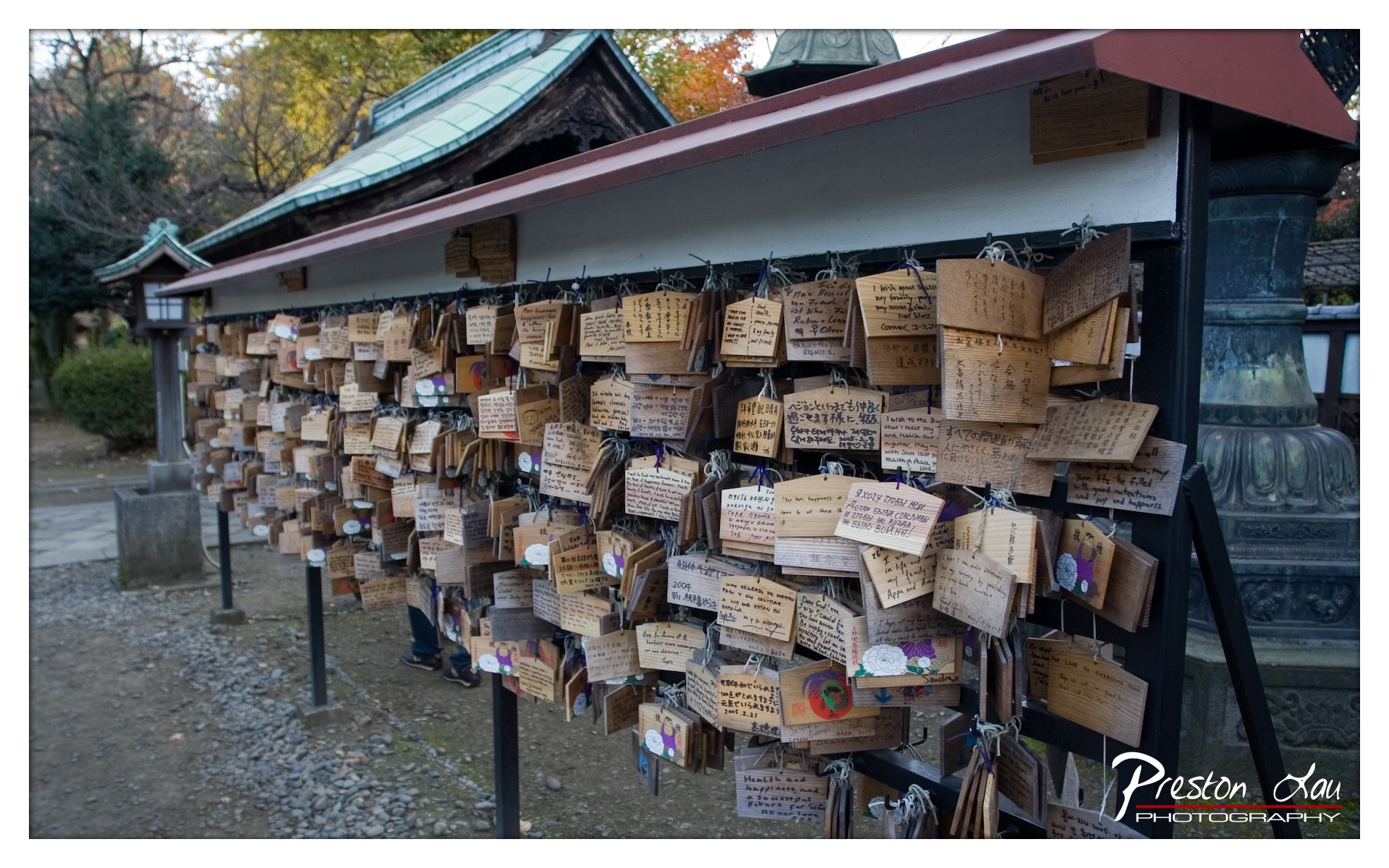

1. Overall Rating (0–10) — 7.0
This photograph captures the quiet reverence of a Japanese shrine, where countless wooden plaques—emblazoned with wishes and prayers—hang like a tapestry of human hope. The layered arrangement of the ema boards creates a textured, almost chaotic visual rhythm, evoking the weight of collective longing. While the scene is rich in cultural narrative, the composition’s density risks overwhelming the eye, and the muted lighting softens the emotional punch, leaving the image more observational than immersive.
2. Composition (0–10) — 6.5
The frame is anchored by the diagonal sweep of the ema boards, leading the eye from the lower right toward the shrine in the background. However, the left side feels underutilized, with a large, empty space that disrupts balance. A tighter crop would better focus attention on the emotional core of the image.
3. Lighting (0–10) — 6.0
Soft, diffused daylight bathes the scene in a calm, even tone, preserving detail across the wooden plaques. The lack of strong shadows or directional light lends a quiet, contemplative mood, but also diminishes contrast and depth.
4. Color & Tone (0–10) — 6.5
The palette is dominated by earthy browns and muted greens, with subtle hints of autumnal color in the background trees. The tonal range is restrained, giving the image a subdued, almost somber quality that matches the theme of quiet reflection.
5. Creativity (0–10) — 7.5
The image succeeds in capturing a deeply cultural and personal ritual—each plaque a small story. By focusing on the sheer volume of wishes, the photographer creates a compelling narrative about shared human desire, elevating the scene beyond a simple document to a meditation on hope.
6. Technical Quality (0–10) — 8.0
The focus is sharp across the midground, allowing clear readability of many inscriptions. The image is well-exposed with minimal noise, and the depth of field is appropriately managed to emphasize the ema boards.
7. Emotional Impact (0–10) — 7.0
There is a quiet power in the image’s stillness—the silence of unspoken prayers, the weight of time and memory. While the emotional resonance is subtle, it lingers, inviting the viewer to reflect on their own hopes and the universal nature of longing.
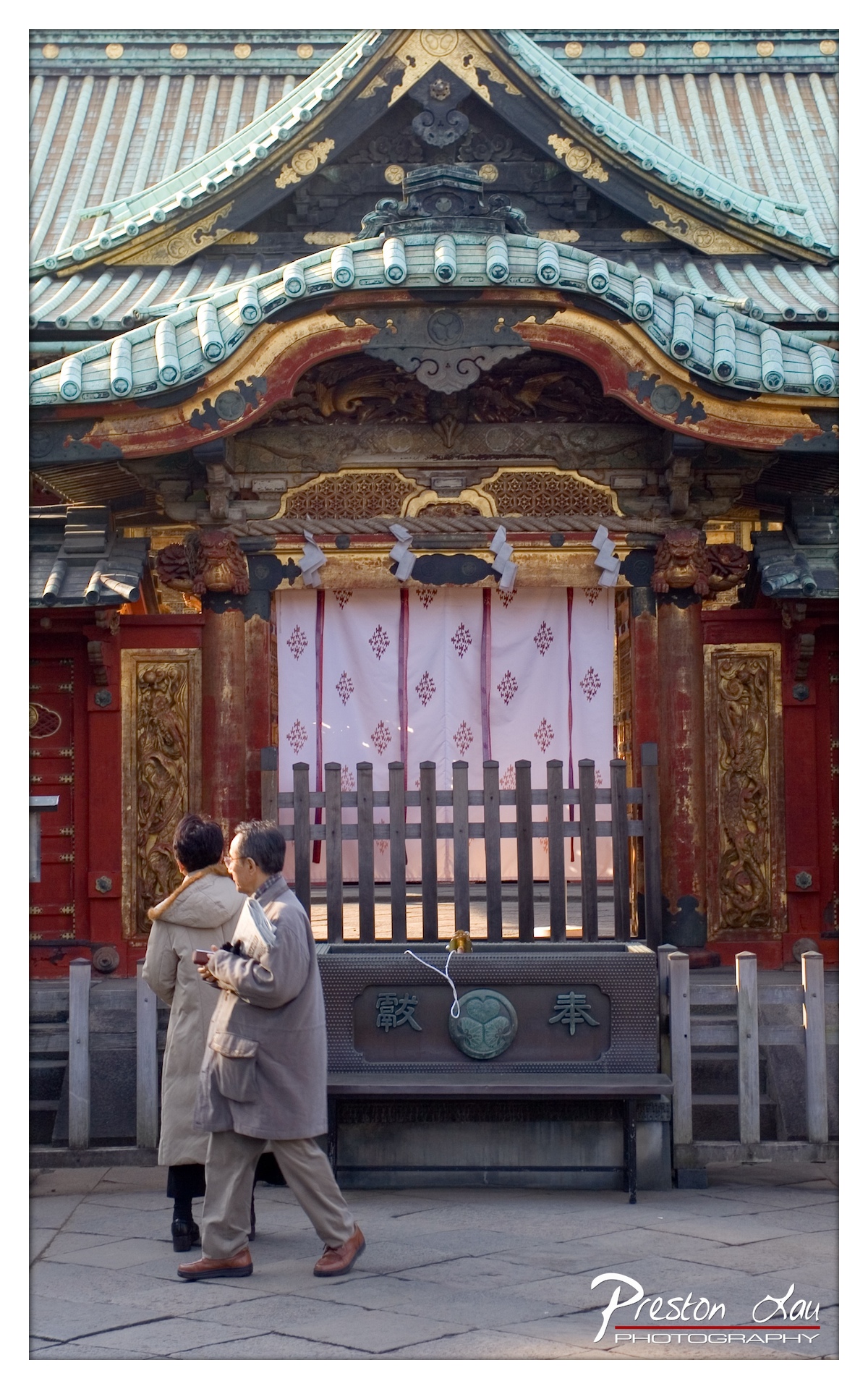

1. Overall Rating (0–10) — 7.5
This photograph captures a quiet moment of daily life unfolding before a richly detailed Japanese shrine, blending cultural authenticity with human presence. The interplay of traditional architecture and contemporary figures creates a narrative of continuity and reverence. While the image is visually compelling, a more dynamic composition and stronger tonal contrast could elevate its emotional resonance.
2. Composition (0–10) — 7.0
The subjects are positioned off-center, creating a natural flow that guides the eye toward the shrine’s ornate entrance. The wooden fence and stone lantern provide framing elements that add depth, though the wide shot slightly dilutes the focus on the central interaction.
3. Lighting (0–10) — 7.5
Soft, directional sunlight enhances the textures of the roof tiles, wood carvings, and fabric shide, casting subtle shadows that emphasize architectural detail. The light feels natural and enhances the serene mood without creating harsh contrasts.
4. Color & Tone (0–10) — 7.0
The warm reds and golds of the shrine contrast beautifully with the cool tones of the green tiles and muted winter clothing. The color palette feels authentic and harmonious, though slightly subdued, with a gentle warmth that suits the contemplative tone.
5. Creativity (0–10) — 7.5
The photographer captures a candid moment that feels both respectful and narrative-driven, blending cultural documentation with human storytelling. The inclusion of the passersby adds a layer of life and movement, transforming the image from a static architectural study into a living scene.
6. Technical Quality (0–10) — 8.0
Sharp focus across the frame, clean detail in both the foreground and background, and well-managed exposure contribute to a technically strong image. The slight grain and softness in the sky suggest natural lighting conditions rather than post-processing flaws.
7. Emotional Impact (0–10) — 7.0
The image evokes a sense of peace and reverence, capturing a fleeting moment of quiet devotion. The connection between the people and the sacred space, though unspoken, conveys a deep cultural familiarity and respect that resonates emotionally with viewers.
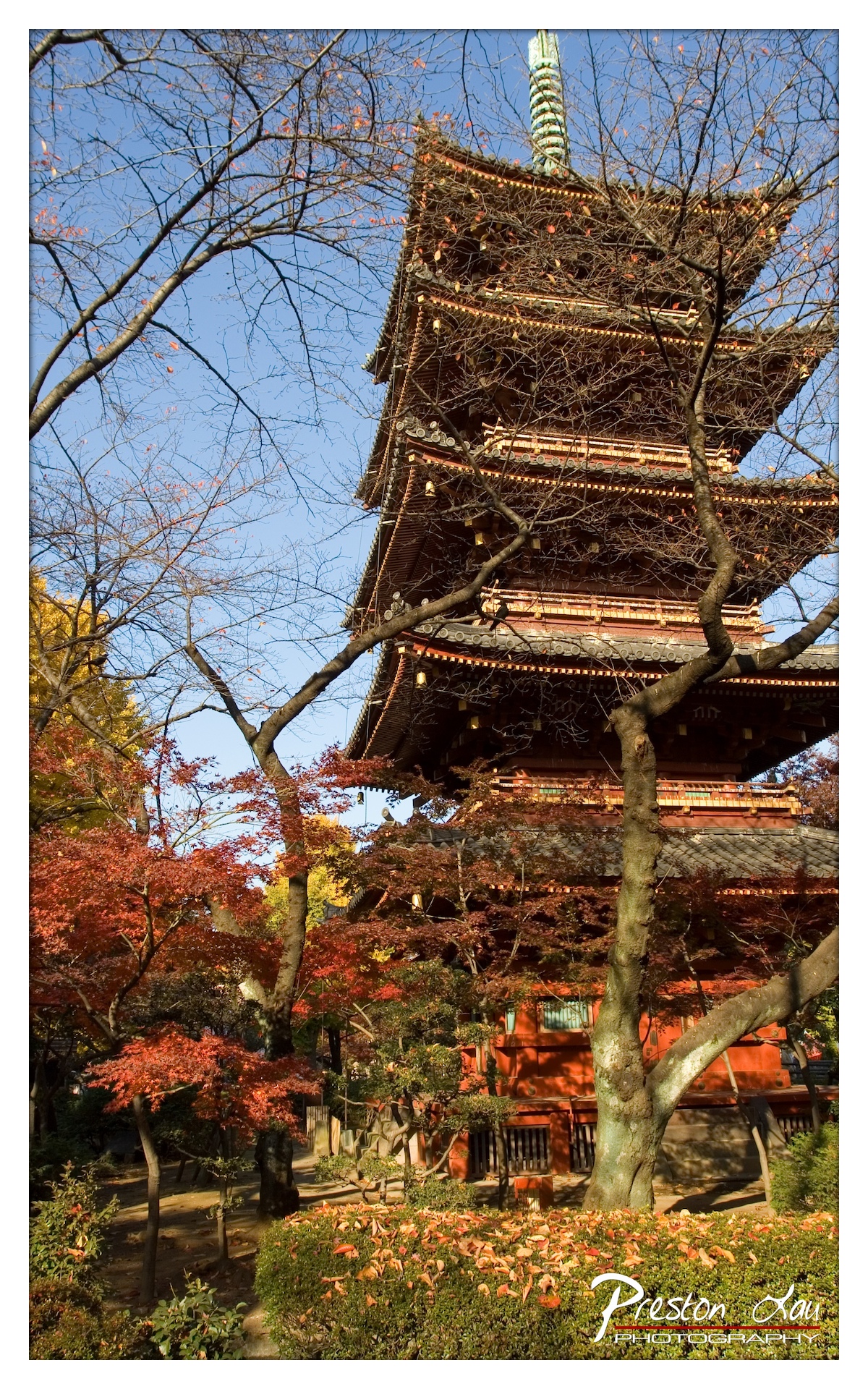

1. Overall Rating (0–10) — 8.0
This photograph masterfully captures the serene grandeur of a traditional Japanese pagoda framed by the vibrant colors of autumn. The interplay of warm reds and oranges against the deep blue sky creates a striking visual harmony, while the bare branches add a delicate, almost skeletal elegance. The image succeeds in evoking a sense of timelessness and cultural reverence, though the slightly heavy framing and watermark distract from its overall refinement.
2. Composition (0–10) — 8.5
The low-angle perspective emphasizes the pagoda’s height and architectural complexity, while the diagonal lines of the tree branches create a natural, dynamic frame. The placement of the pagoda slightly off-center adds visual interest and balances the composition with the surrounding foliage.
3. Lighting (0–10) — 8.0
Natural sunlight bathes the scene in a warm, golden glow, enhancing the autumn colors and casting soft shadows that define the structure’s layered eaves. The backlighting on the leaves adds depth and texture, while the clear blue sky provides a clean, contrasting backdrop.
4. Color & Tone (0–10) — 9.0
The rich, saturated reds and oranges of the autumn leaves stand out vividly against the deep blue sky and the warm terracotta tones of the pagoda. The tonal range is balanced, with a harmonious palette that feels both vibrant and cohesive.
5. Creativity (0–10) — 8.5
The photographer’s choice to frame the pagoda through the branches and foliage adds a narrative layer, suggesting a quiet, contemplative journey into a sacred space. The seasonal timing and natural framing elevate the image beyond a simple architectural portrait into a poetic meditation on nature and tradition.
6. Technical Quality (0–10) — 8.5
The image is sharp and well-focused, with fine detail visible in both the pagoda’s woodwork and the individual leaves. The exposure is well-managed, preserving highlights in the sky and shadows in the foreground. However, the watermark in the lower right corner slightly detracts from the visual purity.
7. Emotional Impact (0–10) — 8.0
The photograph evokes a profound sense of peace and reverence, inviting the viewer to pause and reflect on the beauty of cultural heritage and the changing seasons. The warmth of the light and the quiet stillness of the scene create a deeply meditative and emotionally resonant experience.
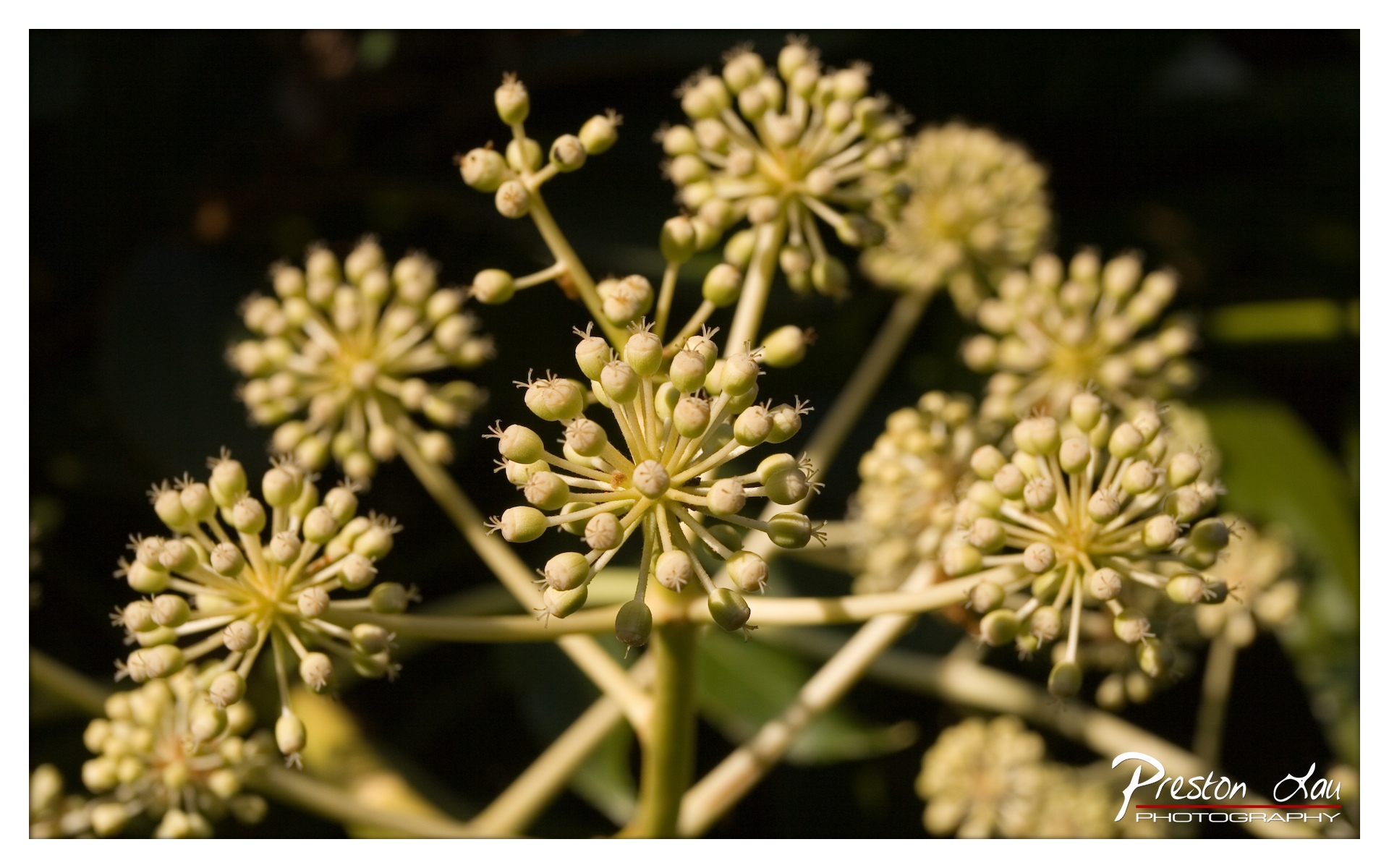

1. Overall Rating (0–10) — 7.5
This photograph captures the delicate complexity of a plant’s inflorescence with a sense of quiet elegance, where light and shadow play across the intricate clusters of buds. The shallow depth of field isolates the central bloom, drawing attention to its organic geometry and subtle textures. While the image is visually compelling, a slightly more dynamic lighting approach might enhance its emotional resonance and give the subject a greater sense of vitality.
2. Composition (0–10) — 7.0
The arrangement of the flower clusters creates a natural, radial balance, with the central bloom anchoring the frame. The diagonal lines of the stems add subtle movement, though the composition feels slightly dense, with overlapping elements that could benefit from more negative space to enhance clarity.
3. Lighting (0–10) — 8.0
The warm, directional light highlights the delicate structures of the buds, creating a soft glow that emphasizes their spherical forms. The use of backlighting enhances depth and texture, while the dark background provides strong contrast, focusing attention on the illuminated subject.
4. Color & Tone (0–10) — 7.5
The palette is harmonious, dominated by soft greens and yellows that evoke a natural, tranquil atmosphere. The tonal range is well-balanced, with the luminous flowers standing out against the deep shadows. A touch more saturation could enhance the vibrancy without compromising the image’s delicate mood.
5. Creativity (0–10) — 8.0
The photographer’s choice to focus on the micro-structure of the plant’s blossoms transforms a common natural subject into something intimate and contemplative. The selective focus and lighting choices reflect a thoughtful, artistic approach to macro botany.
6. Technical Quality (0–10) — 8.5
The image is sharp and well-focused on the central cluster, with precise control over depth of field. The clean capture of fine details, such as the stamen tips and bud textures, demonstrates strong technical execution.
7. Emotional Impact (0–10) — 7.0
The photograph evokes a sense of stillness and wonder, inviting the viewer to pause and appreciate the quiet beauty of nature’s design. While emotionally subdued, it carries a meditative quality that resonates with those attuned to the subtleties of the natural world.
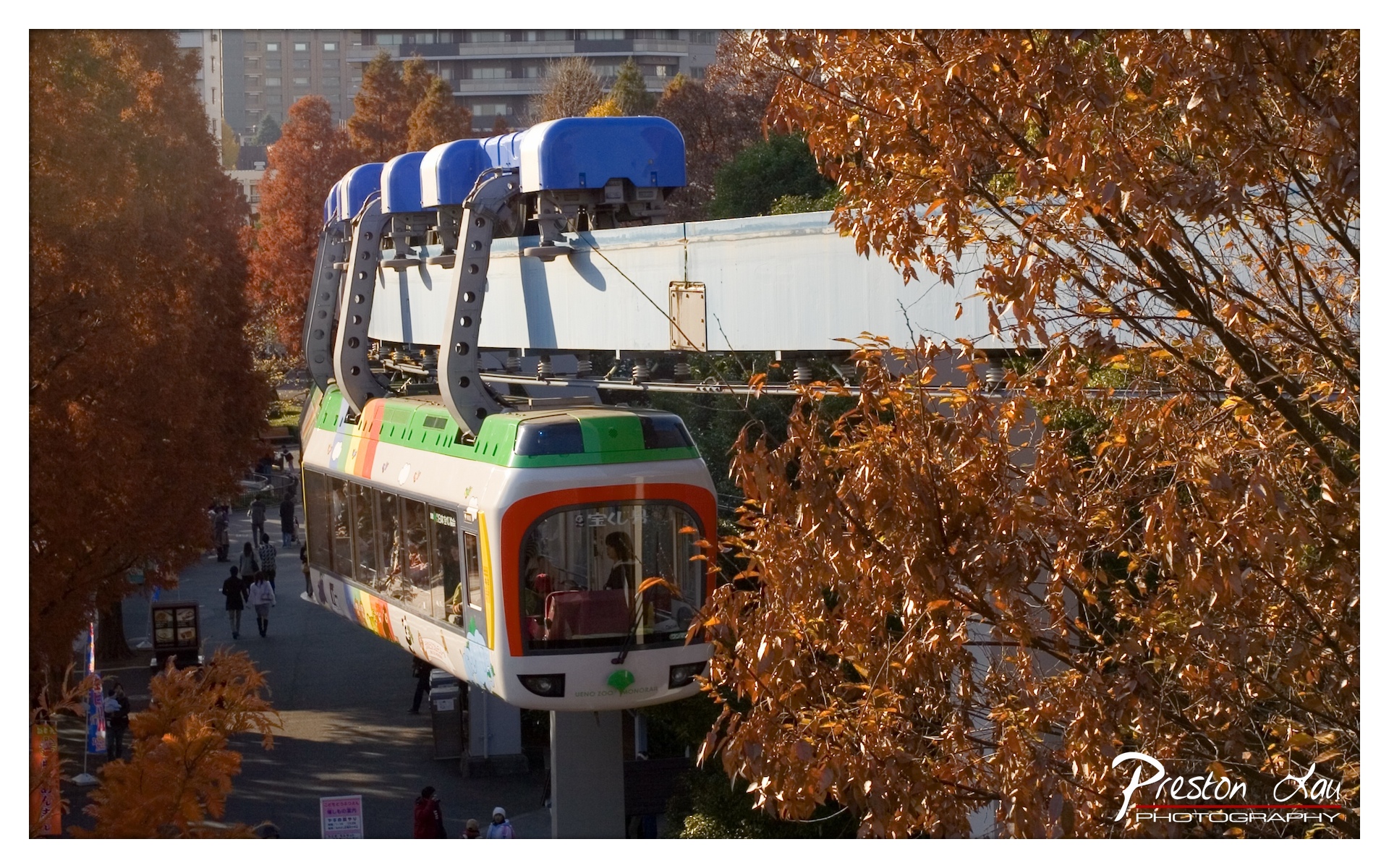

1. Overall Rating (0–10) — 7.5
This photograph captures a vibrant autumn day at Ueno Zoo, where the colorful cable car glides through a canopy of golden foliage, creating a harmonious blend of nature and urban transit. The warm sunlight enhances the rich fall tones, while the composition frames the scene with a sense of motion and life. While the image is visually engaging and well-captured, the framing slightly underplays the full narrative of the environment, keeping it from achieving greater depth.
2. Composition (0–10) — 7.0
The cable car is well-placed as the central subject, with the foreground foliage creating a natural frame. However, the slightly off-center alignment and the cluttered lower-left edge reduce visual balance, drawing attention away from the main subject.
3. Lighting (0–10) — 8.5
The golden hour sunlight bathes the scene in warm, directional light, enhancing the autumnal hues and creating soft shadows that add depth and dimension to the foliage and structure.
4. Color & Tone (0–10) — 8.0
The palette is rich with warm oranges and browns, complemented by the bright green, blue, and white of the cable car. The contrast between natural tones and man-made colors creates visual interest without appearing jarring.
5. Creativity (0–10) — 7.5
The image successfully merges urban infrastructure with seasonal beauty, offering a fresh perspective on a familiar scene. The choice to capture the cable car in motion within a natural setting adds a dynamic quality and a subtle sense of storytelling.
6. Technical Quality (0–10) — 8.0
The focus is sharp on the cable car, with clear detail visible in the windows and signage. The exposure is well-managed, preserving highlights in the foliage while retaining shadow detail in the lower portion of the frame.
7. Emotional Impact (0–10) — 7.0
The photograph evokes a sense of peaceful movement and seasonal change, inviting viewers to imagine the quiet joy of a stroll through a park in autumn. The warmth of the light and the colorful scene generate a gentle nostalgia, though the emotional resonance is slightly restrained by the lack of a more personal or human focal point.
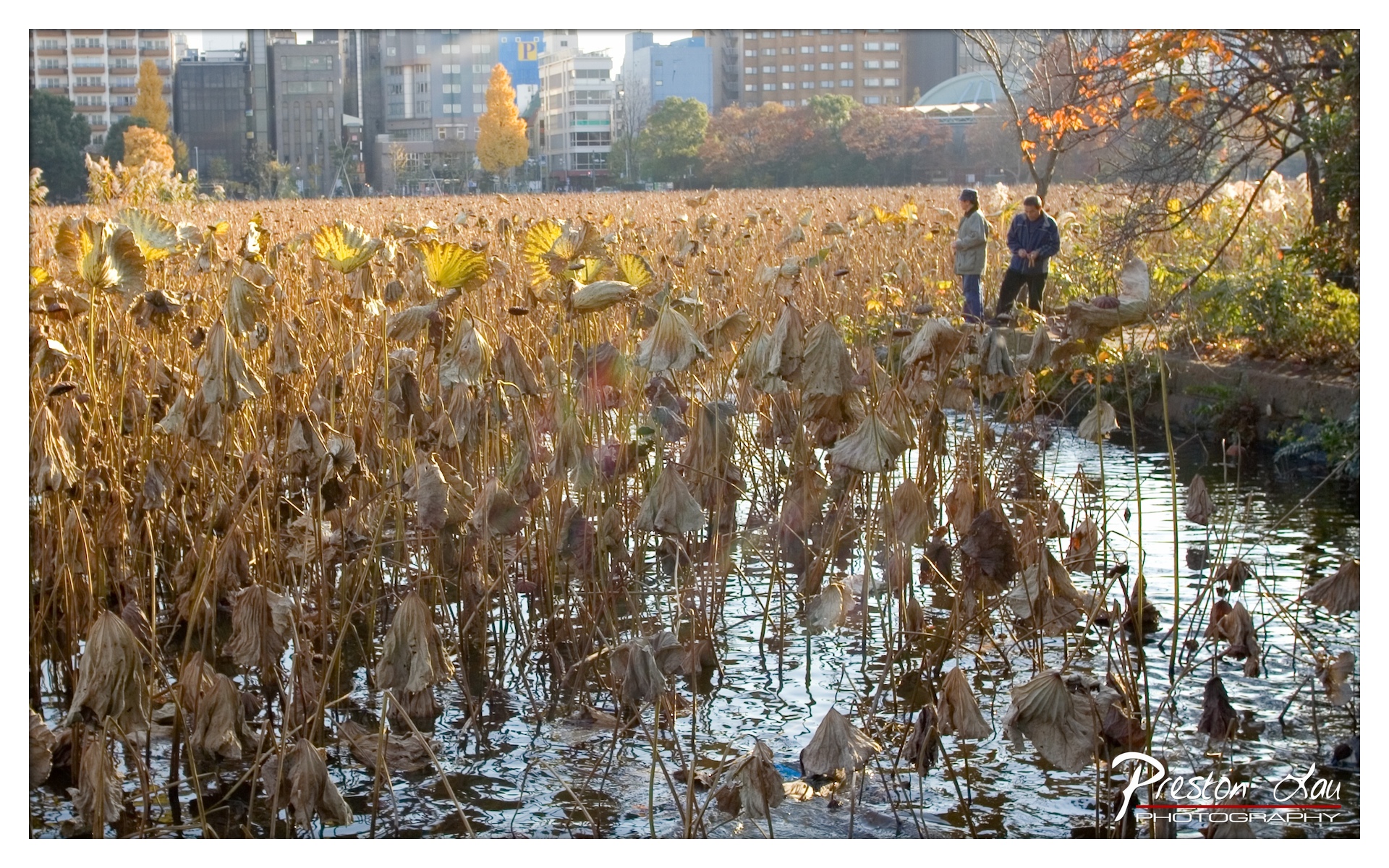

1. Overall Rating (0–10) — 7.0
This photograph captures a poignant contrast between urban encroachment and seasonal stillness, where the decay of lotus leaves in a city pond speaks to the passage of time. The warm sunlight and golden tones evoke a sense of melancholic beauty, while the distant figures add a quiet human element to the scene. Though the image is visually rich, its potential is slightly diminished by a lack of compositional refinement and a cluttered foreground that distracts from the central mood.
2. Composition (0–10) — 6.0
The foreground is dominated by dense, overlapping lotus stems that create visual noise, while the two figures are placed too far back, reducing their impact. A tighter crop or lower angle might have improved focus and balance.
3. Lighting (0–10) — 8.0
The late afternoon sun casts a warm, golden glow across the scene, highlighting the textures of the dried leaves and creating a soft, atmospheric haze. The backlighting enhances the silhouettes and adds depth, though some areas of the water are slightly overexposed.
4. Color & Tone (0–10) — 7.5
The palette is rich in autumnal tones—deep golds, browns, and muted oranges—creating a cohesive and seasonal mood. The contrast between the warm foreground and the cooler city backdrop adds visual interest, though the colors are slightly oversaturated in places.
5. Creativity (0–10) — 7.0
The juxtaposition of urban architecture with the natural decay of the lotus pond offers a thoughtful commentary on nature’s persistence. The image is more observational than conceptual, but its quiet narrative gives it a strong emotional undercurrent.
6. Technical Quality (0–10) — 7.5
The image is sharp and detailed, particularly in the midground, with good control over exposure and focus. The watermark is intrusive but does not detract from the technical integrity of the shot.
7. Emotional Impact (0–10) — 7.0
The scene evokes a contemplative, almost nostalgic mood, suggesting themes of impermanence and quiet resilience. The human figures, though small, ground the image in a sense of shared experience, inviting viewers to reflect on their own place within the changing seasons.
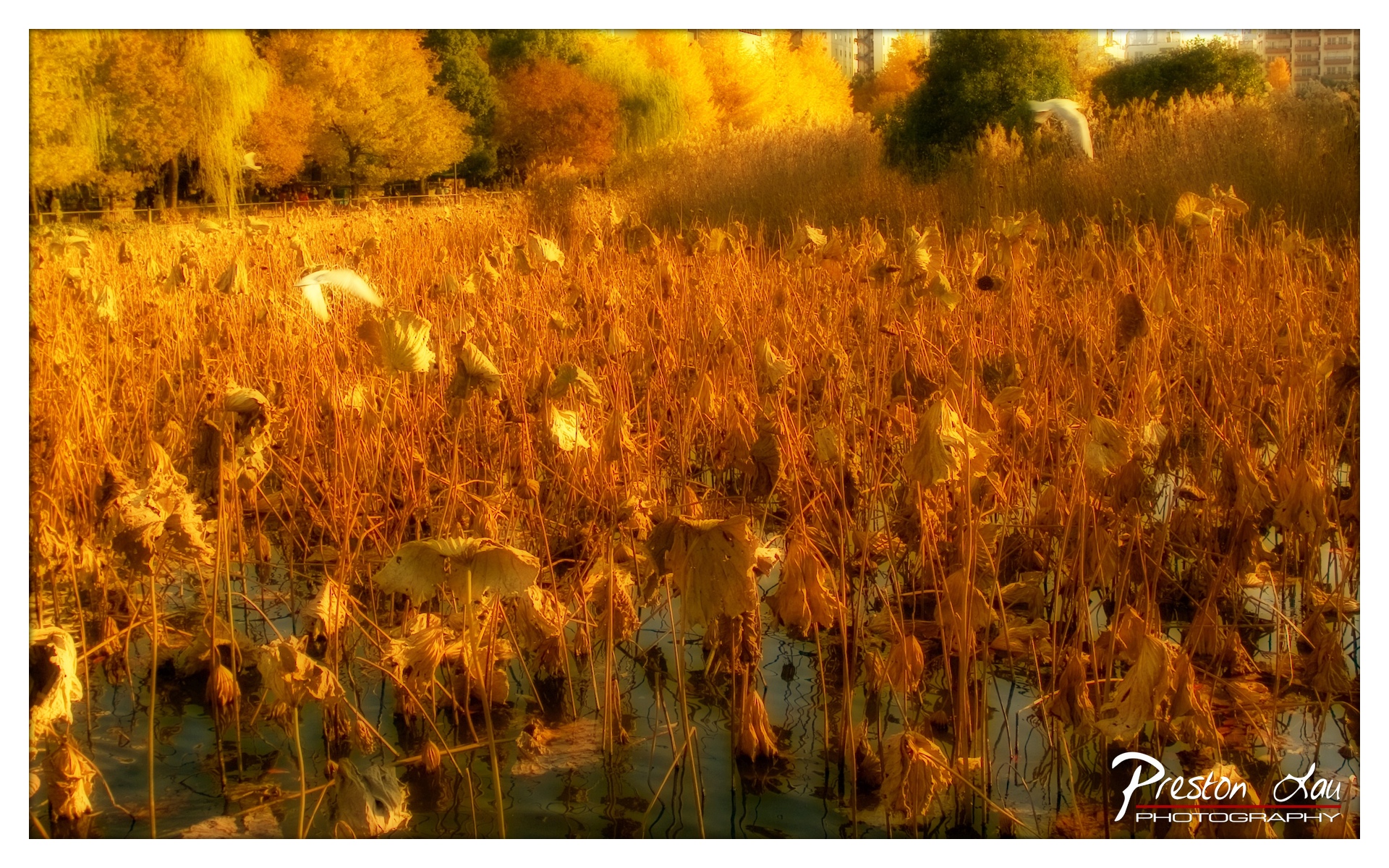

1. Overall Rating (0–10) — 7.5
This photograph captures the quiet melancholy of late autumn with a golden warmth that feels both nostalgic and meditative. The interplay of light and decay in the lotus field creates a dreamlike atmosphere, where the remnants of summer give way to winter’s stillness. While the heavy golden tint enhances the mood, it slightly sacrifices naturalism, lending the image a stylized quality that borders on overprocessed.
2. Composition (0–10) — 7.0
The frame is filled with dense vertical lines from the lotus stems, creating a textured foreground that draws the eye into the scene. The birds in motion add a sense of life and balance, though their placement in the upper right feels slightly distant, weakening their integration with the central mass of foliage.
3. Lighting (0–10) — 8.0
The warm, directional sunlight bathes the scene in a radiant golden glow, accentuating the textures of the dried leaves and creating a strong sense of time—likely late afternoon. The backlighting highlights the edges of the lotus pods and the birds in flight, enhancing their form and movement.
4. Color & Tone (0–10) — 8.0
The dominant golden and amber tones unify the image, creating a cohesive and immersive palette. The subtle contrast between the warm light and the dark water beneath adds depth, while the muted green and brown tones in the background provide grounding without distracting from the central warmth.
5. Creativity (0–10) — 8.0
The photographer has transformed a simple autumnal scene into a poetic meditation on transition and impermanence. The use of motion blur on the birds, combined with the saturated color treatment, gives the image a painterly, almost surreal quality that elevates it beyond a mere landscape.
6. Technical Quality (0–10) — 7.5
The image is sharp and detailed, with well-managed contrast and clarity in the foreground. The water’s reflection adds a layer of visual complexity, and the exposure is balanced despite the intense warmth. However, the extreme saturation suggests post-processing that may have compromised some tonal nuance.
7. Emotional Impact (0–10) — 8.5
There is a profound sense of calm and contemplation here—of nature’s cycles, of quiet endings, and of fleeting beauty. The golden haze and gentle movement of the birds evoke a serene melancholy, inviting the viewer to pause and reflect on the passage of time.
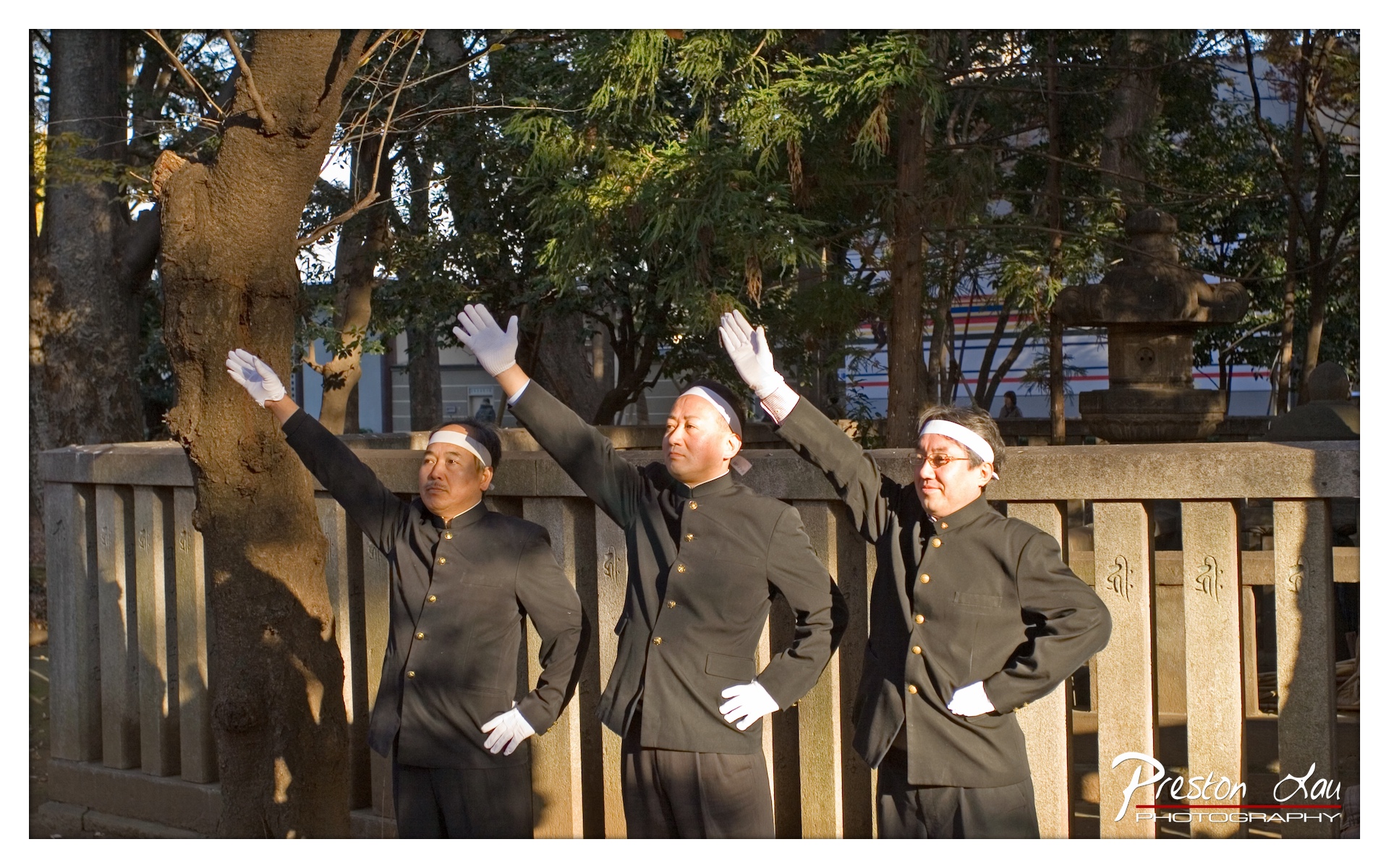

1. Overall Rating (0–10) — 7.0
This photograph captures a striking moment of ritualistic performance, where three men in uniform enact a synchronized gesture under the golden glow of late afternoon light. The composition balances cultural authenticity with visual drama, and the interplay of light and shadow gives the scene a ceremonial weight. While the background elements subtly intrude, the image succeeds in conveying both the solemnity and the theatricality of the moment.
2. Composition (0–10) — 7.5
The subjects are well-placed along a diagonal axis, creating dynamic movement from left to right. The tree on the left and the stone railing anchor the frame, while the open space above allows the raised arms to draw the eye upward, enhancing the sense of ritual.
3. Lighting (0–10) — 8.0
Warm, directional sunlight bathes the subjects in a golden hue, casting long shadows that add depth and texture. The backlighting highlights the edges of the figures and their white gloves, creating a luminous effect that emphasizes the gesture.
4. Color & Tone (0–10) — 7.0
The muted dark uniforms contrast effectively with the white gloves and headbands, while the natural greens and browns of the background provide a harmonious palette. The warm tone enhances the mood, though the color saturation is restrained, lending a documentary-like quality.
5. Creativity (0–10) — 7.5
The image captures a culturally specific moment with visual clarity and intention. The combination of traditional attire, formal pose, and natural setting suggests a deeper narrative, inviting curiosity about the ritual being performed.
6. Technical Quality (0–10) — 8.0
The focus is sharp across the subjects, and the exposure is well-balanced, preserving detail in both highlights and shadows. The watermark is minimal and unobtrusive, maintaining the image's integrity.
7. Emotional Impact (0–10) — 7.0
The image evokes a sense of reverence and shared purpose, with the men’s expressions and posture conveying quiet determination. The warmth of the light and the unity of their gestures create a subtle emotional resonance, connecting the viewer to the cultural moment.
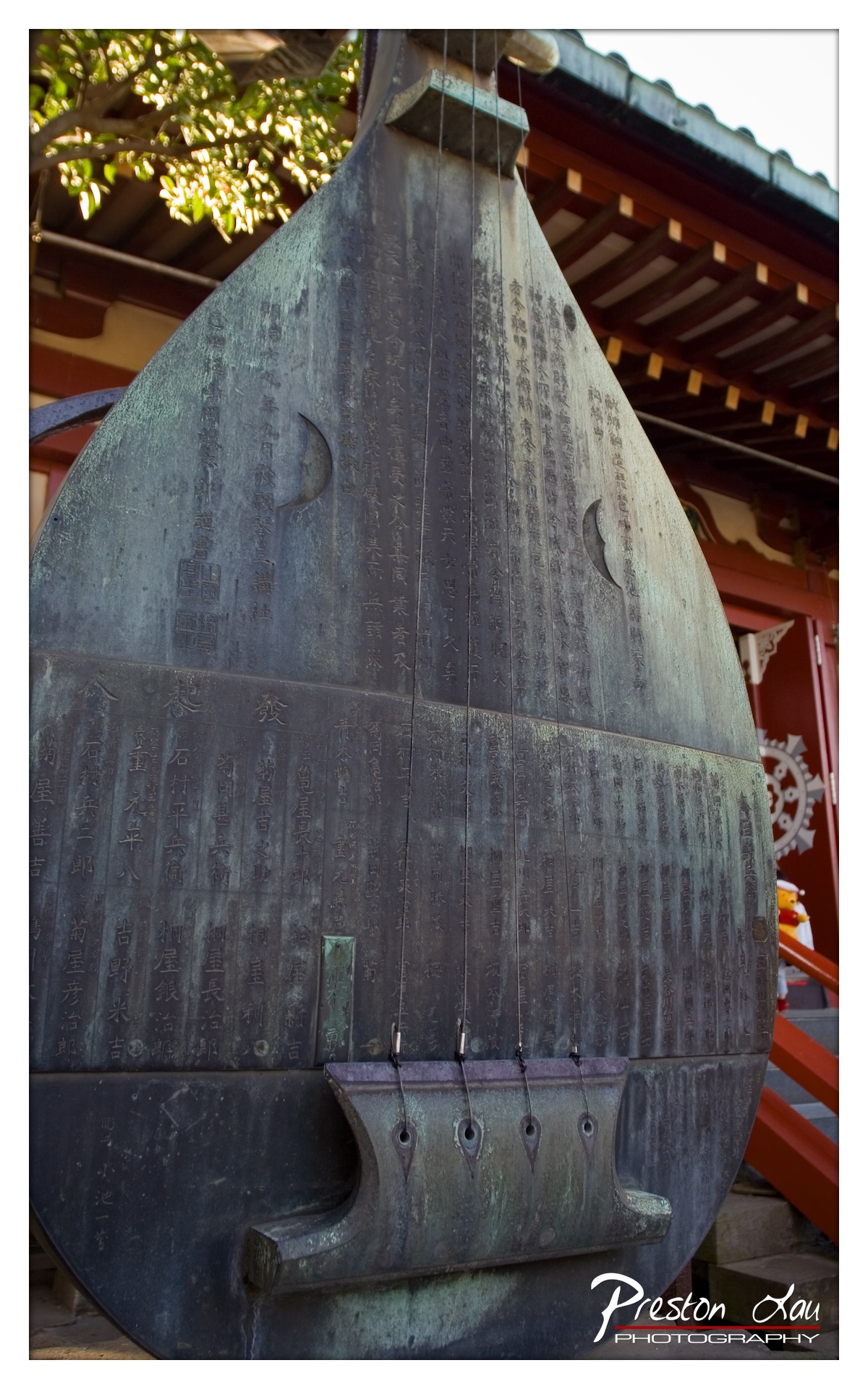

1. Overall Rating (0–10) — 7.5
This photograph captures the solemn elegance of a large, weathered Japanese koto, its surface etched with inscriptions that suggest both cultural significance and historical depth. The interplay of light on the aged metal, combined with the traditional architecture in the background, creates a contemplative mood that speaks to time and tradition. While the image is rich in texture and narrative, the tight framing and overexposed sky slightly diminish its visual harmony, preventing it from achieving full artistic cohesion.
2. Composition (0–10) — 7.0
The koto dominates the frame, with its vertical orientation drawing the eye upward. The slight tilt and off-center placement add visual interest, while the inclusion of the temple roof and foliage provides contextual depth. However, the composition feels slightly compressed, as the top of the instrument is cut off, and the right side lacks sufficient negative space to balance the visual weight.
3. Lighting (0–10) — 7.5
Natural light from the upper left highlights the texture of the metal and casts soft shadows along the inscriptions, enhancing legibility and depth. The bright sky above introduces a minor overexposure, but the highlights on the instrument itself are well-managed, giving the scene a crisp, sunlit quality.
4. Color & Tone (0–10) — 7.0
The palette is grounded in earthy greens and grays of the patinated metal, contrasted by the warm reds of the temple structure and the soft green of the foliage. While the colors are natural and harmonious, they lack vibrancy, resulting in a somewhat muted tone that reflects the aged subject but slightly dampens its visual impact.
5. Creativity (0–10) — 8.0
The photograph succeeds in capturing a moment of quiet reverence, using the instrument as a metaphor for cultural endurance. The choice to focus on the inscriptions adds a layer of storytelling, inviting the viewer to contemplate the names and history etched into the koto. The blend of cultural elements—music, architecture, and nature—demonstrates thoughtful composition and narrative intent.
6. Technical Quality (0–10) — 8.0
The image is sharp and detailed, particularly in the engraved text and the texture of the metal. The depth of field is appropriately managed, keeping the main subject in focus while softly blurring the background. The watermark is unobtrusive, and the exposure is generally well-balanced despite the challenging lighting conditions.
7. Emotional Impact (0–10) — 7.5
The photograph evokes a sense of reverence and nostalgia, inviting the viewer to reflect on the passage of time and the enduring legacy of cultural artifacts. The quiet stillness of the scene, combined with the human touch in the inscriptions, creates a subtle emotional resonance that lingers beyond the frame.
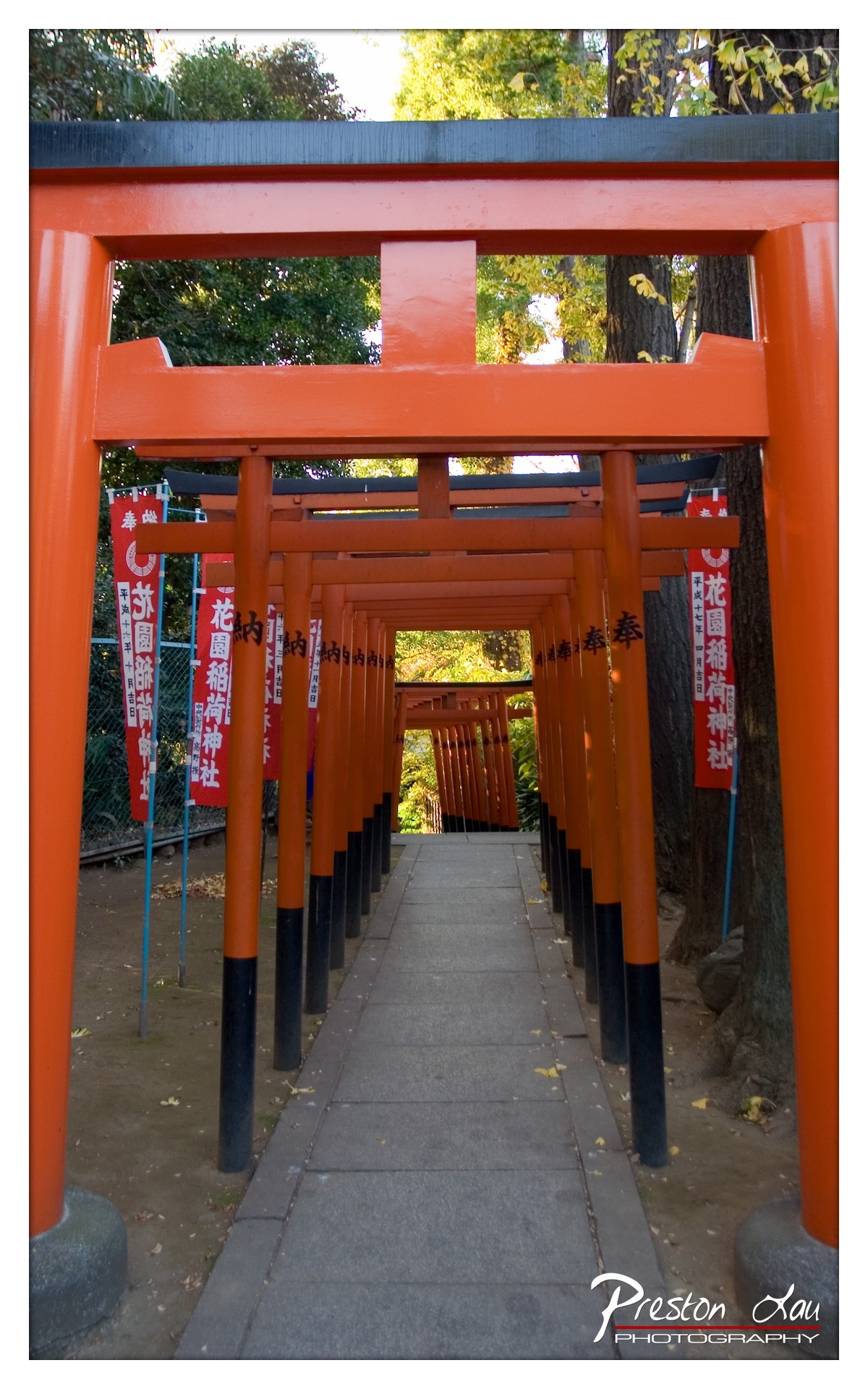

1. Overall Rating (0–10) — 7.5
This photograph captures the serene rhythm of a torii-lined path, where tradition and nature converge in a quiet, meditative passage. The repeating arches create a strong sense of depth and movement, drawing the viewer into the sacred space with a quiet intensity. While the image is visually compelling, the slightly overexposed sky and cluttered signage on the left slightly disrupt the harmony, preventing it from feeling fully immersive.
2. Composition (0–10) — 8.0
The symmetrical alignment of the torii gates creates a powerful leading line, guiding the eye naturally toward the vanishing point. The inclusion of the tree trunk on the right balances the frame, while the low-angle perspective enhances the grandeur of the structure.
3. Lighting (0–10) — 6.5
Soft, diffused daylight illuminates the scene evenly, enhancing the rich vermilion hue of the torii. However, the bright sky above the gate is slightly overexposed, losing detail in the upper portion and creating a slight visual imbalance.
4. Color & Tone (0–10) — 7.0
The vibrant orange of the torii contrasts beautifully with the green and yellow foliage, creating a warm, autumnal palette. The deep black bases provide grounding contrast, though the red banners, while culturally significant, introduce a slightly jarring visual element.
5. Creativity (0–10) — 7.5
The photograph effectively uses repetition and perspective to evoke a sense of journey and spiritual passage. The inclusion of the banners adds cultural context, enriching the narrative and inviting viewers to consider the location’s significance.
6. Technical Quality (0–10) — 8.0
The image is sharp and well-focused, with clean details visible on the wood grain and signage. The exposure is largely balanced, though the sky’s brightness suggests a minor overexposure.
7. Emotional Impact (0–10) — 7.0
The image evokes a sense of reverence and quiet contemplation, inviting the viewer to imagine walking through the path. The combination of natural light, color, and architecture creates a peaceful atmosphere, though the slight visual clutter tempers the emotional resonance.
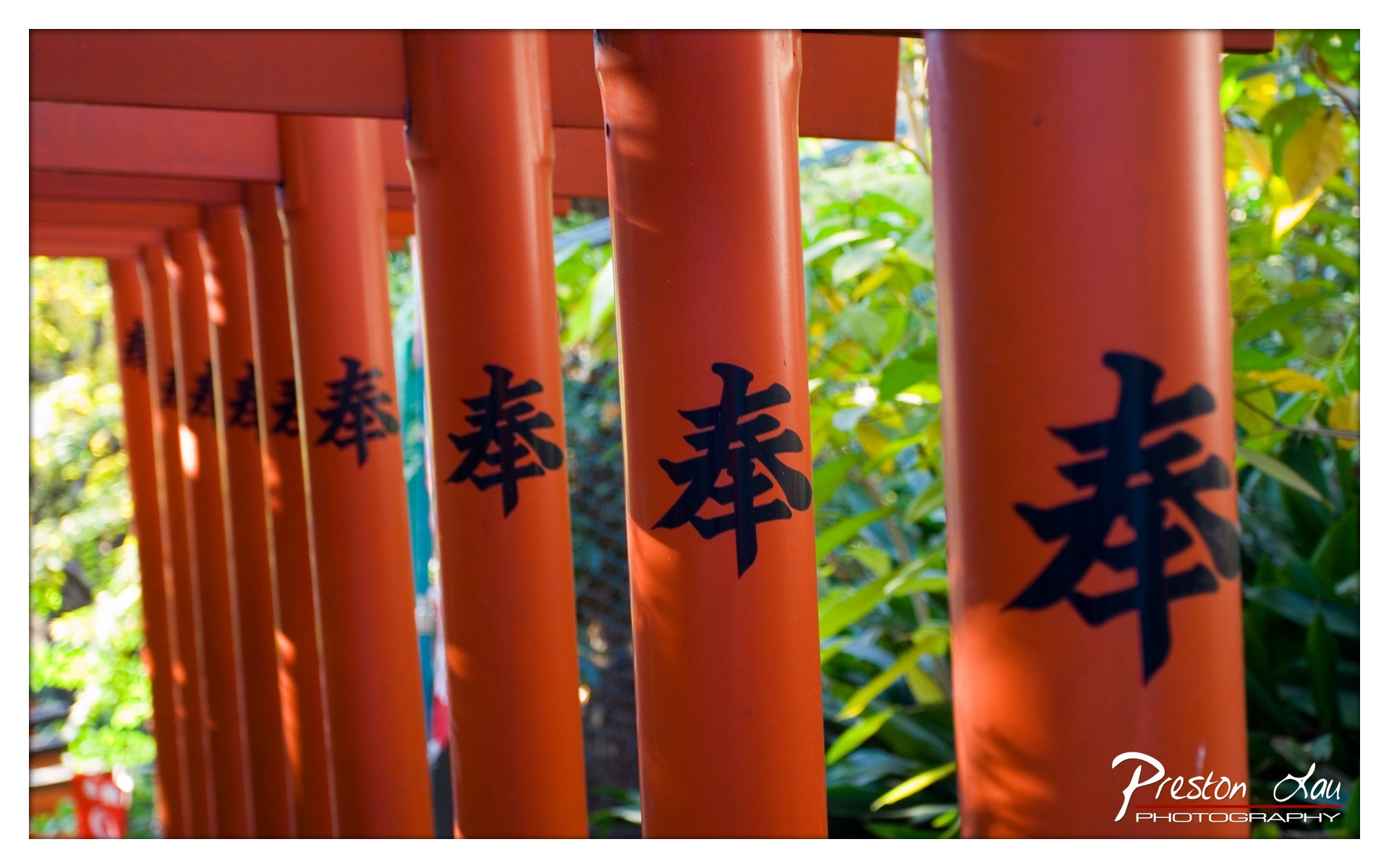

1. Overall Rating (0–10) — 8.0
This photograph captures the serene rhythm of a Japanese shrine, where repeating torii gates form a visual tunnel into a world of quiet reverence. The bold red of the pillars contrasts vividly with the soft green foliage, creating a dynamic yet harmonious composition. While the image excels in color and mood, the shallow depth of field slightly limits the narrative clarity of the scene.
2. Composition (0–10) — 8.5
The repeating vertical lines of the torii gates create a strong sense of depth and rhythm, guiding the eye naturally through the frame. The slight asymmetry adds visual interest, while the placement of the largest pillar on the right balances the composition effectively.
3. Lighting (0–10) — 8.0
Natural sunlight filters through the trees, casting soft highlights and gentle shadows across the red pillars. The interplay of light enhances the texture of the wood and adds dimension, while the bright background ensures the subject remains the focal point without overexposure.
4. Color & Tone (0–10) — 9.0
The rich vermilion of the torii stands in striking contrast to the lush green backdrop, creating a vibrant and culturally resonant palette. The warm tones evoke a sense of tradition and spirituality, while the subtle gradations of light and shadow add tonal depth.
5. Creativity (0–10) — 8.5
The photographer uses repetition and perspective to transform a familiar subject into a compelling visual journey. The emphasis on the Japanese character “奉” (meaning “to offer” or “to serve”) adds a layer of symbolic meaning, elevating the image beyond mere documentation.
6. Technical Quality (0–10) — 8.0
Sharp focus on the nearest pillar ensures clarity, while a shallow depth of field blurs the background into a soft bokeh that enhances the subject. The exposure is well-balanced, and the camera's resolution captures fine details without noise.
7. Emotional Impact (0–10) — 8.5
The image evokes a sense of peace, reverence, and cultural continuity. The viewer is drawn into the sacred space, feeling the quiet solemnity of the shrine and the weight of tradition. It is both visually striking and emotionally resonant.


1. Overall Rating (0–10) — 7.5
This photograph captures the quiet dignity of a weathered stone carving, where light and texture converge to evoke a sense of timelessness. The warm, directional sunlight enhances the relief of the sculpted figure, giving it a sculptural depth that draws the eye. While the composition is strong, the slightly off-center framing and minor distractions in the background prevent it from achieving a more refined harmony.
2. Composition (0–10) — 7.0
The subject is well-framed, with the carved figure occupying a central position that guides the viewer’s gaze. The inclusion of the green plant in the foreground adds depth and balance, though the right side feels slightly crowded by the out-of-focus tree trunk, creating a minor imbalance.
3. Lighting (0–10) — 9.0
The golden-hour light strikes the stone at a low angle, creating rich highlights and deep shadows that accentuate the texture and three-dimensionality of the carving. The quality of light is warm and evocative, casting a soft glow that enhances the spiritual and historical mood.
4. Color & Tone (0–10) — 8.0
The earthy tones of the stone harmonize beautifully with the golden sunlight, while the fresh green of the plant provides a subtle but effective contrast. The overall tonal range is rich and natural, with a warm color temperature that reinforces the serene atmosphere.
5. Creativity (0–10) — 8.0
The photographer has chosen a compelling subject and used light creatively to reveal the narrative of the carving. The juxtaposition of ancient stone and living plant suggests themes of endurance and renewal, lending the image a poetic quality.
6. Technical Quality (0–10) — 8.5
The image is sharp and well-focused on the carved figure, with excellent detail in the stone’s texture. The depth of field is appropriately managed, keeping the subject clear while softly blurring the background to minimize distractions.
7. Emotional Impact (0–10) — 8.0
The photograph evokes a quiet reverence and contemplative stillness, inviting the viewer to reflect on the passage of time and the permanence of art. The interplay of light and shadow lends a meditative quality that resonates emotionally.
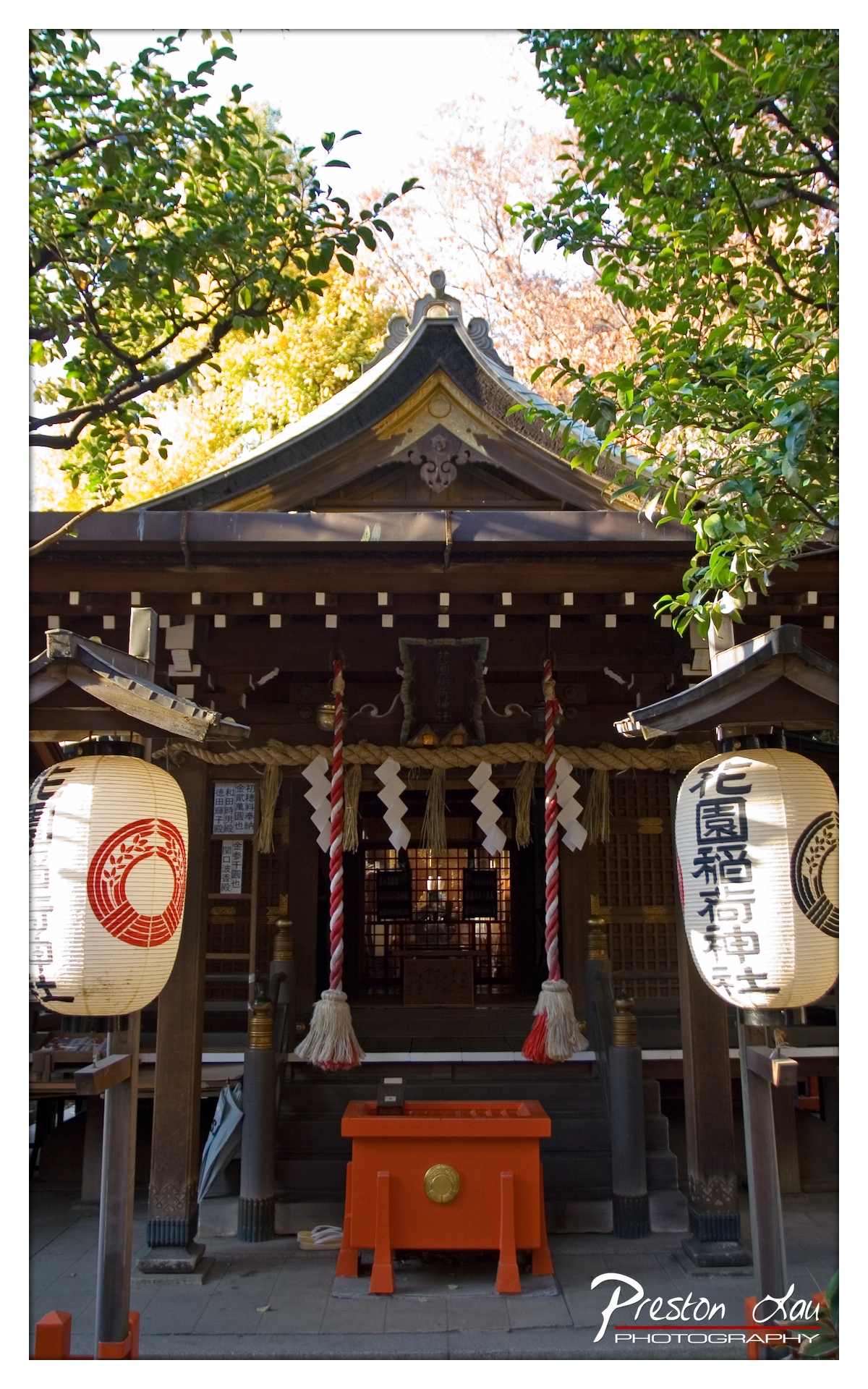

1. Overall Rating (0–10) — 7.5
This photograph captures the serene and sacred atmosphere of a traditional Japanese shrine, framed by lush foliage and bathed in warm, golden light. The composition balances cultural detail with natural beauty, creating a sense of reverence and timelessness. While the scene is rich in symbolism and texture, a slightly more dynamic angle or tighter framing could elevate the image from documentary to deeply evocative.
2. Composition (0–10) — 7.0
The shrine is centered and framed by overhanging tree branches, creating a natural border that draws the eye inward. The lanterns on either side provide symmetry, though the slight asymmetry of the foreground elements adds visual interest. A more deliberate use of leading lines could further guide the viewer’s gaze toward the sacred entrance.
3. Lighting (0–10) — 8.0
Soft, directional sunlight filters through the trees, casting a warm glow that enhances the golden tones of the roof and highlights the texture of the wooden structure. The interplay of light and shadow adds depth and dimension, while the bright sky in the background creates a gentle contrast that keeps the focus on the shrine.
4. Color & Tone (0–10) — 8.0
The palette is harmonious, with the deep browns of the wood, the vibrant orange of the offering box, and the crisp white and red of the lanterns creating a visually pleasing contrast. The autumnal hues in the background foliage add warmth and seasonal context, enhancing the image’s emotional resonance.
5. Creativity (0–10) — 7.5
The photographer captures a moment of quiet spirituality, blending cultural authenticity with aesthetic sensitivity. The use of natural framing and symbolic elements like the shimenawa rope and torii-like lanterns conveys a sense of ritual and place. While the concept is familiar, the execution demonstrates thoughtful attention to detail and mood.
6. Technical Quality (0–10) — 8.5
The image is sharp and well-exposed, with clear detail in both the foreground and background. The focus is precise, capturing the texture of the wood and paper lanterns. The depth of field is appropriately managed, keeping the shrine as the focal point while allowing the surrounding foliage to soften naturally.
7. Emotional Impact (0–10) — 8.0
There is a strong sense of peace and reverence in the image, evoking a quiet contemplation of tradition and nature. The warm light and familiar cultural symbols create an emotional connection, inviting the viewer to pause and reflect on the beauty of sacred spaces.
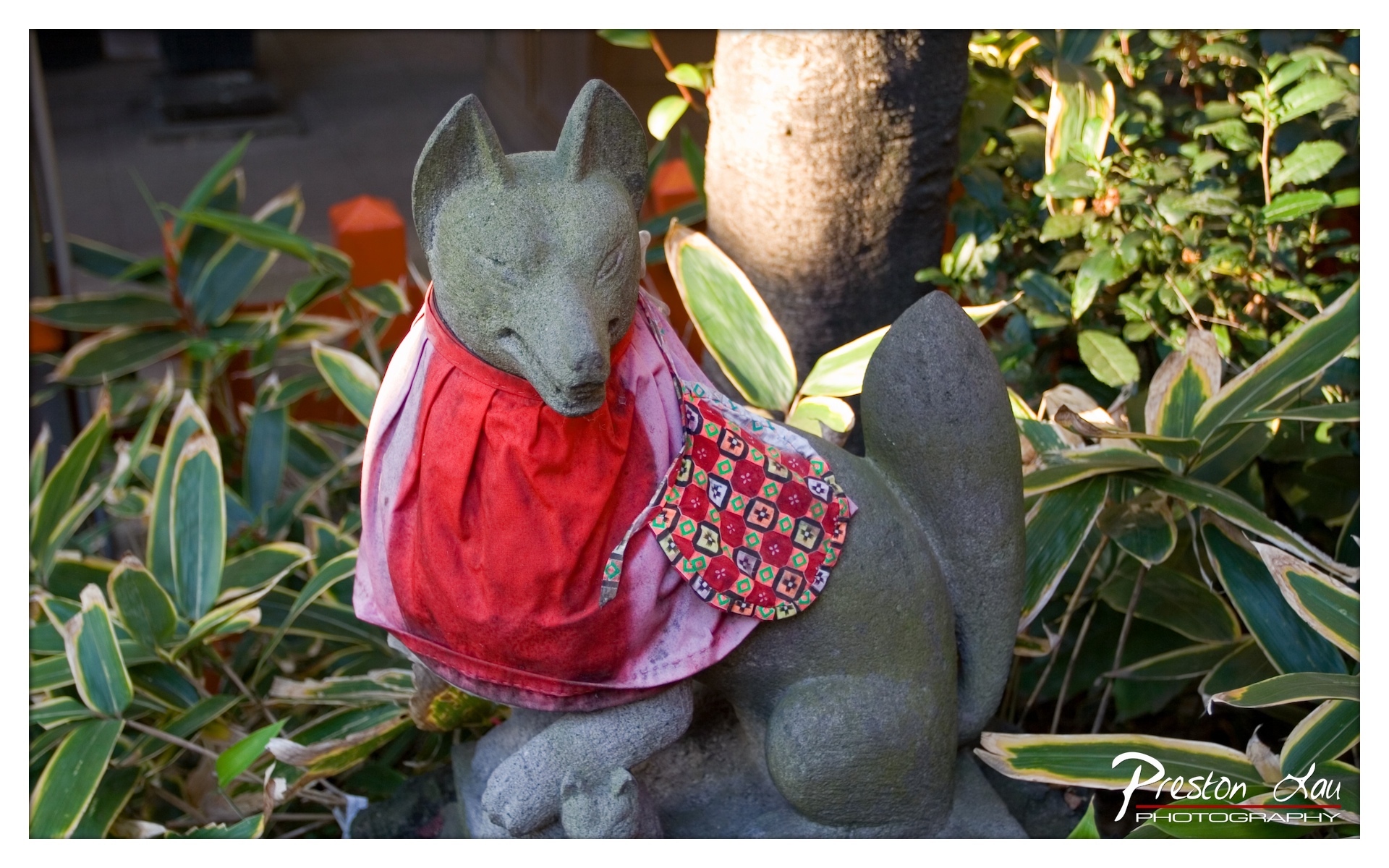

1. Overall Rating (0–10) — 7.5
This photograph captures the quiet charm of a traditional Japanese fox statue, or *kitsune*, adorned with a vibrant red bib and patterned cloth, nestled among sun-dappled foliage. The contrast between the weathered stone and the bright, handmade garments creates a sense of reverence and cultural continuity. While the image is rich in narrative and symbolism, the slightly cluttered background and uneven lighting prevent it from achieving a more refined aesthetic.
2. Composition (0–10) — 7.0
The statue is well-centered and serves as a clear focal point, with surrounding foliage framing the subject naturally. The diagonal placement of the leaves and the soft depth of field guide the eye toward the kitsune, though the background elements slightly distract from the central figure.
3. Lighting (0–10) — 7.5
The warm, directional sunlight highlights the texture of the stone and the vividness of the red fabric, creating a soft glow that enhances the image’s spiritual tone. The interplay of light and shadow adds depth and dimension, though some areas remain slightly overexposed.
4. Color & Tone (0–10) — 8.0
The rich red of the bib stands out against the muted greens and grays, creating a striking contrast that draws attention. The color palette feels balanced and harmonious, with natural tones that evoke a sense of tradition and serenity.
5. Creativity (0–10) — 8.5
The image captures a unique cultural detail—the sacred kitsune of Shinto shrines—transforming a simple statue into a storytelling subject. The combination of ancient stone and modern fabric suggests a living tradition, making the composition both conceptually and visually compelling.
6. Technical Quality (0–10) — 8.0
The focus is sharp on the statue’s face and torso, with clear detail in the fabric’s texture. The exposure is well-managed, though minor overexposure in the highlights reduces some detail in the background foliage.
7. Emotional Impact (0–10) — 8.0
The image evokes a sense of peace and quiet devotion, inviting the viewer to reflect on tradition and the intersection of nature, spirituality, and human care. The warmth of the light and the gentle expression of the fox statue create a subtle emotional resonance.
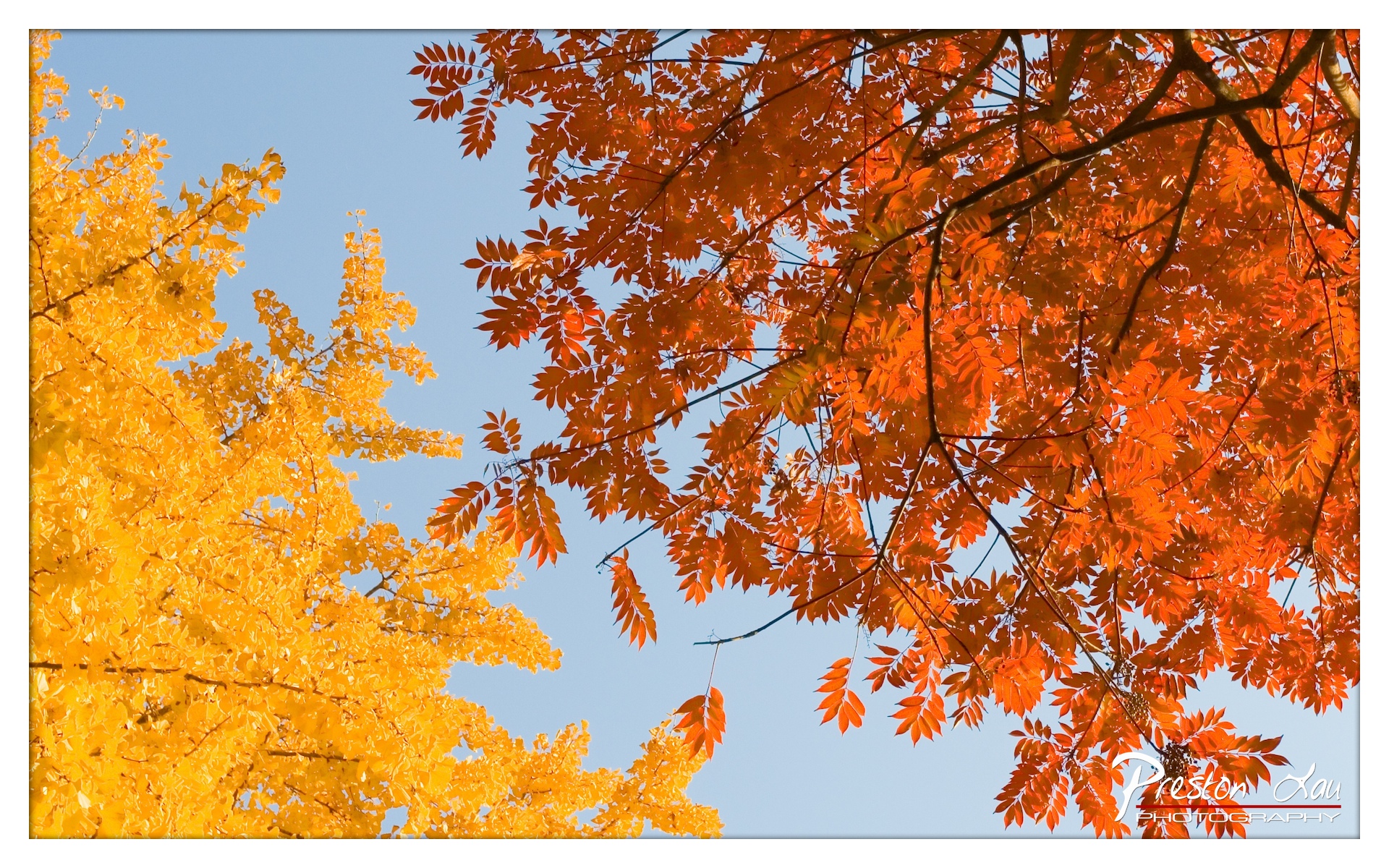

1. Overall Rating (0–10) — 8.0
This photograph captures the vibrant energy of autumn with a striking interplay of color and light, where the warmth of golden and crimson leaves contrasts beautifully against a clear blue sky. The composition draws the eye naturally across the frame, emphasizing the season’s fleeting beauty, though a slightly more deliberate arrangement of branches could enhance visual flow. It succeeds as both a celebration of nature and a well-crafted image.
2. Composition (0–10) — 7.5
The diagonal division between yellow and red foliage creates dynamic movement, while the clear sky provides negative space that emphasizes the trees’ vivid forms. The framing feels natural and immersive, though the left side slightly overpowers the right, creating a subtle imbalance.
3. Lighting (0–10) — 8.5
The bright, directional sunlight enhances the saturation of the leaves, creating rich, glowing tones and soft shadows that add depth. The light appears to come from the side, giving the scene a warm, golden-hour quality that enhances the autumnal mood.
4. Color & Tone (0–10) — 9.0
The complementary contrast between the warm yellows and oranges and the cool blue sky is striking and harmonious. The color palette is vibrant yet balanced, evoking the peak of fall with a sense of warmth and vitality.
5. Creativity (0–10) — 8.0
The photographer captures a classic seasonal theme with a fresh, visually compelling approach. The dual-color composition and upward perspective lend a sense of discovery, inviting the viewer to look up and feel the season’s atmosphere.
6. Technical Quality (0–10) — 8.5
The image is sharp and clear, with excellent detail in the leaves and clean edges. The exposure is well-balanced, preserving texture and tone without harsh highlights or crushed shadows.
7. Emotional Impact (0–10) — 8.5
The photograph evokes a sense of peace and wonder, capturing the quiet beauty of autumn in a way that feels both familiar and uplifting. The warmth of the colors and the open sky create a moment of serene joy.
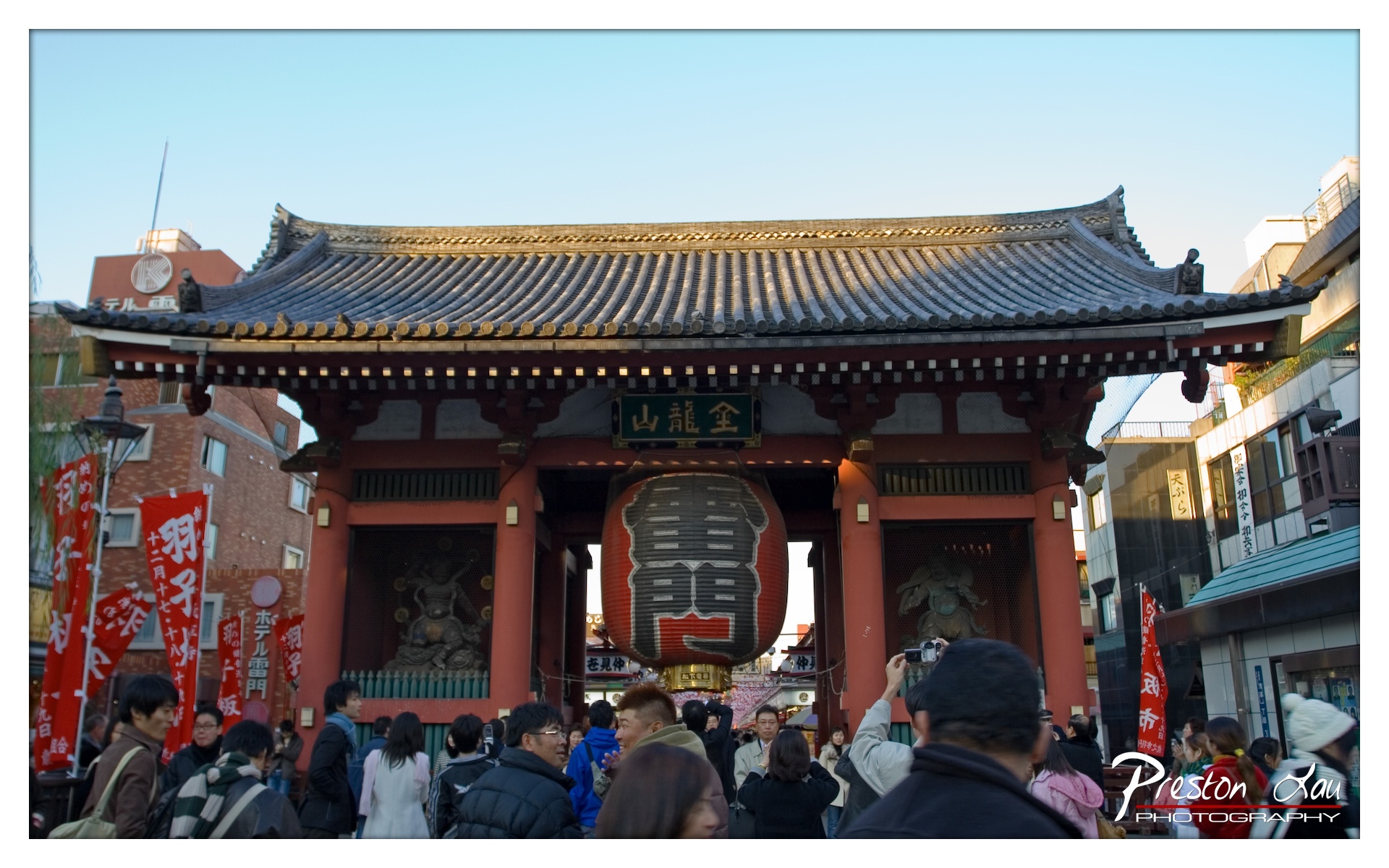

1. Overall Rating (0–10) — 7.0
This photograph captures the vibrant energy of a bustling Japanese temple entrance, where tradition meets modern life in a dynamic urban setting. The composition effectively balances the grandeur of the historic gate with the lively human activity, creating a sense of place and cultural authenticity. While the scene is rich with detail, the slightly overexposed sky and cluttered foreground slightly dilute the image’s visual clarity and emotional depth.
2. Composition (0–10) — 7.0
The gate is centered and dominates the frame, creating a strong focal point. The crowd in the foreground adds depth and scale, while the red banners and lantern draw the eye into the scene. However, the left side feels slightly crowded, and the framing cuts off some of the surrounding architecture, which could have enhanced context.
3. Lighting (0–10) — 6.5
The warm, low-angle sunlight enhances the red tones of the gate and casts soft shadows, adding a sense of time and atmosphere. However, the sky is overexposed, losing detail in the upper portion of the image, which detracts from the overall balance.
4. Color & Tone (0–10) — 7.0
The rich reds of the gate and banners contrast beautifully with the muted blue sky and the neutral tones of the surrounding buildings. The warm color temperature complements the scene’s cultural and historical mood, though the saturation is slightly high, giving a slight artificial quality to the reds.
5. Creativity (0–10) — 7.0
The image successfully captures a moment of cultural immersion, blending architectural grandeur with everyday life. The inclusion of the lantern and banners, along with the candid crowd, adds narrative depth and suggests a festival or seasonal event. While not highly experimental, it offers a compelling and authentic portrayal of a living tradition.
6. Technical Quality (0–10) — 7.5
The focus is sharp on the gate and the central lantern, with good detail in the textures of the tiles and wood. The image is clear and well-exposed in the midtones, though the overexposed sky and slight noise in the darker areas reduce overall technical precision.
7. Emotional Impact (0–10) — 6.5
The photograph evokes a sense of energy and connection to a vibrant community, with the crowd’s engagement suggesting a shared cultural experience. While the emotional resonance is strong, the visual clutter and technical imperfections prevent it from feeling fully immersive or poignant.
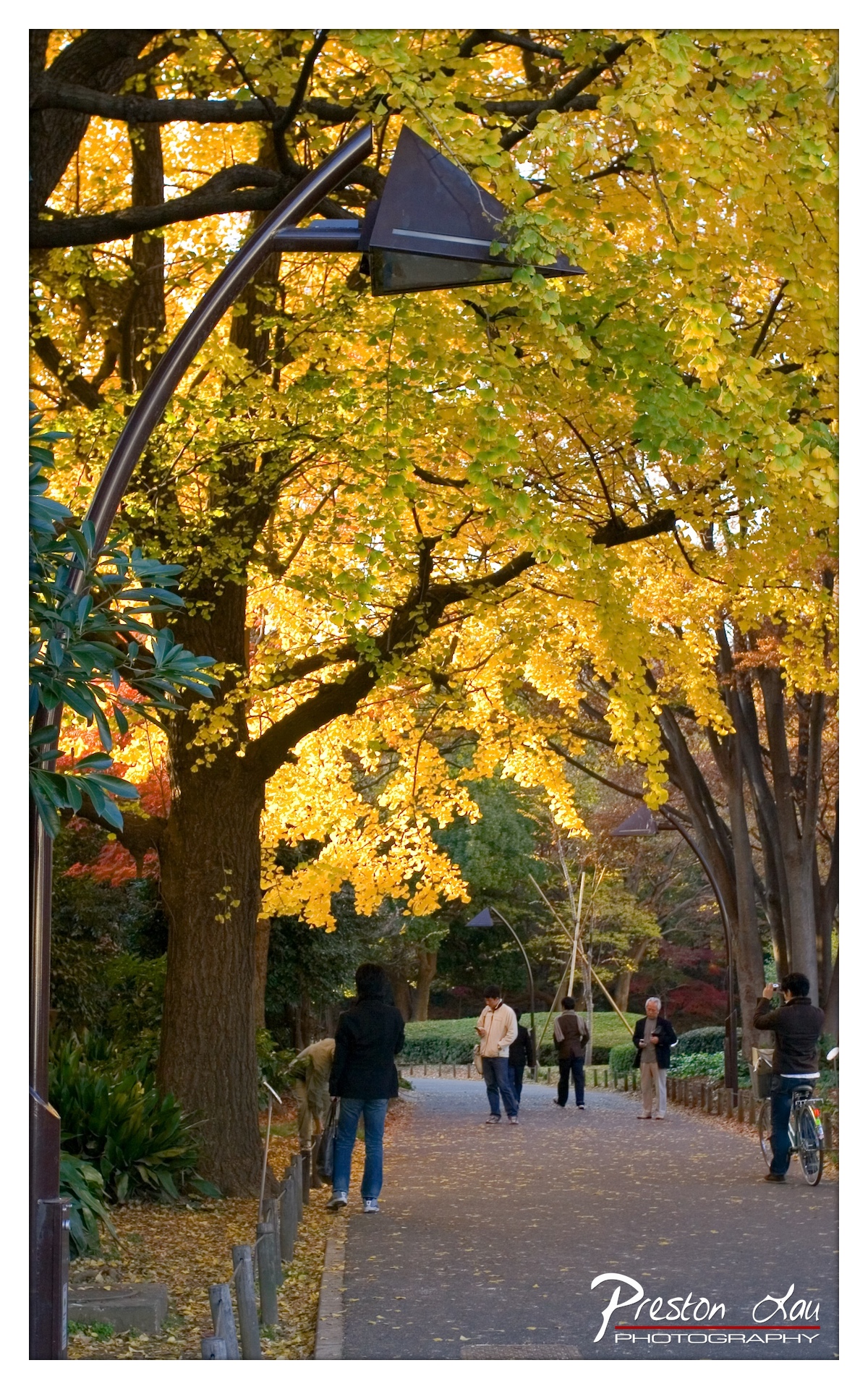

1. Overall Rating (0–10) — 7.5
This photograph captures the serene beauty of an autumnal park, where golden ginkgo leaves form a luminous canopy over a quiet path. The interplay of warm sunlight filtering through the foliage and the presence of people strolling creates a peaceful, contemplative mood. While the image is rich in color and atmosphere, the composition’s slight imbalance and modest technical clarity prevent it from achieving a truly transcendent quality.
2. Composition (0–10) — 6.5
The curved lamppost on the left creates a strong diagonal that draws the eye into the frame, but its dominance slightly disrupts the natural flow. The people are scattered across the path, giving a sense of depth and movement, though their placement feels somewhat random and less intentional.
3. Lighting (0–10) — 8.0
The soft, golden light of late afternoon bathes the scene in warmth, enhancing the autumnal palette and creating a glowing effect in the leaves. The backlighting adds depth and a gentle halo around the tree canopy, contributing to the image’s tranquil mood.
4. Color & Tone (0–10) — 8.5
The vibrant yellows of the ginkgo leaves stand out beautifully against the darker tree trunks and muted greenery, creating a rich, harmonious palette. The warm tones evoke the essence of fall, and the contrast between light and shadow adds visual interest.
5. Creativity (0–10) — 7.0
The photographer captures a familiar autumn scene with a strong sense of place and seasonality. While not groundbreaking, the use of natural light and color creates a poetic interpretation of a quiet park moment, suggesting a quiet appreciation for seasonal beauty.
6. Technical Quality (0–10) — 7.5
The image is sharp and well-focused, particularly in the foreground and midground. The depth of field is appropriate, keeping the main subjects in focus while softly blurring the background. The exposure is well-balanced, preserving detail in both highlights and shadows.
7. Emotional Impact (0–10) — 7.5
The photograph evokes a sense of calm and nostalgia, inviting the viewer to imagine walking through the path and feeling the crisp air and rustling leaves. The human figures add a touch of life and relatability, enhancing the emotional resonance of a peaceful autumn day.
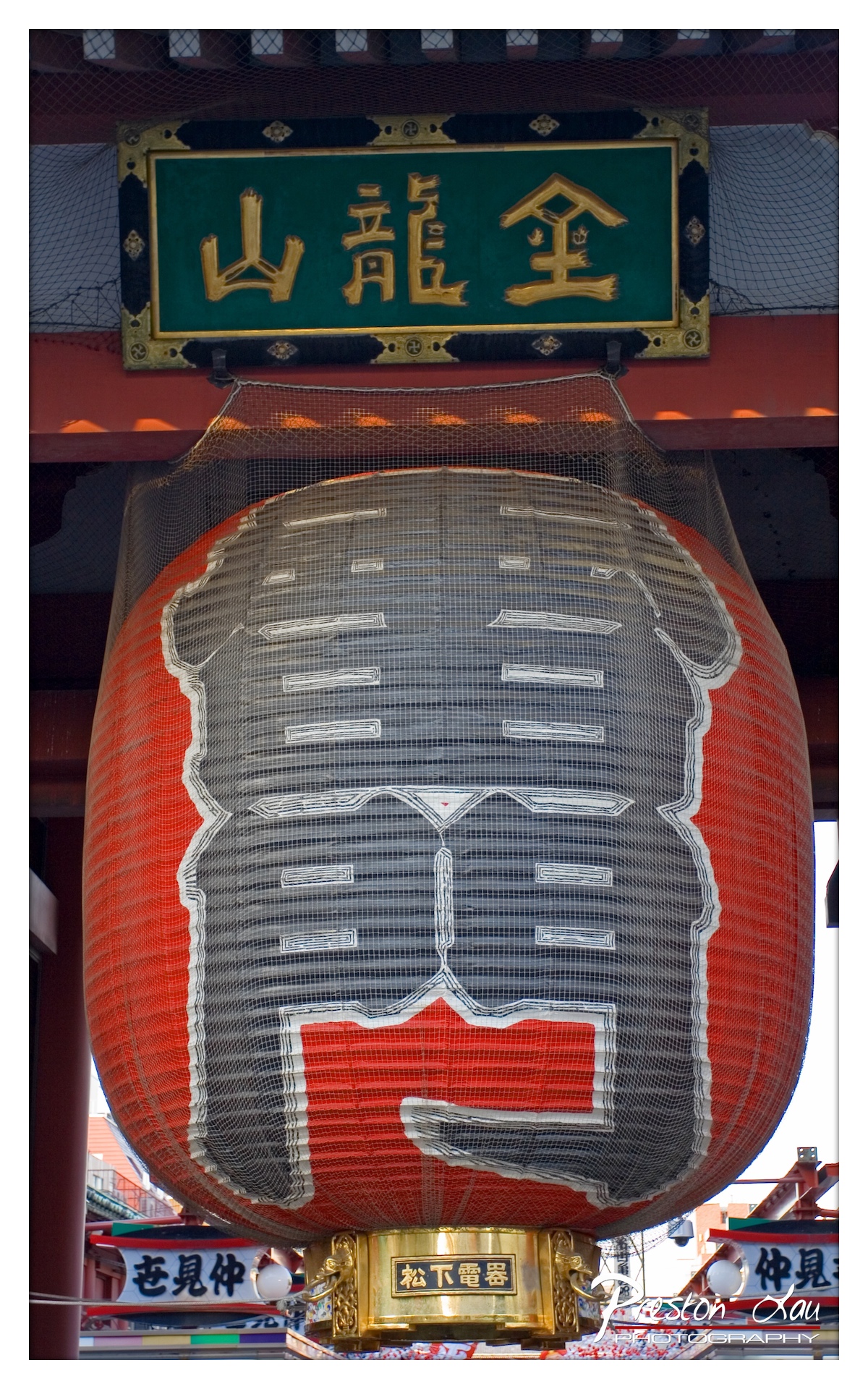

1. Overall Rating (0–10) — 7.5
This photograph captures the bold presence of a traditional Japanese lantern, its intricate design and symbolic elements conveying cultural depth and architectural grandeur. The composition centers on the lantern with strong visual weight, while the ornate sign above adds narrative context. The image is rich in cultural detail and color, though the slightly cluttered lower frame and watermark distract from the overall elegance.
2. Composition (0–10) — 7.0
The lantern is centered and dominates the frame, creating a strong focal point. The vertical alignment with the sign above enhances symmetry, though the lower portion is slightly cluttered with signage and a watermark, which disrupts visual flow.
3. Lighting (0–10) — 7.5
Natural daylight illuminates the scene evenly, highlighting the lantern’s textures and the gold lettering on the sign. The soft shadows enhance depth without overpowering the subject.
4. Color & Tone (0–10) — 8.0
The bold red of the lantern contrasts vividly with the dark green sign and golden characters, creating a dynamic and culturally resonant palette. The warm tones evoke a sense of tradition and festivity.
5. Creativity (0–10) — 7.5
The image successfully captures a moment rich in cultural symbolism, using the lantern and sign as visual storytelling devices. The inclusion of the protective net adds a subtle layer of realism, grounding the scene in its physical context.
6. Technical Quality (0–10) — 8.5
Sharp focus on the lantern and sign ensures clarity, and the exposure is well-balanced. The fine details in the lantern’s fabric and the lettering are rendered with precision.
7. Emotional Impact (0–10) — 7.0
The image evokes a sense of reverence and cultural pride, inviting the viewer to appreciate the artistry and history embedded in the scene. The presence of the net and the commercial signage subtly remind us of the intersection of tradition and modern life.
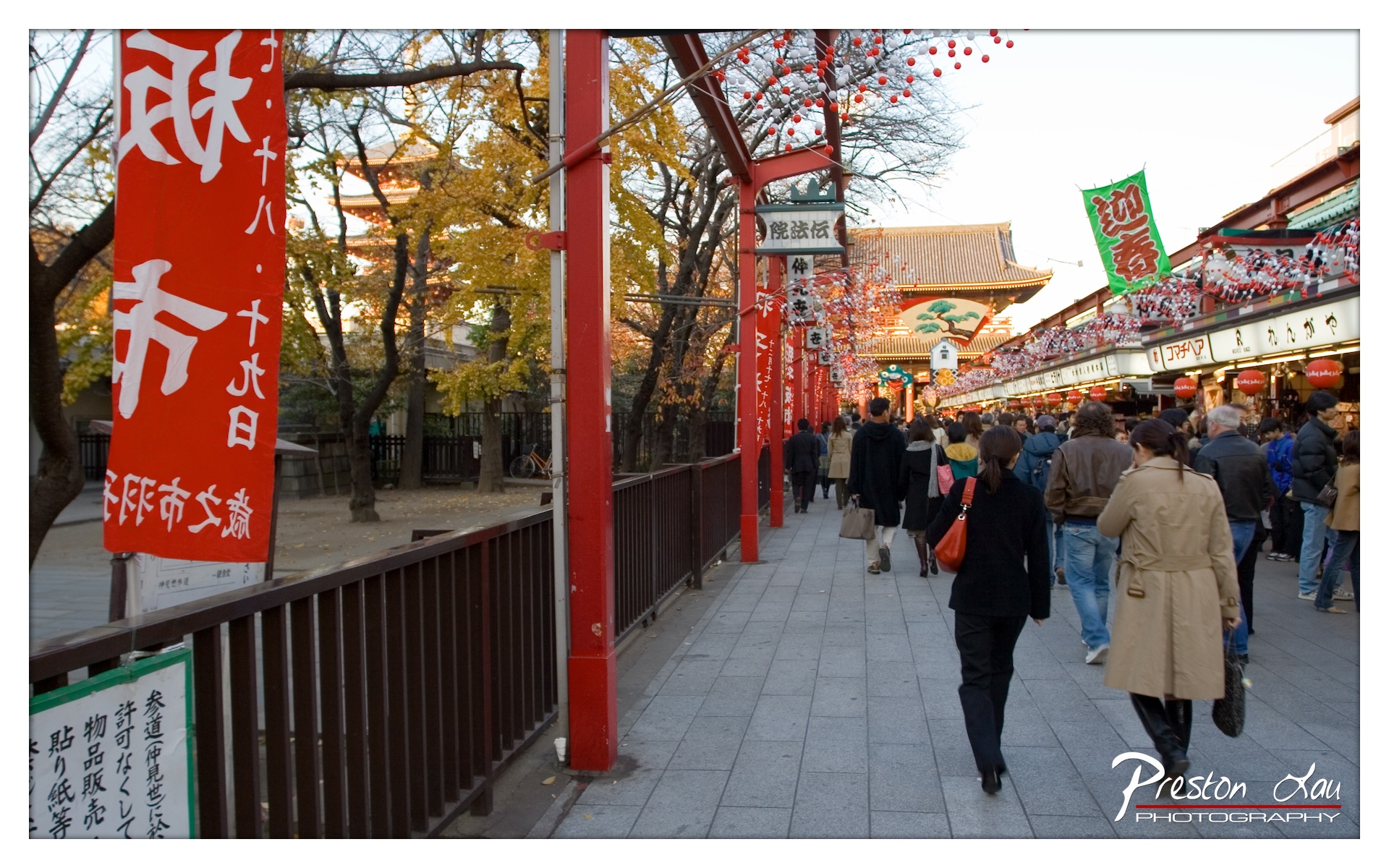

1. Overall Rating (0–10) — 7.5
This photograph captures the vibrant energy of a traditional Japanese festival, where cultural celebration meets everyday life. The rich reds of the banners and lanterns contrast beautifully with the golden autumn foliage, creating a warm, inviting atmosphere. While the scene is lively and rich in detail, the composition’s density slightly dilutes the focus, making it feel more like a snapshot than a polished narrative.
2. Composition (0–10) — 7.0
The leading lines of the red poles and the walkway guide the eye toward the temple, creating a sense of depth and movement. However, the left side feels slightly unbalanced due to the large red banner and the empty space beyond the railing.
3. Lighting (0–10) — 7.5
Soft, golden-hour light bathes the scene, enhancing the autumn colors and lending a warm glow to the architecture and people. The lighting is well-balanced, avoiding harsh shadows and preserving detail across the frame.
4. Color & Tone (0–10) — 8.0
The palette is rich and harmonious, with the deep reds of the banners complementing the golden yellows of the ginkgo trees. The contrast between the warm tones and the cool gray pavement adds visual interest and depth.
5. Creativity (0–10) — 7.5
The image successfully captures the spirit of a seasonal festival, blending cultural elements with candid human activity. The inclusion of both the temple and the bustling market creates a layered story of tradition and community.
6. Technical Quality (0–10) — 8.0
The image is sharp and well-exposed, with clear details in both the foreground and background. The focus is consistent, and the depth of field effectively captures the scene without distracting blur.
7. Emotional Impact (0–10) — 7.0
The photograph evokes a sense of peaceful celebration and cultural continuity. The presence of people going about their day lends a human, relatable quality, inviting the viewer to imagine themselves walking through the scene.
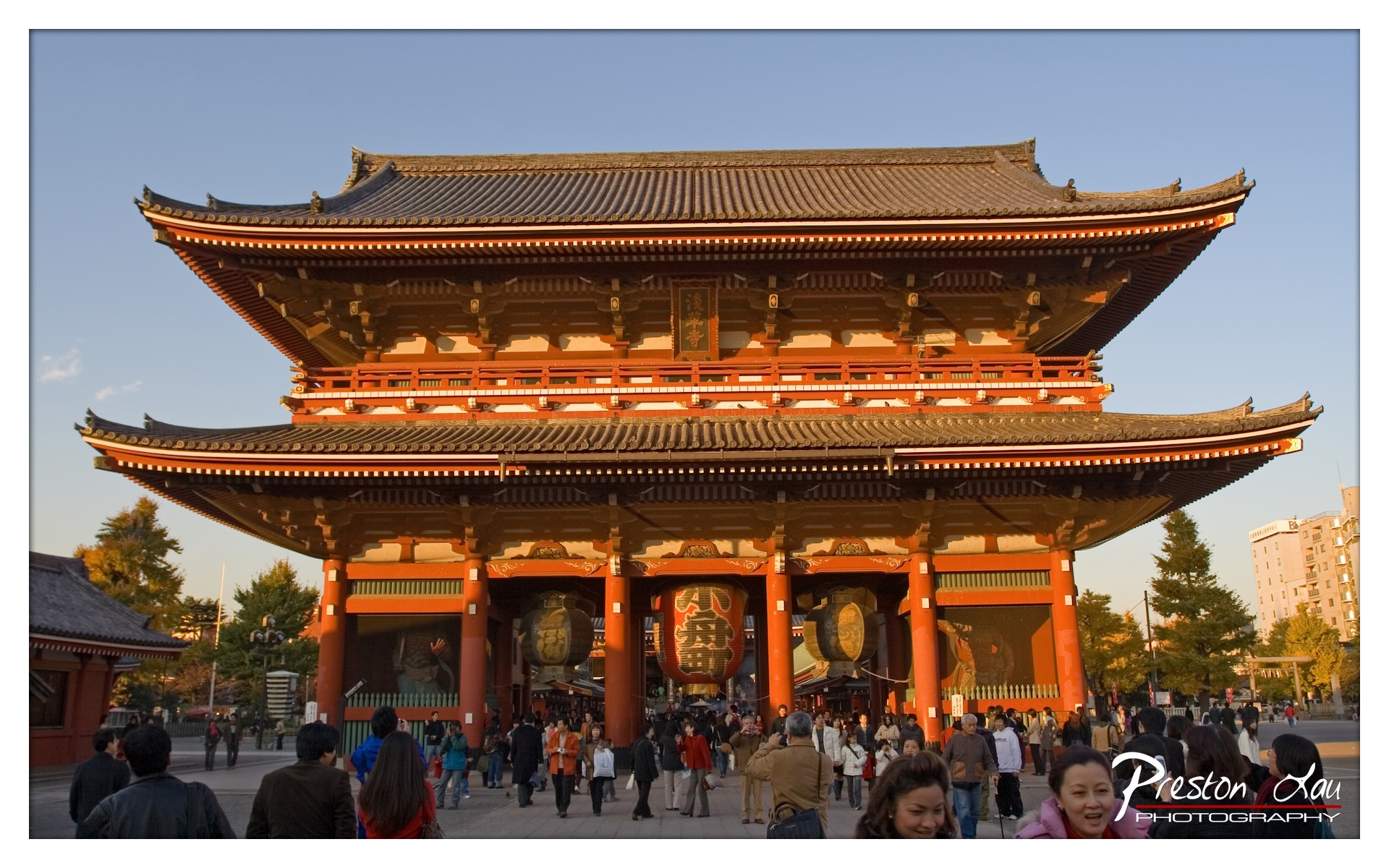

1. Overall Rating (0–10) — 7.5
This photograph captures the grandeur of a traditional Japanese temple gate bathed in the warm glow of late afternoon light, creating a powerful sense of cultural depth and human activity. The vibrant red-orange of the structure contrasts beautifully with the clear blue sky, while the bustling crowd adds life and scale. Though the image is rich in atmosphere, the composition feels slightly cluttered, and the watermark detracts from the visual harmony.
2. Composition (0–10) — 6.5
The temple gate is centered and dominates the frame, emphasizing its architectural significance. However, the inclusion of numerous people in the foreground and the slight asymmetry caused by the surrounding buildings and trees create a busy, somewhat uneven balance.
3. Lighting (0–10) — 8.5
The golden hour lighting enhances the temple’s rich wood tones and casts long, dramatic shadows, giving the scene depth and warmth. The light direction highlights the layered eaves and structural details, creating a visually striking effect.
4. Color & Tone (0–10) — 8.0
The warm, saturated reds of the temple contrast beautifully with the cool blue sky, creating a harmonious and balanced palette. The tonal range is well-managed, with rich shadows and bright highlights contributing to the image’s depth.
5. Creativity (0–10) — 7.0
The image effectively captures a moment of cultural vibrancy, blending architecture, light, and human presence. While the concept is familiar, the execution—particularly the timing and lighting—elevates it beyond a simple tourist snapshot.
6. Technical Quality (0–10) — 8.0
The image is sharp and detailed, with clear focus on the temple gate. The exposure is well-balanced, and the depth of field allows both the architecture and the crowd to remain visible without distracting blur.
7. Emotional Impact (0–10) — 7.5
The photograph evokes a sense of awe and serenity, inviting the viewer into a moment of shared cultural experience. The warmth of the light and the presence of people create a feeling of connection and reverence.
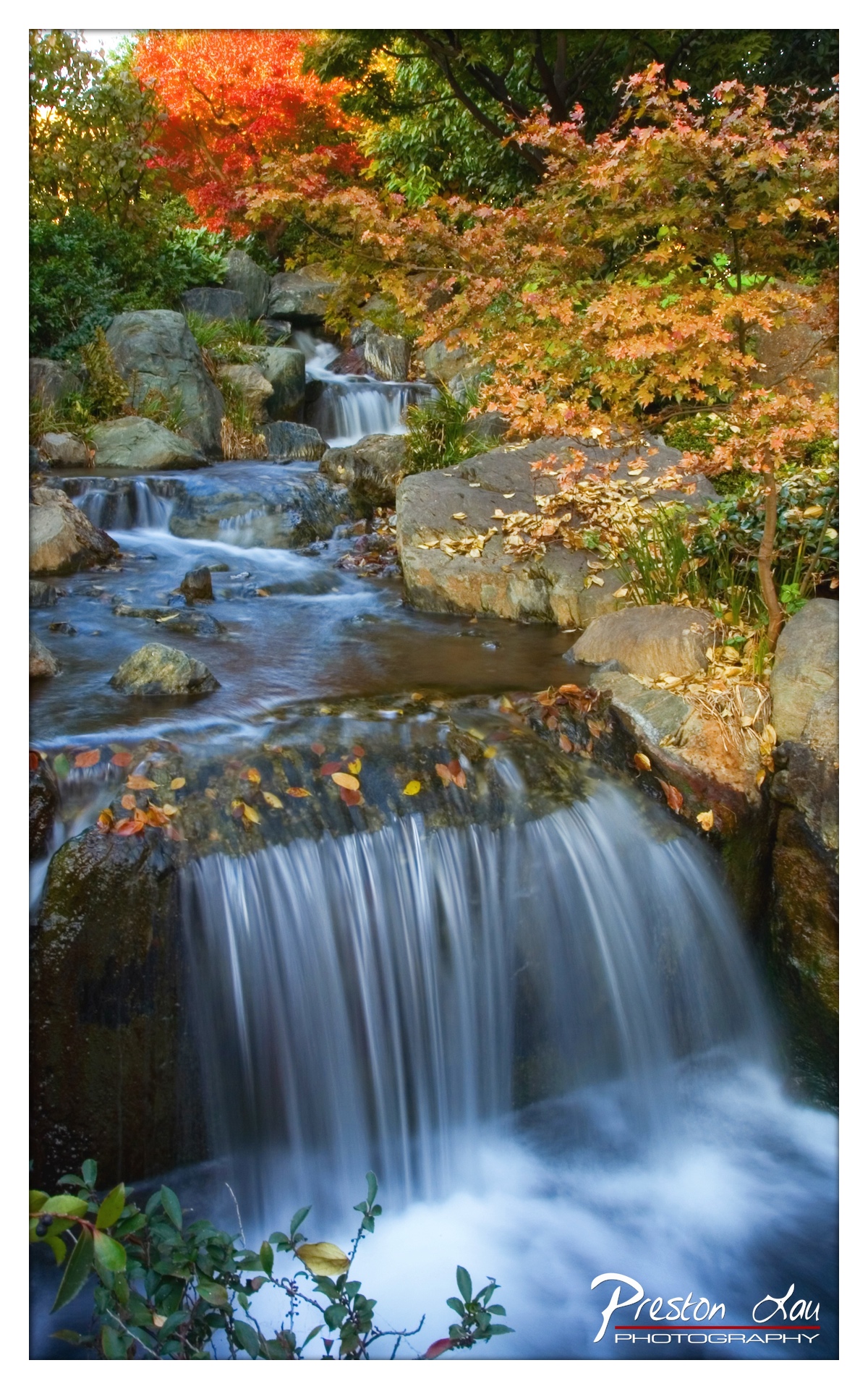

1. Overall Rating (0–10) — 8.0
This photograph captures the serene beauty of a Japanese garden in autumn, where the interplay of flowing water and vibrant foliage creates a meditative atmosphere. The long exposure transforms the stream into a silky cascade, enhancing the sense of tranquility, while the rich autumn colors provide a powerful contrast against the cool stone and water. While the image is visually striking, the heavy post-processing slightly softens the natural textures, giving it a more stylized feel than organic.
2. Composition (0–10) — 8.5
The waterfall is placed slightly off-center, guiding the eye through the frame with a natural flow from the upper left to the lower right. The layered arrangement of rocks, foliage, and cascading water creates depth and visual interest, while the foreground leaves add a subtle framing element that enhances immersion.
3. Lighting (0–10) — 7.5
Soft, diffused light highlights the autumn leaves and the texture of the flowing water. The warm glow on the upper left suggests late afternoon sun, casting a golden hue that enhances the seasonal mood. The exposure is well-balanced, though the sky is slightly overexposed, losing some detail in the highlights.
4. Color & Tone (0–10) — 9.0
The color palette is rich and harmonious, with vivid reds and oranges in the foliage complementing the cool blues and grays of the water and stone. The contrast between warm and cool tones creates a dynamic yet balanced visual, while the saturated colors amplify the autumnal atmosphere.
5. Creativity (0–10) — 8.5
The use of long exposure to render the water as a smooth, ethereal stream is a strong creative choice that transforms a simple scene into a dreamlike landscape. The intentional color grading and focus on seasonal detail convey a contemplative mood, suggesting a deep appreciation for nature’s quiet beauty.
6. Technical Quality (0–10) — 8.0
The image is sharp where it matters—especially on the rocks and foliage—with clear focus and no visible noise. The long exposure is executed cleanly, with smooth motion blur and no distracting artifacts. However, the high contrast and saturation suggest significant post-processing, which slightly reduces the naturalism.
7. Emotional Impact (0–10) — 8.5
The photograph evokes a deep sense of peace and reflection, inviting the viewer to pause and absorb the quiet rhythm of nature. The combination of flowing water, falling leaves, and autumn hues stirs feelings of nostalgia and tranquility, making it emotionally resonant and visually calming.
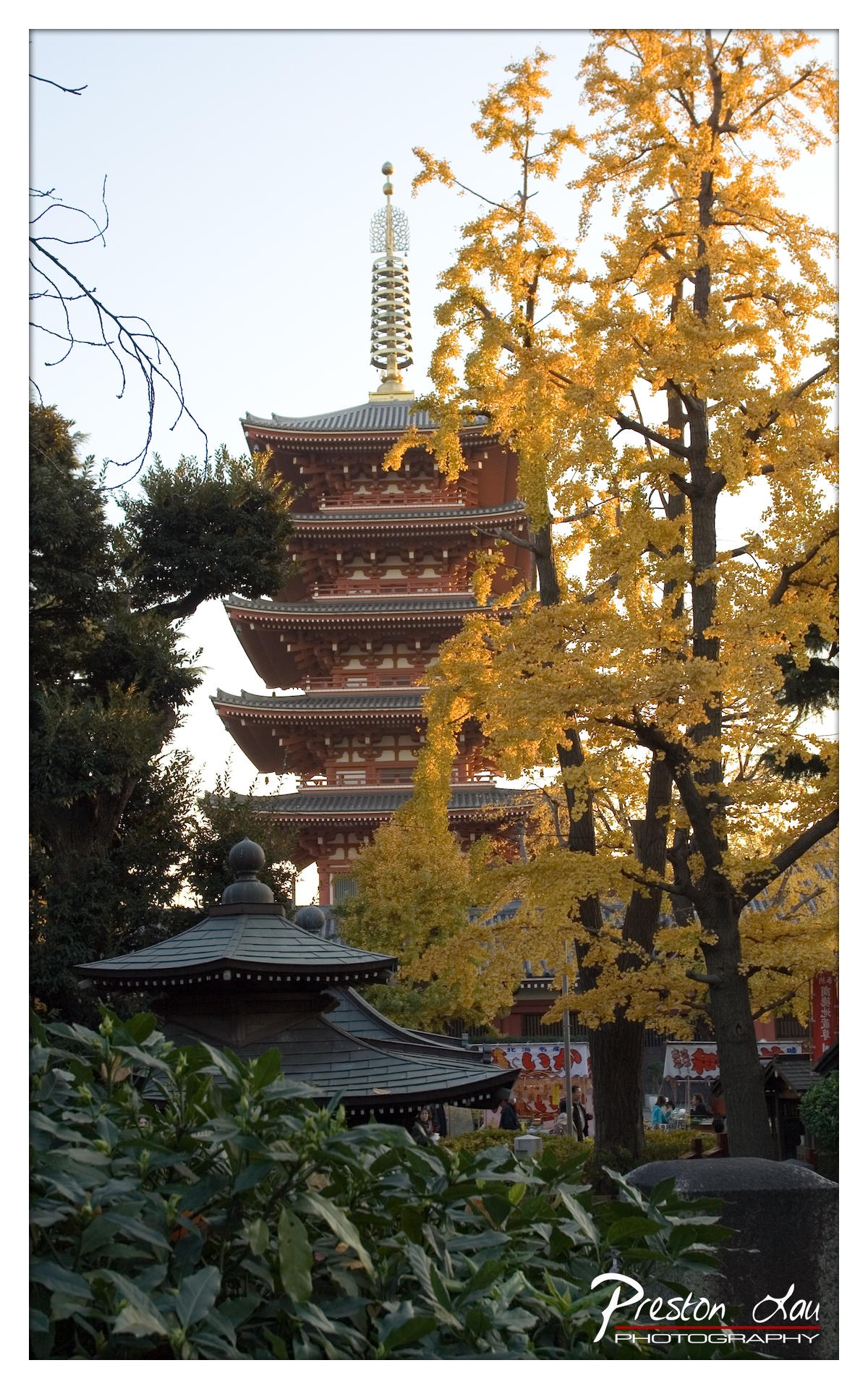

1. Overall Rating (0–10) — 8.0
This photograph captures the serene elegance of a traditional Japanese pagoda framed by the golden foliage of a ginkgo tree, evoking a sense of timelessness and cultural depth. The warm light of late afternoon bathes the scene in a soft glow, enhancing the harmony between architecture and nature. While the composition is strong, a slightly tighter framing could further emphasize the pagoda as the central subject, reducing distractions in the lower right.
2. Composition (0–10) — 7.5
The pagoda is centered and rises powerfully through the frame, with the ginkgo tree on the right providing a natural, golden contrast. The foreground foliage and left-side branches add depth, though the lower-right detail of people and signage slightly disrupts the visual flow.
3. Lighting (0–10) — 8.5
Soft, directional sunlight from the side highlights the texture of the pagoda and illuminates the golden leaves, creating a warm, inviting glow. The backlighting enhances the translucency of the leaves and gives the scene a peaceful, late-day atmosphere.
4. Color & Tone (0–10) — 8.0
The palette balances the warm yellows of the ginkgo against the deep reds and browns of the pagoda and the cool greens of the foreground. The tonal contrast between light and shadow adds richness, while the overall color harmony feels natural and pleasing.
5. Creativity (0–10) — 8.5
The photographer captures a classic seasonal motif—autumn in Japan—with a strong sense of place and timing. The juxtaposition of the ancient pagoda and the vibrant, fleeting foliage tells a quiet story of continuity and change, elevating the image beyond mere documentation.
6. Technical Quality (0–10) — 8.0
The image is sharp and well-focused, with clean detail in both the architectural elements and the leaves. Exposure is well-managed, preserving highlights in the sky and shadows in the foliage without harsh clipping.
7. Emotional Impact (0–10) — 8.5
The photograph evokes a deep sense of tranquility and reverence, inviting the viewer to pause and reflect on the beauty of tradition and the passage of seasons. The golden light and serene setting create a meditative mood, making the image emotionally resonant.
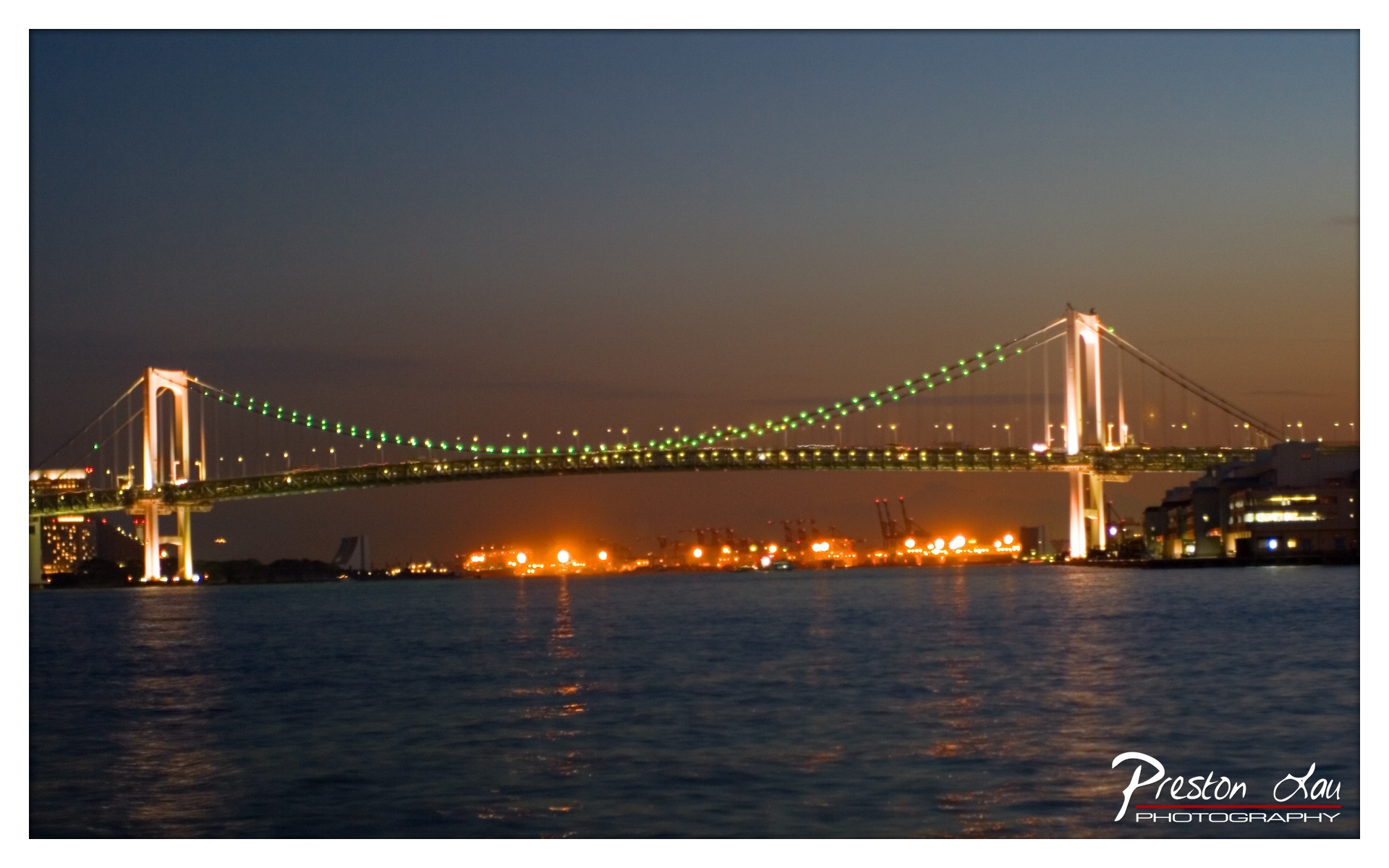

1. Overall Rating (0–10) — 7.5
This photograph captures the serene grandeur of a suspension bridge at twilight, where the interplay of artificial light and fading natural glow creates a contemplative urban landscape. The illuminated structure stands as a beacon against the deepening sky, while the reflections on the water add depth and tranquility. While the image succeeds in evoking a sense of calm and scale, a slightly more deliberate composition and richer tonal contrast could elevate its emotional resonance.
2. Composition (0–10) — 7.0
The bridge dominates the frame with a strong horizontal line, creating a sense of balance and stability. The placement of the towers on either side grounds the image, though the slight tilt and off-center alignment of the bridge reduce compositional harmony.
3. Lighting (0–10) — 8.0
The interplay of twilight and artificial lights creates a dramatic and layered effect. The warm glow from the bridge and the distant port contrasts beautifully with the cool blue of the sky, while the reflections on the water enhance the mood and depth.
4. Color & Tone (0–10) — 7.5
The palette blends cool blues and deep purples with warm yellows and greens from the lights, producing a visually rich and atmospheric scene. The tonal range is well-managed, though the green lights on the cables slightly disrupt the color harmony.
5. Creativity (0–10) — 7.0
The image captures a familiar subject—urban infrastructure—through a thoughtful lens, emphasizing mood and light over mere documentation. The choice to photograph during the blue hour and the use of reflections lend a poetic quality to the scene.
6. Technical Quality (0–10) — 8.0
The image is sharp, with clean details in the bridge and water. The long exposure is well-executed, capturing smooth water and steady lights without motion blur or noise.
7. Emotional Impact (0–10) — 7.5
The photograph evokes a quiet sense of awe and stillness, inviting the viewer to reflect on the beauty of engineered landscapes at dusk. The combination of light, water, and structure creates a meditative and slightly melancholic atmosphere.
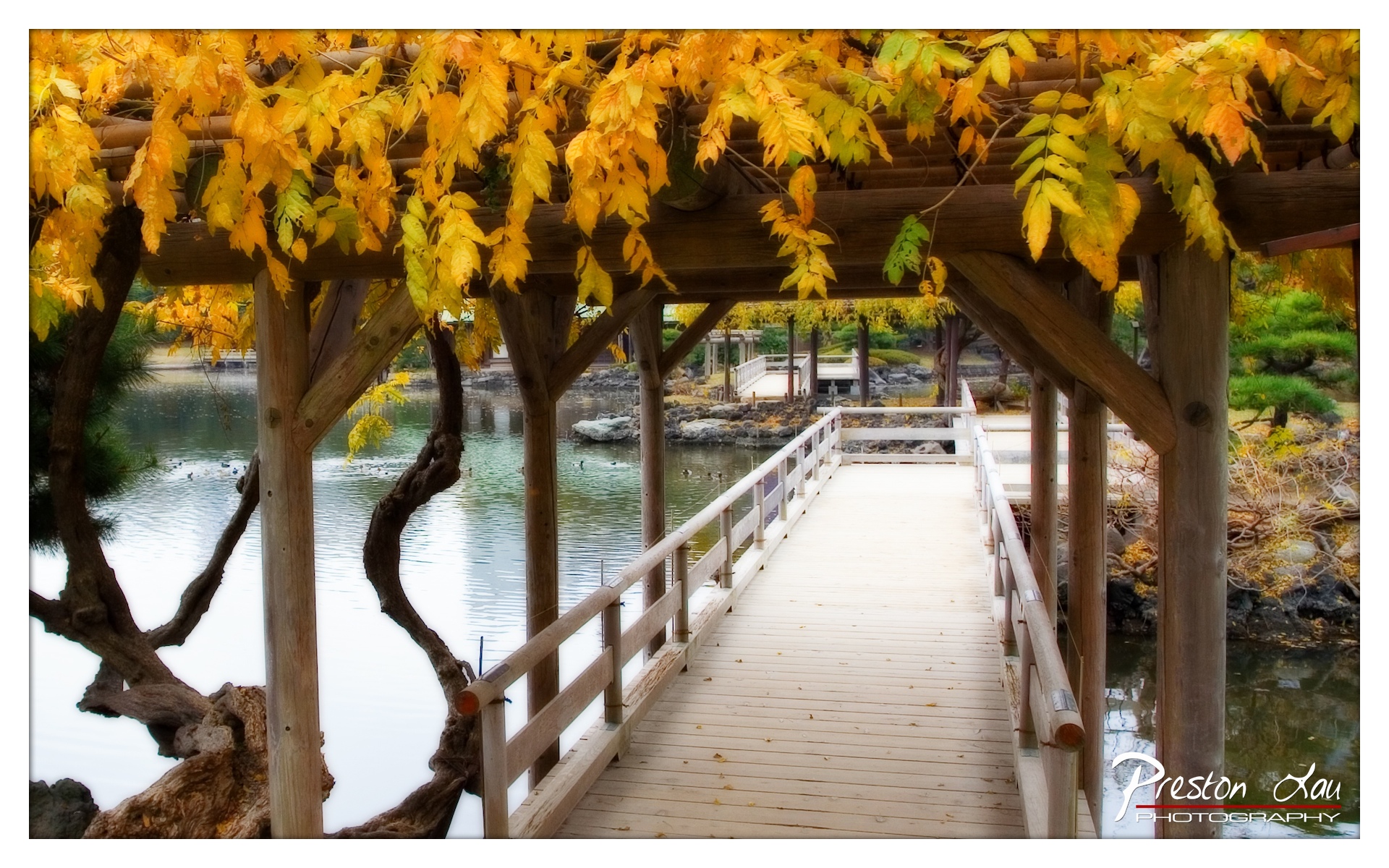

1. Overall Rating (0–10) — 8.0
This photograph captures the serene beauty of a Japanese garden in autumn, where the golden canopy of leaves creates a natural frame over a tranquil wooden bridge. The rich warmth of the foliage contrasts beautifully with the cool tones of the water and stone, evoking a sense of peace and seasonal transition. While the image is visually striking, the heavy post-processing slightly overwhelms the natural subtlety of the scene, reducing its authenticity.
2. Composition (0–10) — 8.5
The bridge leads the eye into the depth of the garden, creating strong leading lines. The framing by the wooden pergola and overhanging leaves enhances symmetry and depth, while the gnarled tree on the left adds organic texture and balance.
3. Lighting (0–10) — 7.5
Soft, diffused light enhances the autumnal mood, with gentle highlights on the leaves and reflections on the water. The light feels natural and even, though the high saturation slightly flattens the shadows.
4. Color & Tone (0–10) — 8.0
The warm yellow and orange tones of the leaves are vibrant and harmonious, complemented by the cool grays and greens of the water and foliage. The color grading enhances the seasonal atmosphere, though it borders on oversaturation.
5. Creativity (0–10) — 8.0
The photographer uses the pergola and bridge as a natural frame to guide the viewer’s gaze, creating a contemplative, almost painterly quality. The choice to capture the scene from beneath the canopy adds a sense of immersion and intimacy.
6. Technical Quality (0–10) — 8.5
Sharp focus across the frame, particularly on the bridge and leaves, with clean detail in the wood grain and water surface. The exposure is well-balanced, and the watermark is unobtrusive.
7. Emotional Impact (0–10) — 8.5
The image evokes a deep sense of calm and nostalgia, inviting the viewer to pause and reflect. The harmony of nature and structure, combined with the golden hues of autumn, creates a meditative and emotionally resonant experience.
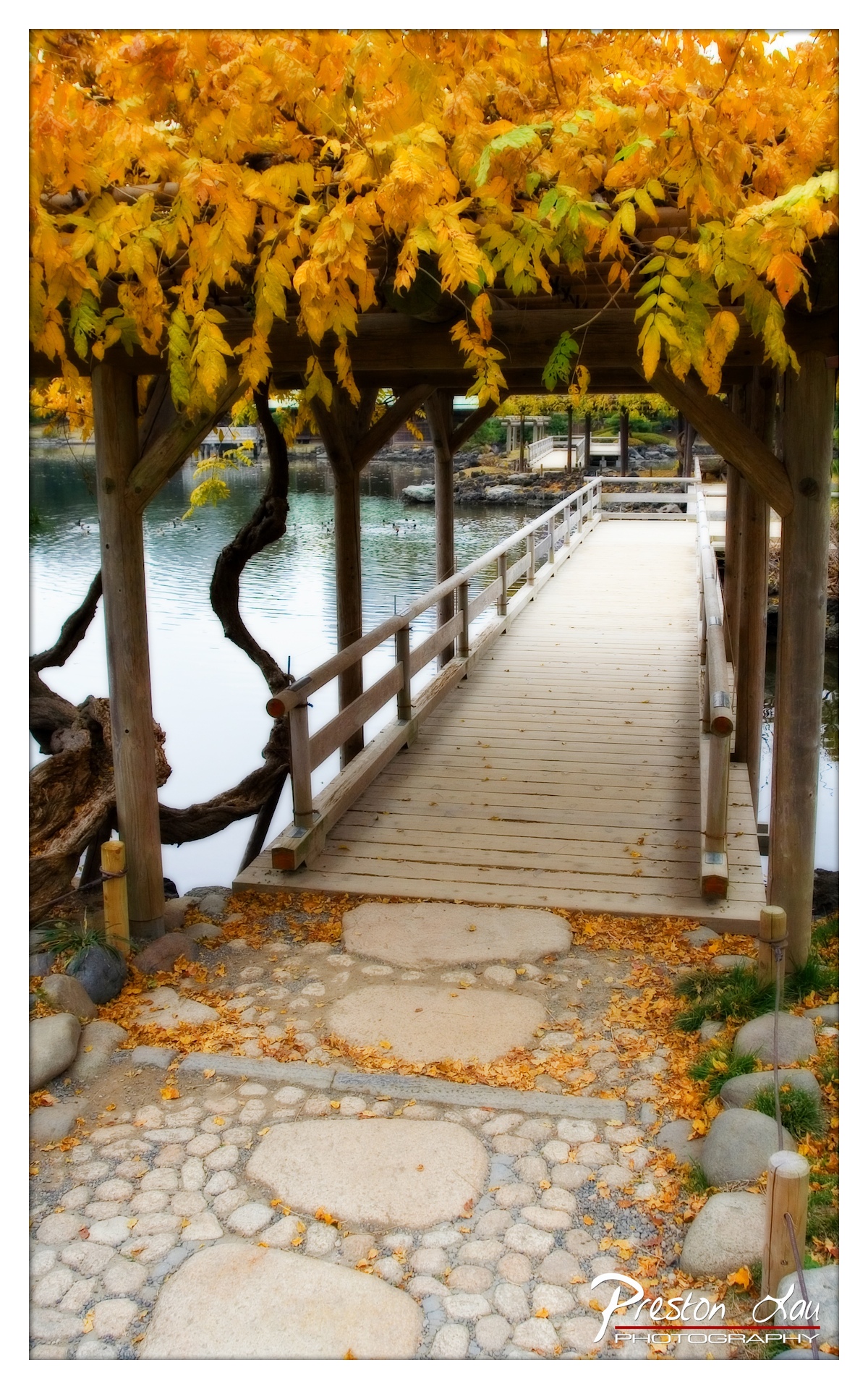

1. Overall Rating (0–10) — 8.0
This photograph captures the serene beauty of an autumnal garden, where the golden canopy of leaves creates a natural archway over a tranquil wooden bridge. The rich fall colors and peaceful setting evoke a sense of quiet contemplation, enhanced by the harmonious blend of organic textures and the gentle curve of the path. While the composition is strong and evocative, the vividness of the color saturation slightly overshadows the natural subtlety of the scene, lending it a subtly artificial sheen.
2. Composition (0–10) — 8.5
The bridge serves as a powerful leading line, drawing the eye into the frame with balanced symmetry and depth. The overhead foliage creates a natural frame, enhancing focus on the path and the calm water beyond. The placement of the stepping stones in the foreground grounds the image, offering a sense of arrival and journey.
3. Lighting (0–10) — 7.5
Soft, diffused light enhances the golden tones of the autumn leaves and reflects gently on the water, creating a warm and inviting mood. The even illumination minimizes harsh shadows, allowing details in both the foreground and background to remain visible and cohesive.
4. Color & Tone (0–10) — 9.0
The palette is rich and harmonious, dominated by warm yellows and golds that evoke the peak of fall. The contrast between the vibrant foliage and the neutral tones of the wood and stone enhances visual interest, while the subtle coolness of the water provides a grounding counterpoint.
5. Creativity (0–10) — 8.0
The image presents a familiar subject—autumn in a garden—with a fresh, immersive perspective. The use of the arched canopy as a framing device adds a narrative quality, inviting the viewer to step into the scene. The photographer’s attention to seasonal detail elevates the image beyond mere documentation into a poetic interpretation.
6. Technical Quality (0–10) — 8.5
Sharp focus throughout the frame ensures clarity in both the foreground and background. The image is well-exposed, with balanced highlights and shadows, and the fine detail in the leaves, wood grain, and stone is rendered with precision.
7. Emotional Impact (0–10) — 8.5
The photograph evokes a deep sense of peace and nostalgia, capturing the fleeting beauty of autumn. The quiet stillness of the scene and the inviting path inspire reflection and a longing for quiet moments in nature, creating a strong emotional resonance.
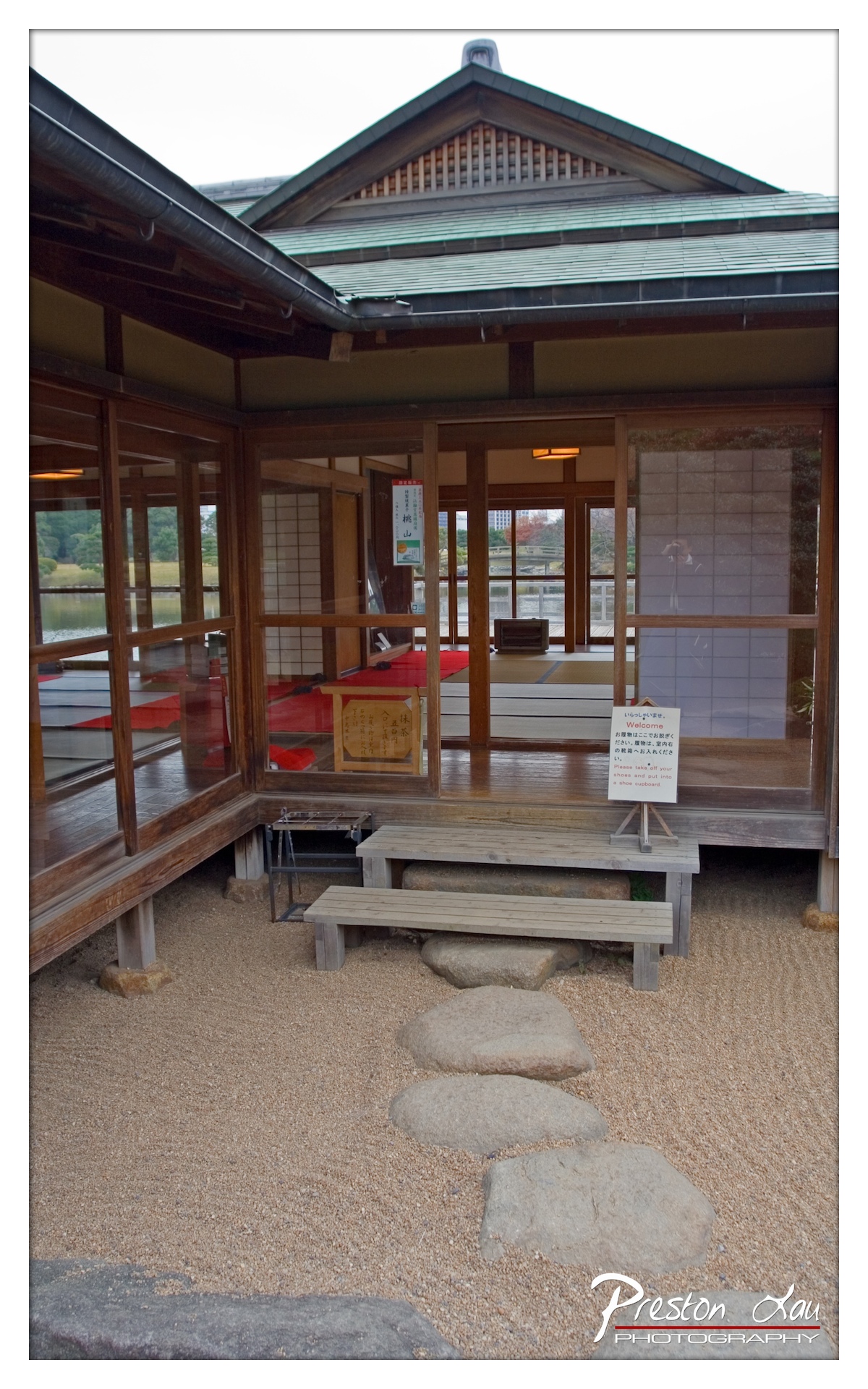

1. Overall Rating (0–10) — 7.0
This photograph captures the serene essence of a traditional Japanese tea house, where architecture and nature converge in quiet harmony. The composition balances the structured lines of the wooden structure with the organic flow of the gravel garden and stepping stones, creating a sense of calm and ritual. While the overcast sky mutes the scene’s vibrancy, the image succeeds in conveying the contemplative atmosphere of the space, with its thoughtful details and cultural authenticity standing as its greatest strength.
2. Composition (0–10) — 7.5
The framing centers the entrance, drawing the eye toward the interior through the open doorway, while the stone path and benches create leading lines that guide the viewer into the scene. The inclusion of the sign and foreground elements adds depth and context without disrupting the balance.
3. Lighting (0–10) — 6.0
The diffused, overcast light softens shadows and evenly illuminates the scene, which enhances the tranquil mood but reduces contrast and visual drama. The light lacks warmth, giving the image a slightly flat appearance.
4. Color & Tone (0–10) — 6.5
The palette is subdued, dominated by earthy browns, beige gravel, and muted greens, reflecting the natural materials of the setting. While harmonious, the lack of color saturation slightly dampens the image’s visual impact.
5. Creativity (0–10) — 7.0
The photographer captures a moment of cultural authenticity with a clear intent to document the space’s function and atmosphere. The inclusion of the welcome sign adds narrative depth, suggesting a story of hospitality and tradition.
6. Technical Quality (0–10) — 8.0
The image is sharp and well-focused, with clear detail in the wood grain, gravel texture, and signage. The exposure is balanced, and the depth of field appropriately captures both foreground and background elements.
7. Emotional Impact (0–10) — 7.5
The image evokes a sense of peace and introspection, inviting the viewer to imagine stepping into the quiet space and participating in a traditional tea ceremony. Its emotional resonance lies in its authenticity and the quiet dignity of the setting.
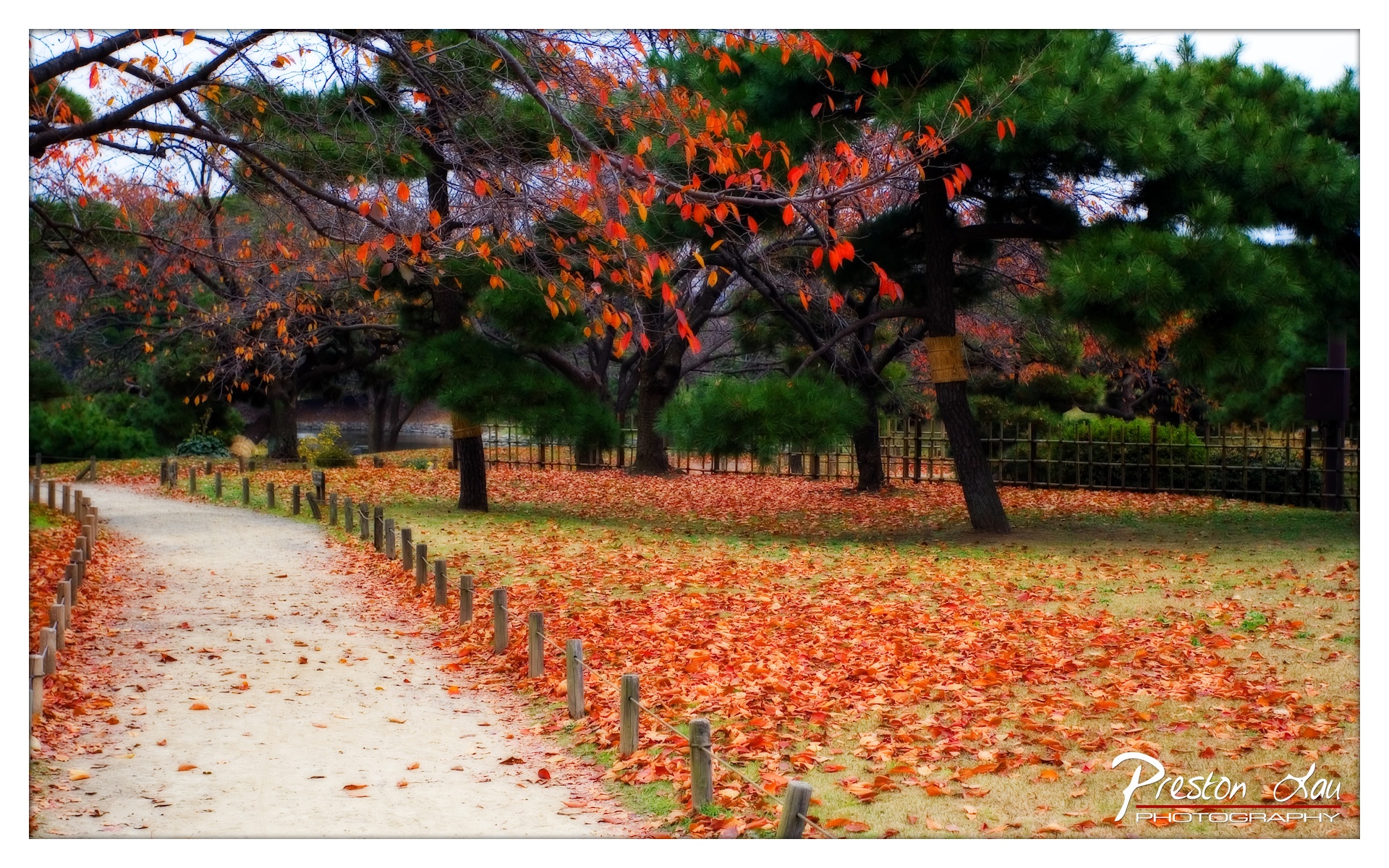

1. Overall Rating (0–10) — 7.5
This photograph captures the serene beauty of a Japanese garden in autumn, where the vibrant orange foliage contrasts strikingly with the evergreen pines. The rich saturation and layered composition evoke a sense of peaceful contemplation, though the heavy post-processing slightly diminishes the natural subtlety of the scene. The image succeeds in conveying seasonal transition with emotional warmth and visual richness.
2. Composition (0–10) — 7.0
The winding path draws the eye into the frame, creating a natural leading line that guides the viewer through the layered landscape. The placement of trees and the low fence adds depth, while the balance between the foreground and background creates a harmonious, immersive scene.
3. Lighting (0–10) — 6.5
Soft, diffused daylight evenly illuminates the scene, minimizing harsh shadows and allowing the autumn colors to stand out. While the lighting is gentle and suitable for the mood, it lacks dramatic contrast, resulting in a slightly flat quality that could be enhanced with directional light.
4. Color & Tone (0–10) — 8.0
The color palette is bold and cohesive, with vivid oranges and deep greens creating a strong visual contrast. The warm tones dominate the frame, reinforcing the autumnal atmosphere, though some areas appear oversaturated, giving the image a slightly artificial glow.
5. Creativity (0–10) — 7.5
The photographer captures a classic seasonal motif with a strong sense of place and atmosphere. The choice to emphasize color and composition over realism reflects a personal artistic vision, transforming a familiar landscape into a more expressive, almost painterly interpretation.
6. Technical Quality (0–10) — 7.5
The image is sharp and well-focused, with clear detail in the leaves and textures of the path. The exposure is balanced, and the overall clarity is high, though the heavy color grading suggests aggressive post-processing that slightly compromises natural detail.
7. Emotional Impact (0–10) — 8.0
The scene evokes a deep sense of calm and nostalgia, inviting the viewer to pause and reflect. The abundance of fallen leaves and quiet path suggest stillness and the passage of time, creating a meditative and emotionally resonant experience.
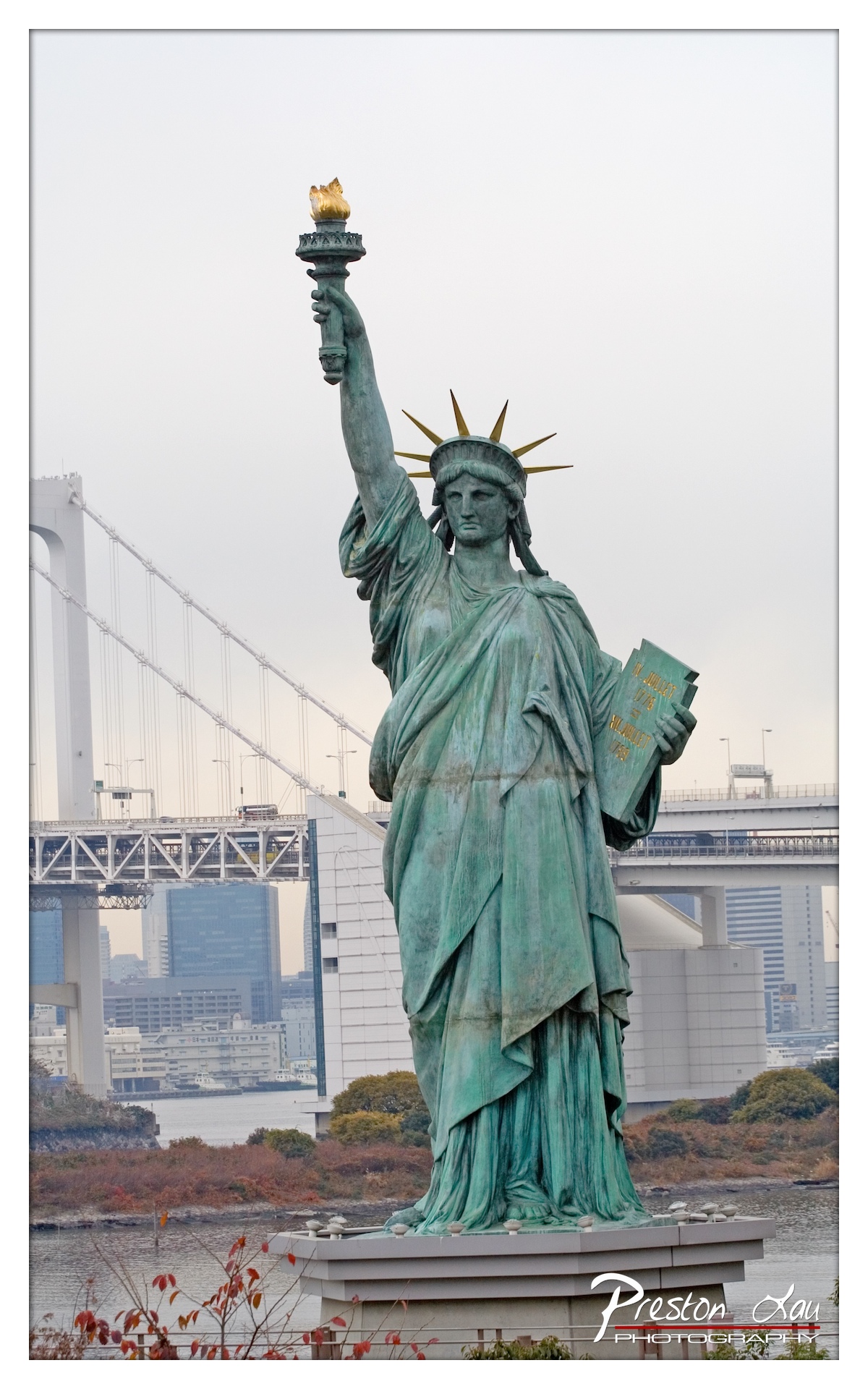

1. Overall Rating (0–10) — 7.0
This photograph captures a striking juxtaposition of cultural iconography and urban modernity, with the Statue of Liberty replica standing as a symbolic centerpiece against the backdrop of Tokyo’s Rainbow Bridge and cityscape. The image successfully conveys the contrast between the historic monument and its foreign setting, though the overcast sky tempers its emotional resonance. The composition is strong, but the muted lighting and slightly cluttered background prevent it from achieving a truly powerful visual impact.
2. Composition (0–10) — 7.0
The statue is well-centered and dominates the frame, drawing the viewer’s eye immediately. The inclusion of the bridge and cityscape adds depth and context, creating a layered narrative. The low-angle perspective enhances the monument’s stature, though the foreground foliage slightly distracts from the main subject.
3. Lighting (0–10) — 5.5
The diffused, overcast light flattens the image, reducing the texture and depth of the statue’s patina. While it ensures even exposure, the lack of strong directional light diminishes the dramatic effect of the golden torch and crown.
4. Color & Tone (0–10) — 6.5
The verdigris green of the statue contrasts subtly with the muted grays and whites of the urban backdrop. The golden accents of the torch and tablet provide focal points, but the overall palette is restrained and lacks vibrancy, reflecting the subdued atmospheric conditions.
5. Creativity (0–10) — 7.5
The image is conceptually compelling, highlighting the global reach of an iconic symbol. The placement of the replica in a non-American context adds an element of cultural commentary, making the photograph more than a mere travel snapshot—it suggests themes of globalization and identity.
6. Technical Quality (0–10) — 8.0
The image is sharp and well-focused, with clear details in the statue’s features and the surrounding structures. The exposure is balanced, and there is no noticeable noise, indicating strong technical execution despite the challenging lighting.
7. Emotional Impact (0–10) — 6.0
While the photograph evokes a sense of wonder and curiosity about cultural transplantation, the overcast weather and lack of dynamic light temper its emotional pull. The viewer is more likely to appreciate the concept than feel a deep emotional connection.
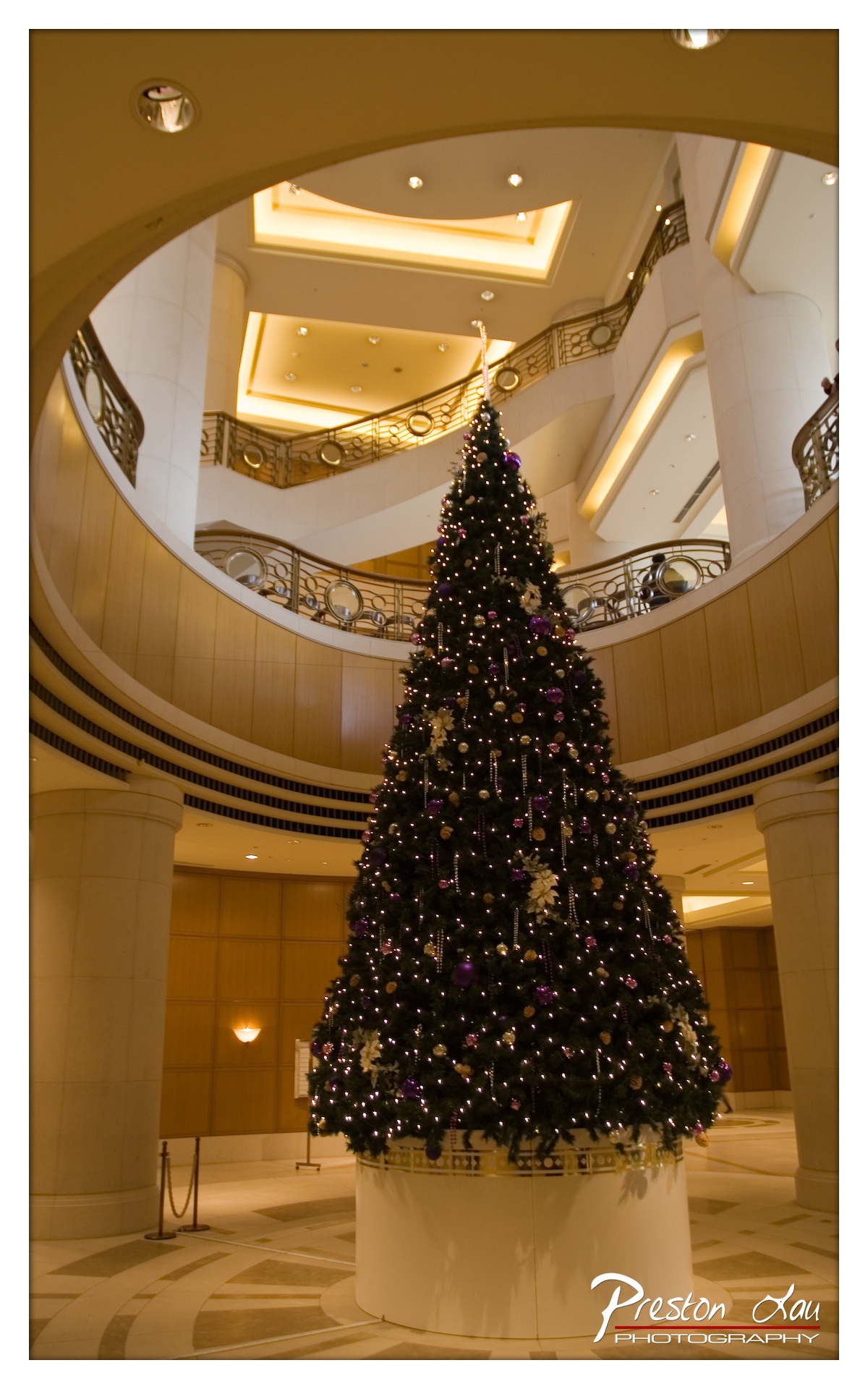

1. Overall Rating (0–10) — 7.5
This photograph captures the grandeur of a luxurious hotel lobby, centered on a majestic Christmas tree that draws the eye upward through the spiraling architecture. The warm, golden lighting enhances the festive atmosphere, creating a sense of elegance and celebration. While the composition is strong, the slightly cluttered foreground and overexposed highlights detract from the image’s overall refinement.
2. Composition (0–10) — 7.0
The tree is well-centered, drawing the viewer’s gaze through the circular frame of the archway. The spiral of the balconies adds dynamic movement, though the lower portion feels slightly unbalanced due to the visible stanchions.
3. Lighting (0–10) — 8.0
The warm, ambient lighting enhances the holiday mood, with soft overhead fixtures creating a glow that highlights the tree and architectural details. The use of natural light from the skylight adds depth, though some areas are slightly overexposed.
4. Color & Tone (0–10) — 7.5
The palette is rich with warm golds, deep purples, and soft whites, creating a harmonious and festive atmosphere. The contrast between the dark tree and the bright surroundings enhances visual interest.
5. Creativity (0–10) — 7.0
The perspective emphasizes both the scale of the space and the centerpiece, offering a unique view of holiday decor within a luxury setting. The photographer’s choice to frame through the archway adds a narrative layer.
6. Technical Quality (0–10) — 8.0
The image is sharp and well-focused, with clean detail in the tree and architectural elements. The exposure is generally well-managed, though some highlights in the ceiling show slight overexposure.
7. Emotional Impact (0–10) — 8.0
The photograph evokes a sense of warmth, celebration, and quiet wonder, capturing the spirit of the season in a refined, elegant setting. It invites the viewer into a moment of holiday magic.
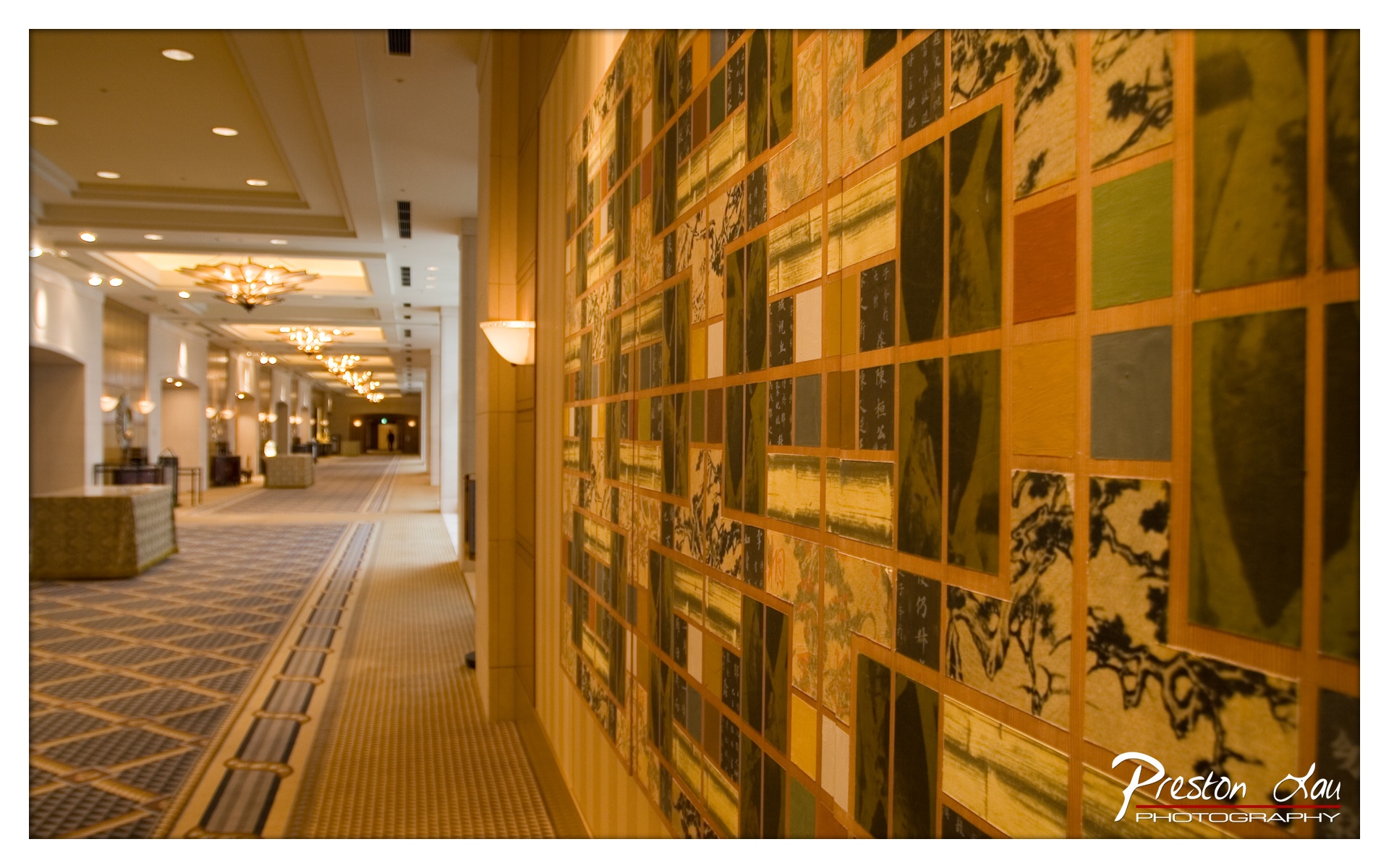

1. Overall Rating (0–10) — 7.5
This photograph captures the quiet elegance of a luxurious hotel corridor, where the warm glow of ambient lighting enhances the sense of refined stillness. The juxtaposition of the ornate, patterned wall against the long, receding hallway creates a compelling visual rhythm, inviting the viewer to wander deeper into the space. While the image succeeds in conveying atmosphere and sophistication, it is slightly held back by a lack of dynamic contrast and a somewhat generic sense of place.
2. Composition (0–10) — 8.0
The diagonal alignment of the wall and the carpet’s geometric pattern guide the eye naturally into the distance, creating a strong sense of depth. The framing emphasizes the architectural symmetry and the textured wall as a focal point, though the composition could benefit from a more intentional subject or point of interest to anchor the narrative.
3. Lighting (0–10) — 8.0
The warm, golden light from the chandeliers and wall sconces enhances the richness of the space, casting soft shadows that add dimension. The use of light creates a welcoming, intimate mood, and the gradual dimming into the distance effectively emphasizes perspective.
4. Color & Tone (0–10) — 7.5
The dominant warm tones—gold, amber, and muted greens—create a cohesive and harmonious palette that reinforces the opulent atmosphere. The tonal range is well-balanced, with subtle variations in hue that add depth without overwhelming the scene.
5. Creativity (0–10) — 7.0
The photograph demonstrates a strong sense of place and atmosphere, using architectural and decorative elements to tell a story of luxury and tradition. While the subject is not uncommon, the thoughtful use of light and composition elevates it beyond a simple documentation into a more evocative portrayal.
6. Technical Quality (0–10) — 8.0
The image is sharp and well-focused, with clean detail throughout the corridor and wall. The depth of field is used effectively to draw attention to the foreground while allowing the background to recede naturally, showcasing strong technical execution.
7. Emotional Impact (0–10) — 7.5
The photograph evokes a sense of calm and quiet grandeur, inviting contemplation and a feeling of being in a space of importance and refinement. The warmth and stillness resonate emotionally, suggesting a moment suspended in time.


1. Overall Rating (0–10) — 7.0
This photograph captures a festive outdoor scene with a layered arrangement of Christmas trees and a vibrant flower display, evoking a sense of seasonal cheer. The prominent "B'z" branding on the trees suggests a promotional or celebratory installation, grounding the image in a specific cultural context. While the composition is visually engaging and rich in detail, the overall mood feels slightly staged and lacks the emotional warmth that might come from human interaction or more dynamic lighting.
2. Composition (0–10) — 6.5
The arrangement of the trees creates a sense of depth, with the largest tree on the right drawing the eye, while the flower bed in the foreground adds balance. However, the white tables and chairs feel slightly intrusive, disrupting the natural flow of the scene. A tighter crop could enhance focus on the central elements.
3. Lighting (0–10) — 6.0
The lighting is soft and diffused, likely due to overcast conditions, which flattens the scene and reduces the vibrancy of the colors. While the lighting is even and avoids harsh shadows, it lacks the warmth and contrast that would elevate the festive mood.
4. Color & Tone (0–10) — 7.0
The combination of bright, multicolored ornaments on the trees and the vivid floral arrangement creates a lively palette. The greens of the trees, the reds and golds of the decorations, and the bright yellows and pinks of the flowers create a harmonious and celebratory contrast against the neutral tones of the building and pavement.
5. Creativity (0–10) — 6.5
The integration of commercial branding into a traditional holiday setting is an interesting conceptual choice, suggesting a blend of cultural celebration and corporate identity. While not particularly groundbreaking, the image successfully communicates a specific moment of festive public display.
6. Technical Quality (0–10) — 8.0
The image is sharp and well-focused, with clean details in both the foreground and background. The exposure is balanced, and there is minimal noise, indicating a high-quality capture. The photographer's control over technical aspects is evident.
7. Emotional Impact (0–10) — 6.5
The image evokes a sense of quiet celebration and civic festivity, but the absence of people or personal interaction keeps the emotional connection at a distance. The viewer is invited to observe rather than feel, making the impact more intellectual than heartfelt.
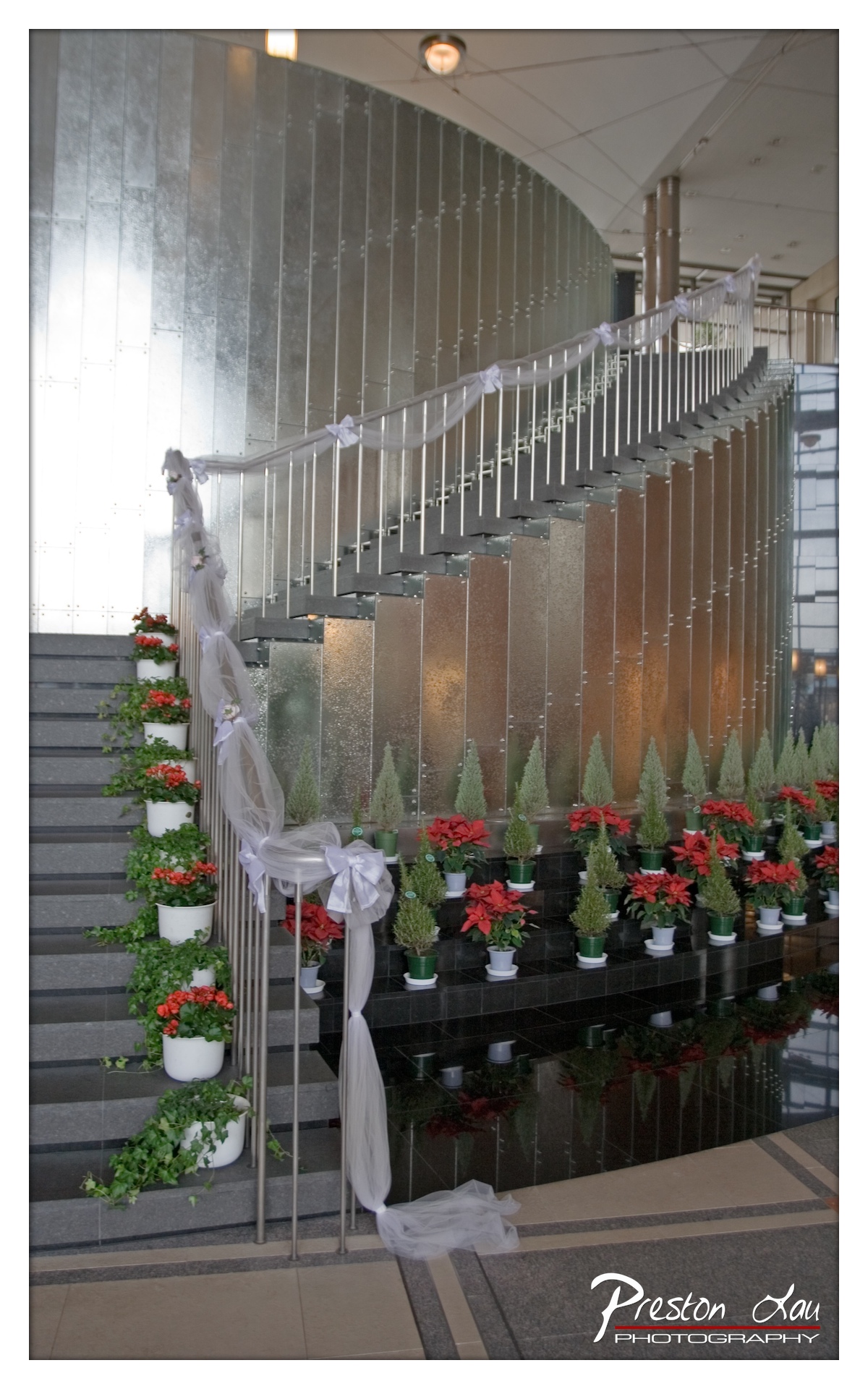

1. Overall Rating (0–10) — 7.0
This photograph captures a festive yet elegant transformation of a modern interior, where the sharp lines of a staircase are softened by delicate white ribbons and vibrant holiday greenery. The contrast between the industrial metallic surfaces and the organic warmth of potted plants creates a compelling visual dialogue, though the composition feels slightly cluttered and the lighting lacks depth. The image succeeds in conveying a celebratory mood, but it stops short of true artistic cohesion.
2. Composition (0–10) — 6.5
The diagonal sweep of the staircase draws the eye upward, but the dense arrangement of plants and ribbons on both the steps and landing creates visual noise. A more restrained use of decorative elements would enhance balance and clarity.
3. Lighting (0–10) — 6.0
The lighting is functional but flat, with overhead fixtures casting a neutral white glow that fails to emphasize texture or create mood. The reflections on the polished floor add some dimension, but the overall illumination feels sterile.
4. Color & Tone (0–10) — 7.0
The palette balances the cool metallic tones of the staircase with the warm reds and greens of the poinsettias and evergreens, creating a seasonal vibrancy. The white ribbons and pots provide contrast, though the overall tonal range is somewhat compressed.
5. Creativity (0–10) — 7.5
The juxtaposition of modern architecture with traditional holiday decor demonstrates thoughtful conceptual intent. The use of repetitive elements like the potted plants and ribbons creates rhythm, though the execution leans toward conventional rather than innovative.
6. Technical Quality (0–10) — 8.0
The image is sharp, with clean focus across the frame and well-managed exposure. The photographer maintains clarity in both the foreground and background, despite the complexity of the scene.
7. Emotional Impact (0–10) — 7.0
The photograph evokes a sense of celebration and warmth, particularly through the symbolic use of poinsettias and ribbons. While it doesn’t stir deep emotion, it successfully conveys a festive atmosphere appropriate for a public holiday display.
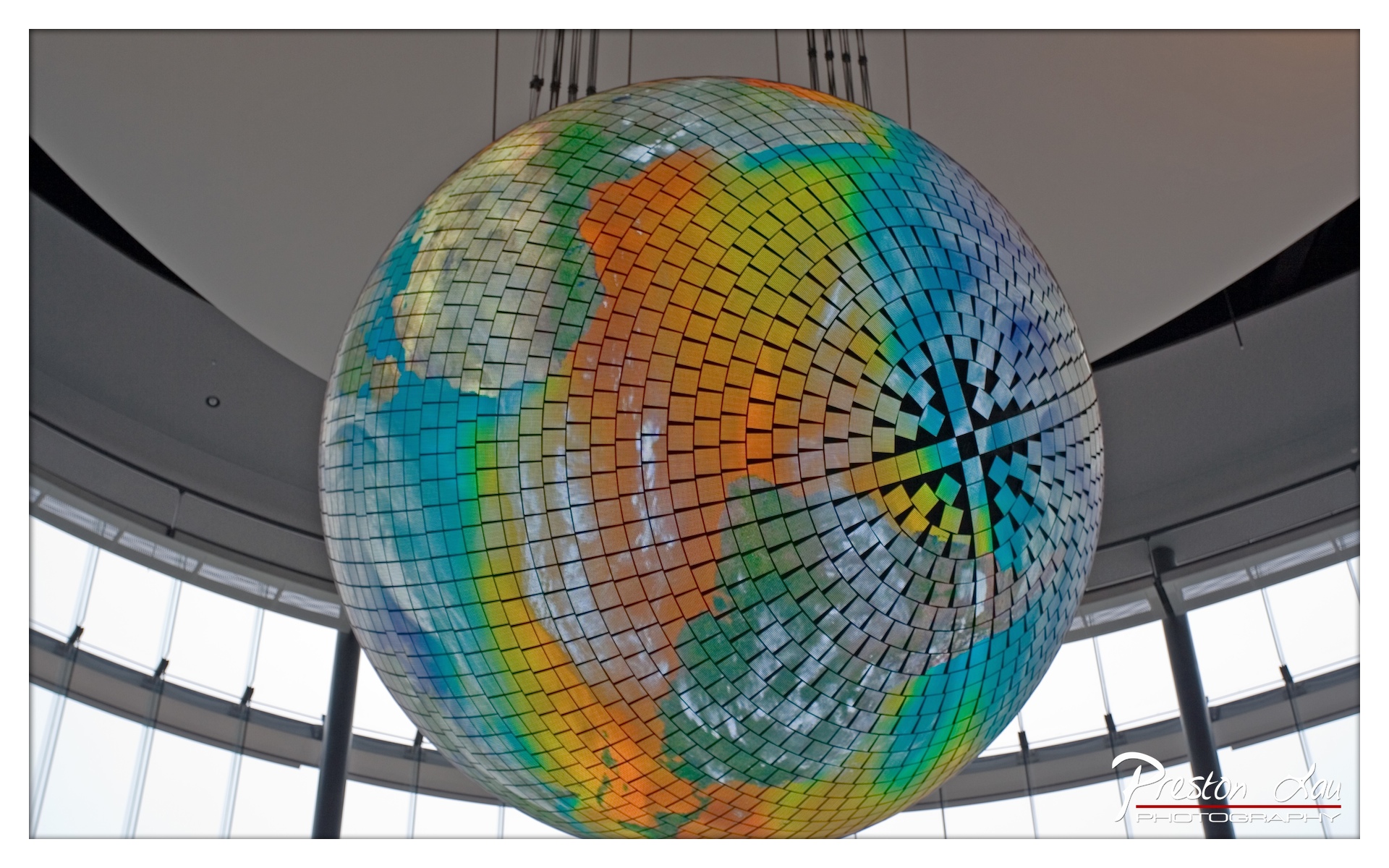

1. Overall Rating (0–10) — 7.5
This photograph captures the grandeur of a massive, mosaic-style globe suspended within a modern architectural space, evoking a sense of global unity and technological wonder. The vibrant, pixelated colors and symmetrical design draw the eye toward the center, creating a visually compelling focal point. While the image succeeds in showcasing the artwork’s scale and detail, the surrounding environment feels slightly underutilized, and the composition could better balance the subject with its context.
2. Composition (0–10) — 7.0
The low-angle perspective emphasizes the globe’s dominance, while the circular framing of the surrounding structure enhances its spherical form. The central placement of the globe is strong, though the visible ceiling and structural elements, while providing context, slightly distract from the subject’s visual harmony.
3. Lighting (0–10) — 7.5
Soft, diffused natural light from the large windows illuminates the globe evenly, highlighting the mosaic tiles without harsh glare. The subtle interplay of light and shadow across the curved surface adds depth and dimension, enhancing the tactile quality of the artwork.
4. Color & Tone (0–10) — 8.0
The palette is rich and dynamic, with vivid blues, greens, and warm oranges forming a lively, almost digital representation of Earth. The contrast between the bright, colorful globe and the neutral gray architecture enhances the subject’s visual impact, creating a striking tonal balance.
5. Creativity (0–10) — 8.0
The choice to capture this large-scale digital globe in a contemporary setting demonstrates a thoughtful blend of art, technology, and architecture. The perspective and framing emphasize the piece’s scale and intricate design, transforming a simple documentation into a visually engaging narrative about globalization and innovation.
6. Technical Quality (0–10) — 8.5
Sharp focus and high resolution capture the fine details of the mosaic tiles. The exposure is well-managed, with no significant overexposed or underexposed areas, and the clarity of the image supports the intricate textures of the artwork.
7. Emotional Impact (0–10) — 7.0
The image evokes a sense of awe and curiosity, inviting the viewer to contemplate the interconnectedness of the world. The scale and design of the globe inspire wonder, though the sterile architectural environment tempers the emotional resonance, keeping the viewer in a more observational, rather than deeply personal, space.


1. Overall Rating (0–10) — 7.5
This photograph presents a striking juxtaposition of organic form and mechanical precision, capturing a humanoid robot with its internal architecture exposed like a biological specimen. The low-angle perspective and dramatic lighting amplify its imposing presence, while the illuminated base grounds it in a sense of technological reverence. Though the image leans toward documentation, its strong visual narrative and technical clarity elevate it into a compelling exploration of artificial life.
2. Composition (0–10) — 7.0
The robot is centered and framed to emphasize its full structure, with the glowing base creating a strong visual anchor. The slight tilt adds dynamism, though the off-center arm placement introduces subtle imbalance.
3. Lighting (0–10) — 8.0
The lighting is deliberate and theatrical—warm backlighting and the glowing pedestal create a halo effect that draws attention to the robot’s intricate inner workings. The interplay of light and shadow enhances depth and texture.
4. Color & Tone (0–10) — 7.5
The palette is dominated by clean whites and metallic grays, punctuated by the green accent on the shoulder and the warm glow beneath. The contrast between cool mechanical tones and the ambient warmth adds emotional depth.
5. Creativity (0–10) — 8.0
The decision to expose the robot’s internal components transforms it from a mere machine into a conceptual artwork. The combination of form, lighting, and perspective evokes themes of transparency, evolution, and the soul of technology.
6. Technical Quality (0–10) — 8.5
The image is sharp and well-focused, with excellent detail visible in the mechanical components. The lighting is controlled and balanced, with no distracting overexposure or noise.
7. Emotional Impact (0–10) — 7.0
The photograph evokes a sense of awe and curiosity, inviting contemplation on the nature of consciousness and artificial intelligence. While emotionally restrained, it carries a quiet power through its visual storytelling.


1. Overall Rating (0–10) — 7.5
This photograph captures a striking interplay of geometric forms and architectural rhythm, where suspended leaf-like sculptures float against a backdrop of warm wood and cool glass. The composition draws the eye upward, emphasizing height and movement, while the clean lines and subtle color contrast lend a sense of calm precision. While the image is visually engaging, its emotional depth is slightly restrained by the clinical clarity of the lighting and the lack of human presence.
2. Composition (0–10) — 8.0
The diagonal arrangement of the suspended forms creates a dynamic flow, guiding the viewer’s gaze through the frame. The vertical wood slats and the glass panel provide strong structural lines that balance the organic shapes, resulting in a harmonious and well-structured composition.
3. Lighting (0–10) — 7.0
The light is evenly distributed and soft, enhancing the texture of the wood and the translucency of the white panels. While the lighting is clear and functional, it lacks dramatic shadows or highlights, slightly diminishing the atmospheric potential.
4. Color & Tone (0–10) — 7.5
The warm amber of the wood contrasts beautifully with the cool blue-green of the glass, creating a balanced and harmonious palette. The white of the suspended sculptures acts as a neutral bridge, allowing the colors to complement without clashing.
5. Creativity (0–10) — 8.0
The image demonstrates a strong conceptual vision, blending natural forms with modern architecture in a way that feels both intentional and poetic. The choice to focus on the interplay of materials and scale suggests a thoughtful artistic intent.
6. Technical Quality (0–10) — 8.5
The image is sharp and well-focused, with clean details visible in both the foreground and background. The exposure is accurate, and the lens choice effectively captures the verticality and depth of the space.
7. Emotional Impact (0–10) — 7.0
The photograph evokes a sense of serenity and order, inviting contemplation of space, light, and form. While it is aesthetically pleasing, the absence of human interaction limits its emotional resonance, leaving the scene feeling more like an architectural study than a deeply personal moment.
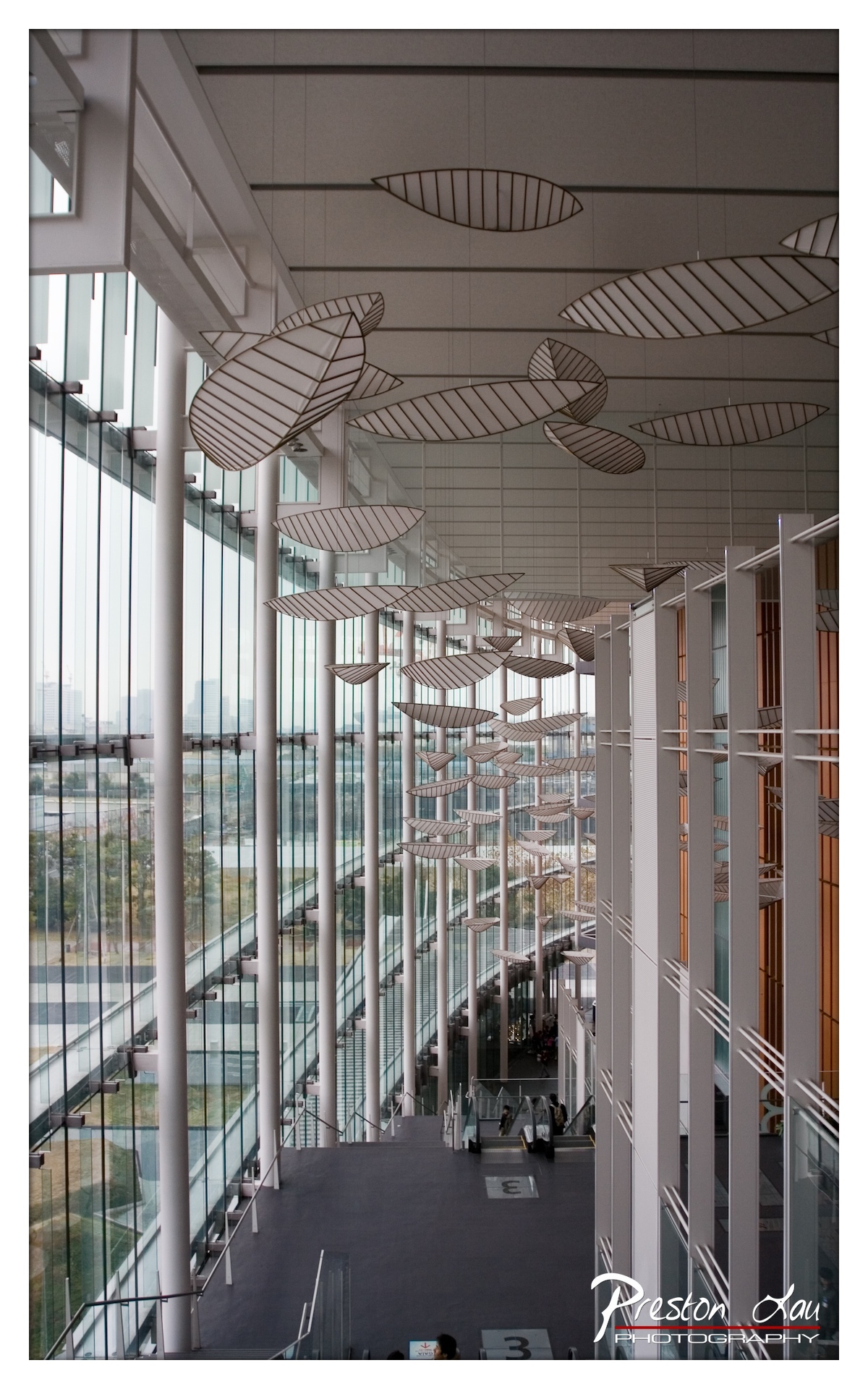

1. Overall Rating (0–10) — 7.0
This photograph captures the elegant interplay of architecture and art within a modern atrium, where suspended sculptural forms evoke a sense of movement and lightness. The clean lines of the glass and steel structure provide a strong visual anchor, while the abstract hanging elements add a layer of poetic complexity. Though the image is technically sound and compositionally balanced, its muted color palette and slightly overcast lighting temper its emotional resonance, leaving it more observational than transcendent.
2. Composition (0–10) — 7.5
The diagonal lines of the escalators and the upward sweep of the suspended forms create a dynamic sense of depth and rhythm. The framing effectively uses the verticality of the space to draw the eye through the scene, with the sculpture cluster serving as a compelling focal point.
3. Lighting (0–10) — 6.0
Natural light filters evenly through the glass walls, creating soft, diffused illumination that enhances the architectural clarity. However, the lack of strong directional light or dramatic shadows reduces the image’s visual drama and depth.
4. Color & Tone (0–10) — 6.5
The monochromatic palette of whites, grays, and muted metallics reinforces the contemporary, minimalist aesthetic. While harmonious, the subdued tones lend a cool, almost clinical atmosphere that could benefit from a touch of warmth or contrast.
5. Creativity (0–10) — 7.0
The integration of sculptural elements into the architectural space demonstrates thoughtful design and visual storytelling. The image succeeds in capturing the essence of modern public architecture as both functional and artistic, though it leans more toward documentation than conceptual innovation.
6. Technical Quality (0–10) — 8.0
Sharp focus and clean detail are evident throughout, with precise control over depth of field that highlights both the foreground sculpture and the distant cityscape. The exposure is well-balanced, with no significant loss of detail in highlights or shadows.
7. Emotional Impact (0–10) — 6.5
The photograph evokes a sense of calm and order, inviting contemplation of space and form. While it conveys the beauty of modern design, it stops short of stirring a deeper emotional response, remaining more cerebral than visceral.
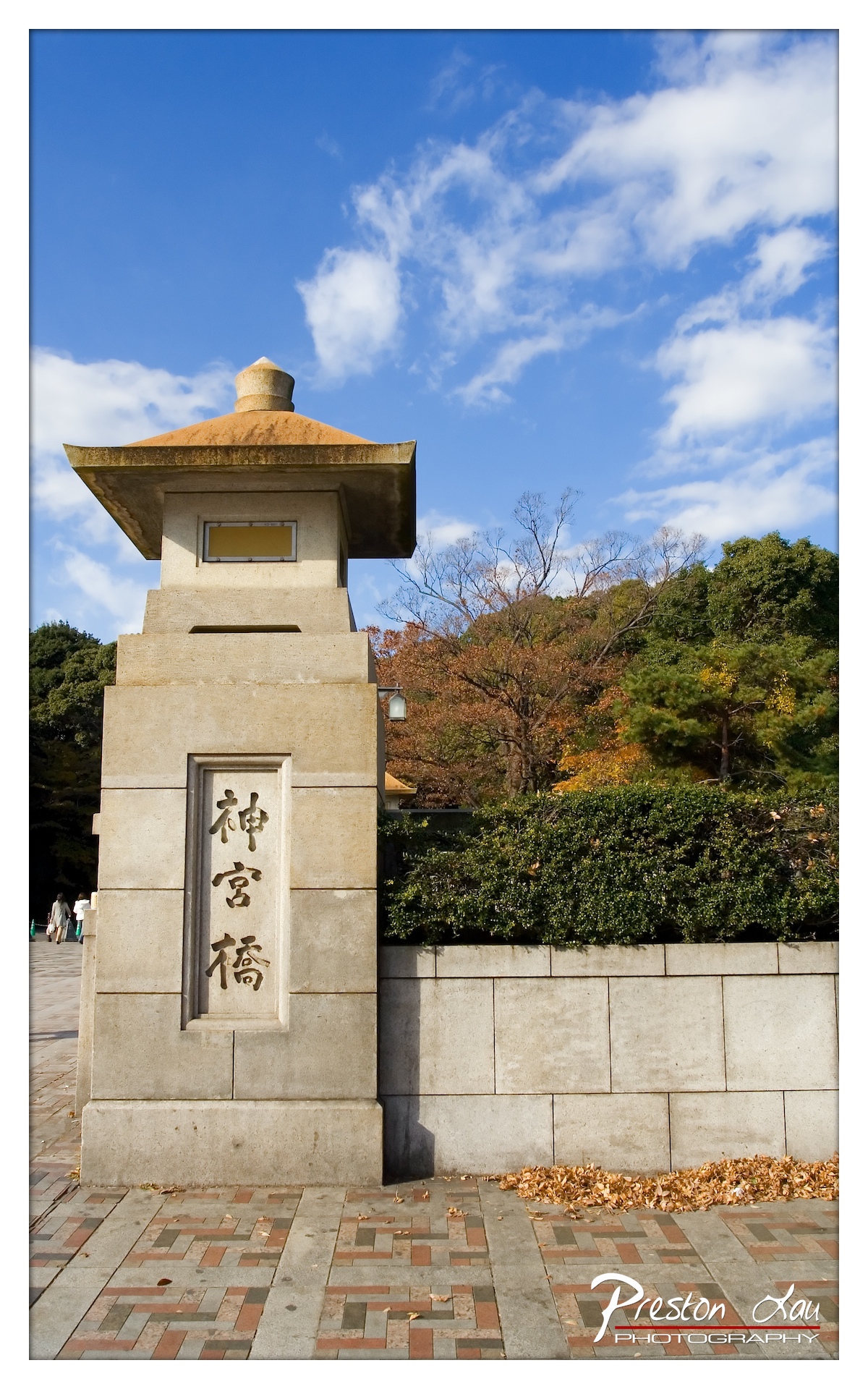

1. Overall Rating (0–10) — 8.0
This photograph captures the serene dignity of a traditional Japanese torii gate under a vast, cloud-dappled sky, evoking a sense of timelessness and reverence. The strong vertical lines of the stone structure contrast beautifully with the soft, dynamic clouds and the autumnal trees in the background, creating a harmonious balance between architecture and nature. While the composition is visually compelling, a slightly more deliberate framing might further emphasize the cultural significance of the site.
2. Composition (0–10) — 8.0
The low-angle perspective enhances the monumentality of the gate, while the diagonal path and scattered leaves draw the eye toward the structure. The balance between the solid form of the gate and the open sky creates a sense of depth and scale.
3. Lighting (0–10) — 9.0
Natural daylight illuminates the scene with soft, even light, highlighting the texture of the stone and the warmth of the autumn foliage. The contrast between the bright sky and the shaded base of the gate adds dimension and visual interest.
4. Color & Tone (0–10) — 8.0
The vibrant blue of the sky complements the earthy tones of the stone and fallen leaves, while the green and golden hues of the trees provide seasonal richness. The color palette is harmonious and enhances the tranquil mood.
5. Creativity (0–10) — 7.0
The image successfully captures a culturally significant site with a sense of reverence, but its approach is more documentary than interpretive. The photographer’s strength lies in composition and lighting rather than conceptual innovation.
6. Technical Quality (0–10) — 9.0
Sharp focus and precise detail throughout the frame demonstrate strong technical control. The exposure is well-balanced, and the image retains detail in both highlights and shadows.
7. Emotional Impact (0–10) — 8.0
The photograph evokes a quiet sense of awe and contemplation, inviting the viewer to reflect on tradition, nature, and the passage of time. The interplay of light, structure, and seasonal change creates a deeply resonant and peaceful atmosphere.
Loading map...